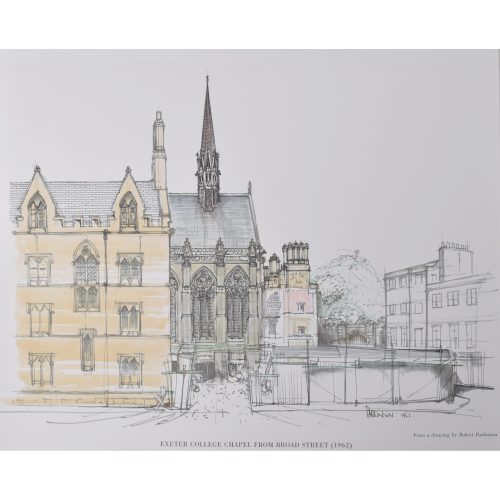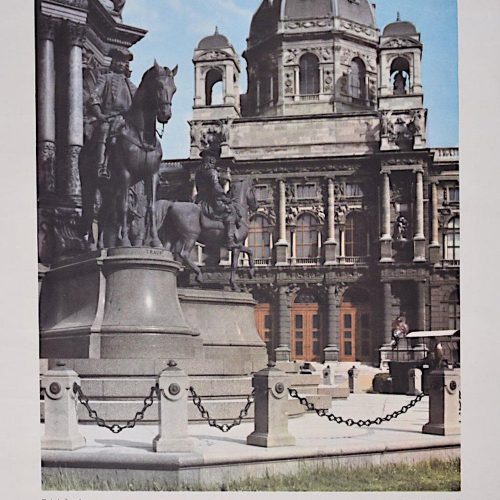-
Out of stock
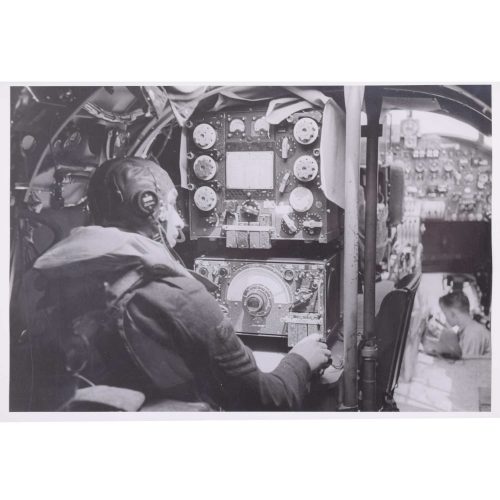
Charles E Brown
AVRO Lancaster bomber Radio Operator
Original Silver Gelatin photograph, c. 1944 Stamped to reverse 'Charles E Brown' with address etc. and serial number 14 x 21 cm Charles E Brown was a famous photographer of aircraft whose father was a butcher in Wimbledon, London. Young Charles was given a camera for his 14th birthday and in 1911 photographed an Edwardian gentleman in trouble landing his balloon in neighbouring Southfields. This photograph was published in the Daily Mirror – the fee being half a crown – and Brown was encouraged to join the Daily Mirror’s photography department upon leaving school at 16. Towards the end of the First World War he served with the Royal Air Force at their official London Photographic Centre. Following the war, he took to photographing trains, and captured a famous photograph of a Southern Railway locomotive that was used for the following ten years in railway posters. The income from this allowed him to pursue his passion of aviation photography in the 1920s and 1930s, from which commissions from the Air Ministry and Fleet Air Arm followed. During the war his work included commissions for Aeronautics magazine. Provenance: from the collection of Philip J R Moyes, author of many books on the RAF, most notably The Pictorial History which ran to several volumes. Condition: Very good -
Out of stock
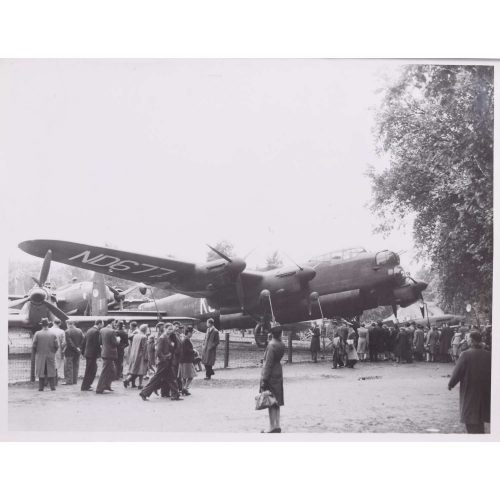
Lancaster bomber in Green Park
Original Silver Gelatin photograph, 1946 18 x 25 cm Stamped to reverse: "Photograph Supplied by The Topical Press Agency Ltd 20-21 Red Lion Court, Fleet Street" Press release label to reverse reads: "XH - RAF PLANES ON VIEW IN GREEN PARK, LONDON "In connection with the Victory Day celebrations in London, a number of RAF planes have been put on view in Green Park, London. "11/6/1946" Further typewritten note reads: "Lancaster B.III ND677/G KO-X of 115 Sqn. First Lancaster to have MONICA airborne tail warning device. Served with 460 Sqn RAAF, during 1944, went to 49 Sqn in April 1945 and finally to 113 Sqn in September 1945. Scrapped July 1946." ND677 was a veteran of 59 missions. The /G suffix - visible in the photograph - indicates that it must have an armed guard at all times. It was unceremoniously scrapped within a month of being on display to the crowds. Monica was a tail-borne radar device, designed to give the bomber crew warning of the approach of a German fighter in their blind spot. However following the crash in February 1943 of a Monica-equipped Lancaster (just seven days into Monica's operational life) the Germans developed equipment called 'Flensburg'. Introduced in early 1944 it was a homing device, a passive radar receiver which enabled Flensburg-equipped night fighters to locate Allied bombers. In July 1944 a Flensburg-equipped Junkers Ju88-G1 mistakenly landed at Woodbridge aerodrome in Suffolk, following which Monica was rapidly withdrawn from service. Condition: Generally very good. Provenance: from the collection of Philip J R Moyes, author of many books on the RAF, most notably The Pictorial History which ran to several volumes. -
Out of stock
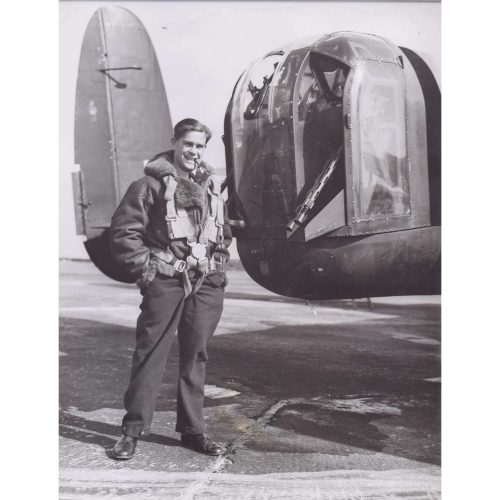
Roberts Dunstan DSO - Tail-end Charlie on Lancaster Bomber
Original Silver Gelatin photograph, c. 1943 20 x 15 cm The sitting-down war played out in the skies suited amputees who wanted to continue killing the enemy. Douglas Bader famously bailed out of his Spitfire over Germany, leaving behind his artificial legs. There were others who flew with artificial legs, including Dunstan. Dunstan was born in 1922, lying about his age (by three years) in order to join up in June 1940. In January 1941, serving with the Royal Australian Engineers, he was injured in one leg near Tobruk (in Libya) on a night reconnaisance raid. After five operations his leg was amputated; after ten more he was returned to Australia and invalided out of the services in February 1942. A few months later, he caught sight of a poster recruiting for the RAAF, and volunteered his services, enlisting on 23 June 1942 - having spent some time convincing the RAAF that there were roles that he could undertake successfully. Following training at the RAAF Bombing and Gunnery School he was soon on his way to the UK, sailing on 24 August from Sydney. He was soon serving at RAF Breighton in Yorkshire with 460 Sqn RAAF as rear gunner in an Avro Lancaster bomber. As he walked to the aircraft he used his crutches; onboard he would crawl to his post in the tail. On the night of 22/23 October 1943, aboard W4927, his Lancaster left Binbrook for a bombing raid over Germany. Above Kassel, the target, a Lancaster bomber above them dropped its bombs. Two incendiary bombs dropped through W4927; one hitting the flight engineer's jump seat - beside the pilot - the other falling through the middle of the aeroplane and severing the oxygen supply to the rear and mid-upper turrets - the former being Dunstan's. A German night fighter chose this moment to attack W4927. Befuddled by lack of oxygen the gunners were unable to shoot, W4927 losing its port elevator and receiving holes in its port wing and fuselage - and one cannon shell went into Dunstan's rear turret. However the pilot nursed the plane back to England, where it crash landed at either RAF Elsham Wold, or Bisham - sources vary. On 3/4 November 1943 Dunstan completed his thirtieth mission, to Dusseldorf, the day before his twenty-first birthday. He was gazetted for his DSO on 7 November. In 1944 he returned to Australia and in 1956 was elected to the Victoria State Parliament where he held ministerial posts for water supply, and subsequently for public works. -
Out of stock
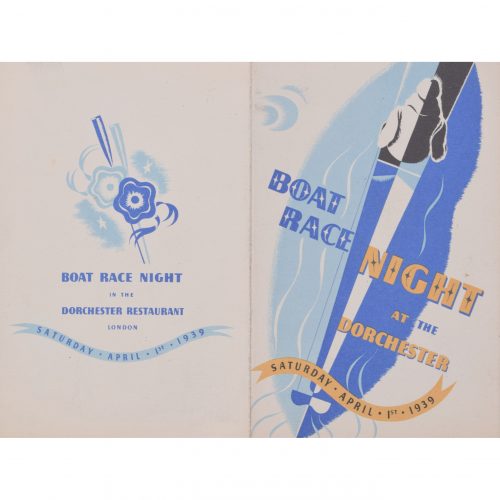
Brownbridge (flourished 1930s - 1940s)
Boat Race at the Dorchester (1939)
Lithographic brochure 15 x 19.5 cm From a small archive of works by Brownbridge, a member of the Society of Industrial Artists. A design for a poster advertising the Dorchester's dinner after the Oxford and Cambridge Boat Race. The artist has built his design around dark and light blues, to represent the colours of Oxford and Cambridge respectively. Brownbridge's design is marvellously 1930s, from the boldly decorative typeface to the whimsically glamorous guests and their waiters floating below the invitation. Boat Race dinners in London are rather different today; at any rate, prices are not normally advertised as 'excluding Wines and Cigars'. Society of Industrial Artists correspondance (photographed above) is not included; please enquire separately. Condition: generally very good. If you are interested, please email info@manningfineart.co.uk or call us on 07929 749056. Click here for other designs by Brownbridge. -
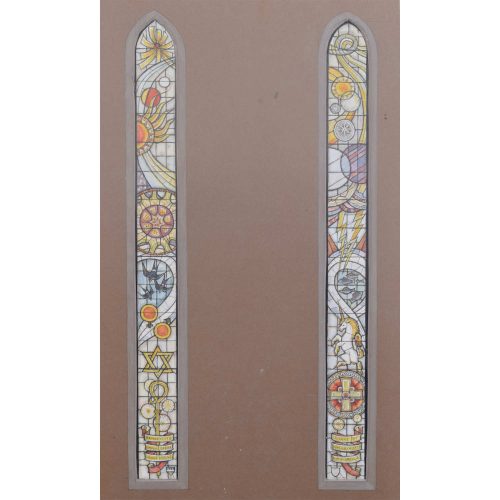
Jane Gray (b.1931)
St Peter’s Church, Martindale, Design for Benedicite Stained Glass Windows (1975-77)
Watercolour 32.5 x 8 cmSt Peter’s Church was built in Martindale, Cumbria in 1880 by a local craftsman using stone from the surrounding area. The church is situated in an enchanting rural oasis and has connections to the acclaimed modern poet, Kathleen Raine, who lived in the Old Vicarage, as well as William and Dorothy Wordsworth who visited the area on one of their Cumbrian excursions. Gray’s ‘Martindale Era’ lasted from 1974-1981, in which time, she designed and installed fifteen stained glass windows in St Peter’s Church. This pair of windows were commissioned as Gray was constructing her fifth, and supposedly last, window; the church had received a gift from an American donor who shared the name ‘Martindale’ and the vicar decided to commission two more windows on the them of the Benedicite.
Provenance: the artist’s studio sale. Literature: Jane Gray, Playing with Rainbows. (Shropshire: Ellingham Press, 2011), pp.17-18, 74. Condition: very good. If you are interested, please email info@manningfineart.co.uk or call us on 07929 749056. For other works by Jane Gray and more information about her, please click here. -
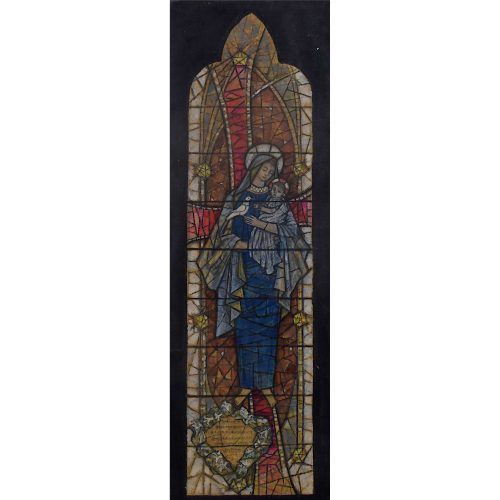
Jane Gray (b.1931)
Early Design for Stained Glass Memorial Window (1962)
Watercolour 27.5 x 9 cmA rare example of Gray’s early work, this design shows a more traditional approach to stained glass window design, something that Gray came to eschew in favour of a more modern style in much of her later work. This design was for a memorial window commemorating Rosemary Anstice, although its intended location is unknown.
Provenance: the artist’s studio sale. Condition: very good. If you are interested, please email info@manningfineart.co.uk or call us on 07929 749056. For other works by Jane Gray and more information about her, please click here. -
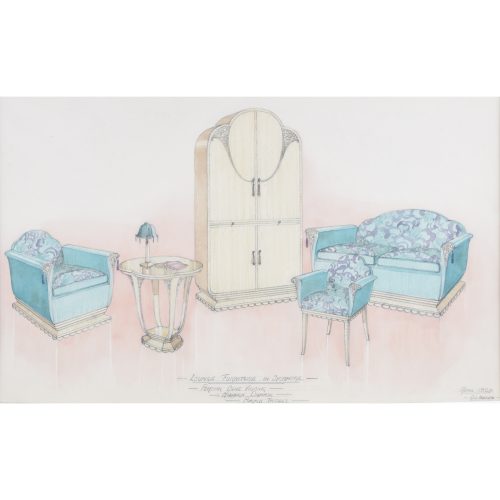
D L Hadden
Design for Lounge Furniture in Sycamore (1929)
Pencil and watercolour 29x49cm For biographical details and other works by the artist click here. If you are interested email info@manningfineart.co.uk or call us on 07929 749056. -
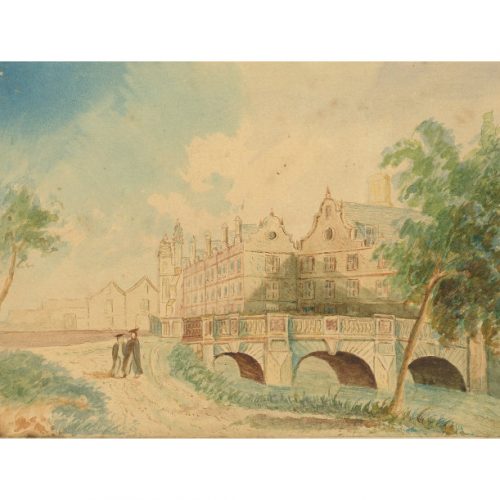
St John’s College, Cambridge
Watercolour and pencil 13x18cm Probably early 19th century. This watercolour depicts St John's prior to construction of Hutchinson's 1831 New Court buildings; two figures wearing gowns and square caps are engaged in conversation by the Wren Bridge. If you are interested email info@manningfineart.co.uk or call us on 07929 749056. -
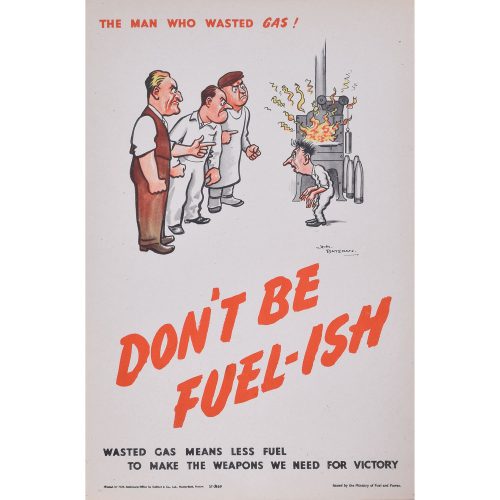
H. M.Bateman
Don't be Fuel-ish (the man who wasted gas)
Lithographic poster c.1940 For HMSO by Chromoworks. Ministry of Fuel & Power 38x26cm If you are interested email info@manningfineart.co.uk or call us on 07929 749056. -
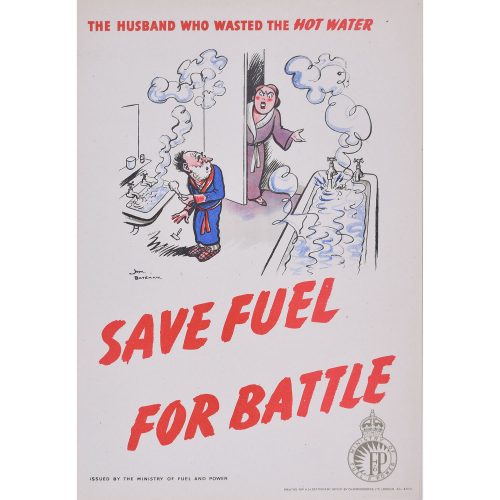
H. M. Bateman (1887-1970)
Save Fuel for Battle (the husband who wasted the hot water)
Lithographic poster c. 1940 For HMSO by Chromoworks. Ministry of Fuel & Power 38x26cm If you are interested email info@manningfineart.co.uk or call us on 07929 749056. -

H. M. Bateman (1887-1970)
Don't be Fuel-ish (the man who wasted power)
Lithographic poster 38x26cm If you are interested email info@manningfineart.co.uk or call us on 07929 749056. -

H. M. Bateman
Don't be Fuel-ish (the man who would not close the doors)
Lithographic poster 38x26cm If you are interested email info@manningfineart.co.uk or call us on 07929 749056. -
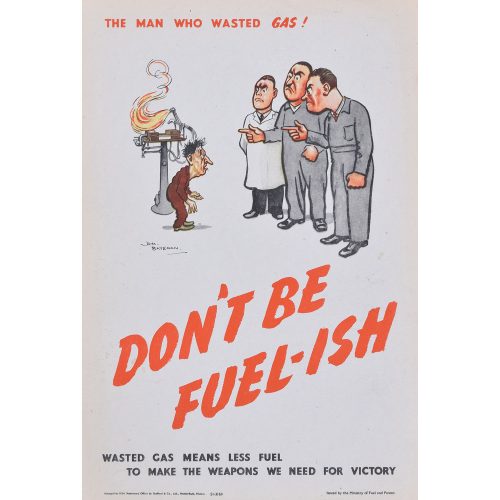
H. M. Bateman (1887-1970)
Don't be Fuel-ish (the Man who Wasted Gas II)
For HMSO by Chromoworks. Ministry of Fuel & Power Lithographic poster c. 1940 38x26cm If you are interested email info@manningfineart.co.uk or call us on 07929 749056. -
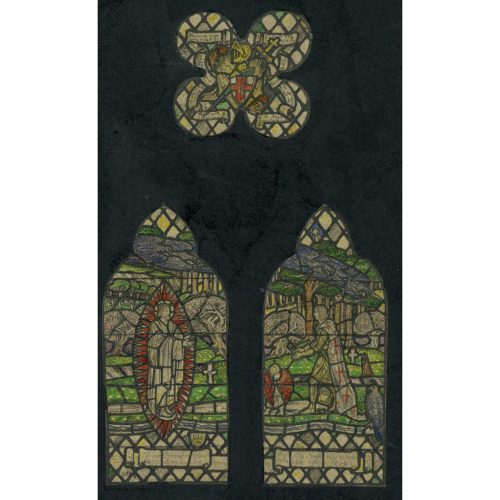
Florence Camm (1874-1960)
Arthurian Stained Glass Window Design II
Watercolour 16x9.5cm Design for TW Camm & Co., Smethwick, Birmingham. If you are interested email info@manningfineart.co.uk or call us on 07929 749056. -
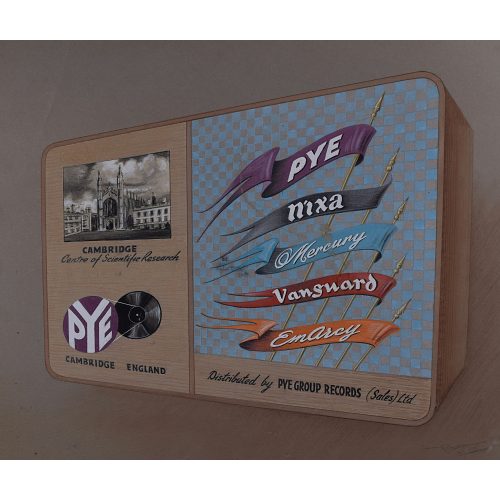
Bowens (British, fl. mid 20th Century) Cambridge: Centre of Scientific Research
Pye Group Records Pye - Nixa - Mercury - Vanguard - EmArcy c. mid-late 1950s Haig Road in Cambridge, where Pye had their factory, was subsumed into Elizabeth Way and was a long way from King's College chapel. However that iconic building is used to illustrate the Cambridge connection. EmArcy Records is a jazz record label founded in 1954 by Mercury Records. Mercury Record Corporation was founded in Chicago in 1945 Pye Records was a British record label; it had started life manufacturing televisions and radios, with its main plant off Haig Road in Cambridge. It purchased Nixa Records in 1953 Vanguard Records is a US record label set up in 1950 primarily as a classical label. If you are interested email info@manningfineart.co.uk or call us on 07929 749056. Condition: Good. -
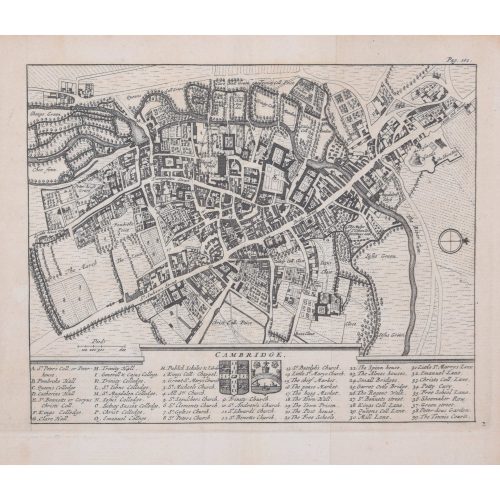
Pieter van der Aa (1659-1733), after David Loggan (1634–1692)
Map of Cambridge
Engraving (1727) 12 x 16 cm An eighteenth-century map of Cambridge engraved by Pieter van der Aa after David Loggan, the noted engraver, draughtsman, and painter who specialised in engravings of Oxford and Cambridge. Loggan's vision illustrates the inimitable layout of Cambridge; the River Cam, Bridge Street, and Trumpington Street bend across the map like arteries. Pieter van der Aa of Leiden was a Dutch publisher best known for preparing maps and atlases, though he also printed editions of foreign bestsellers and illustrated volumes. He is noted for the many engravings he produced after David Loggan's series of Oxford and Cambridge colleges and costumes. In 1727 Van Der Aa illustrated "Les Delices de la Grande Bretagne & de L'Irelande" by James Beeverell, the book in which this engraving appears. If you are interested, please email info@manningfineart.co.uk or call us on 07929 749056. -
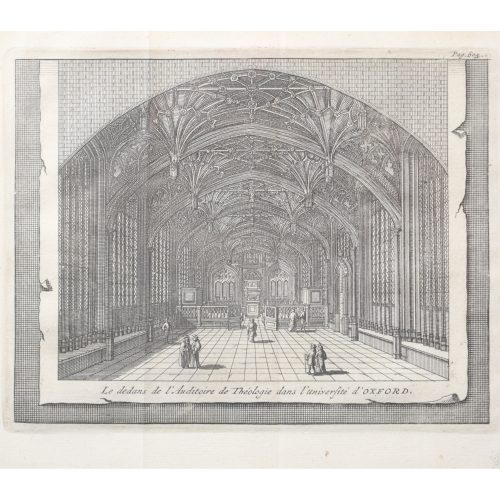
Pieter van der Aa (1659-1733), after David Loggan (1634–1692)
The Divinity School, University of Oxford
Engraving (1727) 12 x 16 cm An eighteenth-century view of Oxford's medieval Divinity School, which was once the beating heart of theological studies at the University. The scene is engraved by Pieter van der Aa after David Loggan, the noted engraver, draughtsman, and painter. Of particular interest here is the trompe l'oeil piece of torn paper which frames the Divinity School view. Pieter van der Aa of Leiden was a Dutch publisher best known for preparing maps and atlases, though he also printed editions of foreign bestsellers and illustrated volumes. He is noted for the many engravings he produced after David Loggan's series of Oxford and Cambridge colleges and costumes. In 1727 Van Der Aa illustrated "Les Delices de la Grande Bretagne & de L'Irelande" by James Beeverell, the book in which this engraving appears. Condition: a good impression. If you are interested, please email info@manningfineart.co.uk or call us on 07929 749056. -
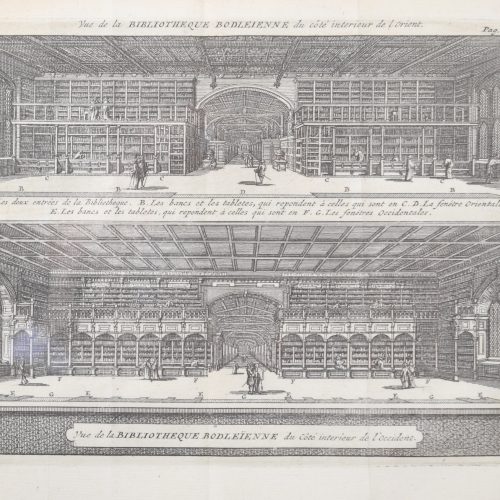
Pieter van der Aa (1659-1733), after David Loggan (1634–1692)
The Bodleian Library, University of Oxford
Engraving (1727) 12 x 16 cm An eighteenth-century view of the interior of the Bodleian Library, engraved by Pieter van der Aa after David Loggan, the noted engraver, draughtsman, and painter. Pieter van der Aa of Leiden was a Dutch publisher best known for preparing maps and atlases, though he also printed editions of foreign bestsellers and illustrated volumes. He is noted for the many engravings he produced after David Loggan's series of Oxford and Cambridge colleges and costumes. In 1727 Van Der Aa illustrated "Les Delices de la Grande Bretagne & de L'Irelande" by James Beeverell, the book in which this engraving appears. Condition: a good impression. If you are interested, please email info@manningfineart.co.uk or call us on 07929 749056. -
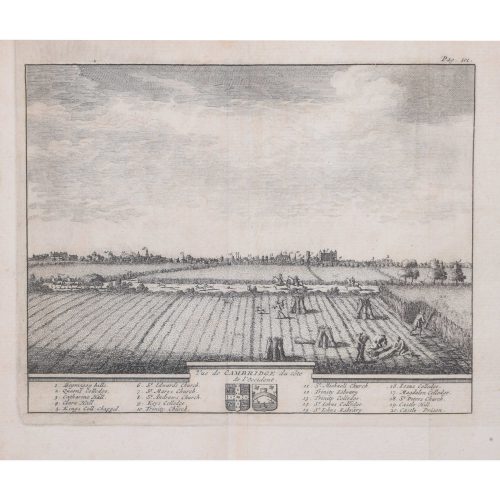
Pieter van der Aa (1659-1733), after David Loggan (1634–1692)
Cambridge from the East (1727)
Engraving 12 x 16 cm An eighteenth-century view of Cambridge from the East, engraved by Pieter van der Aa after David Loggan, the noted engraver, draughtsman, and painter who specialised in engravings of Oxford and Cambridge. A wide Cambridgeshire sky opens out over the harvest scene; in the background, the spires of the city's skyline are numbered, and identified below. A fascinating engraving which muses on the relationship between the city and its University. Pieter van der Aa of Leiden was a Dutch publisher best known for preparing maps and atlases, though he also printed editions of foreign bestsellers and illustrated volumes. He is noted for the many engravings he produced after David Loggan's series of Oxford and Cambridge colleges and costumes. In 1727 Van Der Aa illustrated "Les Delices de la Grande Bretagne & de L'Irelande" by James Beeverell, the book in which this engraving appears. Condition: generally very good. If you’d like to know more, please email info@manningfineart.co.uk or call us on 07929 749056. -

Pieter van der Aa (1659-1733), after David Loggan (1634–1692)
Balliol College, Oxford (1727)
Engraving 12 x 16 cm An eighteenth-century view of Balliol, engraved by Pieter van der Aa after David Loggan, the noted engraver, draughtsman, and painter who specialised in engravings of Oxford and Cambridge. Pieter van der Aa of Leiden was a Dutch publisher best known for preparing maps and atlases, though he also printed editions of foreign bestsellers and illustrated volumes. He is noted for the many engravings he produced after David Loggan's series of Oxford and Cambridge colleges and costumes. In 1727 Van Der Aa illustrated "Les Delices de la Grande Bretagne & de L'Irelande" by James Beeverell, the book in which this engraving appears. Condition: a good impression; trimmed just onto platemark on left side. If you’d like to know more, please email info@manningfineart.co.uk or call us on 07929 749056. -
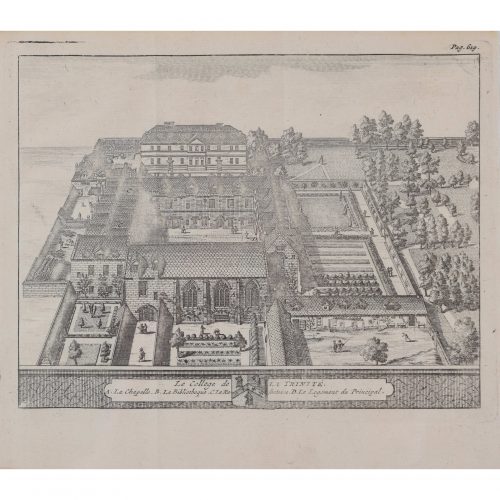
Pieter van der Aa (1659-1733), after David Loggan (1634–1692)
Trinity College, Oxford (1727)
Engraving 12 x 16 cm An eighteenth-century view of Trinity College, engraved by Pieter van der Aa after David Loggan, the noted engraver, draughtsman, and painter who specialised in engravings of Oxford and Cambridge. Pieter van der Aa of Leiden was a Dutch publisher best known for preparing maps and atlases, though he also printed editions of foreign bestsellers and illustrated volumes. He is noted for the many engravings he produced after David Loggan's series of Oxford and Cambridge colleges and costumes. In 1727 Van Der Aa illustrated "Les Delices de la Grande Bretagne & de L'Irelande" by James Beeverell, the book in which this engraving appears. Condition: a good impression. If you’d like to know more, please email info@manningfineart.co.uk or call us on 07929 749056. -
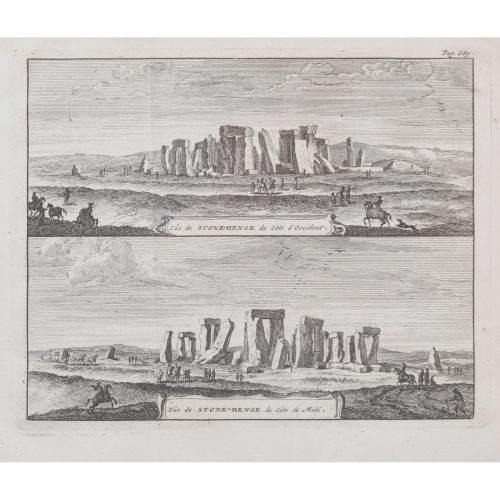
Pieter van der Aa (1659-1733), after David Loggan (1634–1692)
Stonehenge (1727)
Engraving 12 x 16 cm Two eighteenth-century views of the pagan and mystical Stonehenge, engraved by Pieter van der Aa after David Loggan, the noted engraver, draughtsman, and painter. Pieter van der Aa of Leiden was a Dutch publisher best known for preparing maps and atlases, though he also printed editions of foreign bestsellers and illustrated volumes. He is noted for the many engravings he produced after David Loggan's series of Oxford and Cambridge colleges and costumes. In 1727 Van Der Aa illustrated "Les Delices de la Grande Bretagne & de L'Irelande" by James Beeverell, the book in which this engraving appears. Condition: a good impression. If you’d like to know more, please email info@manningfineart.co.uk or call us on 07929 749056. -
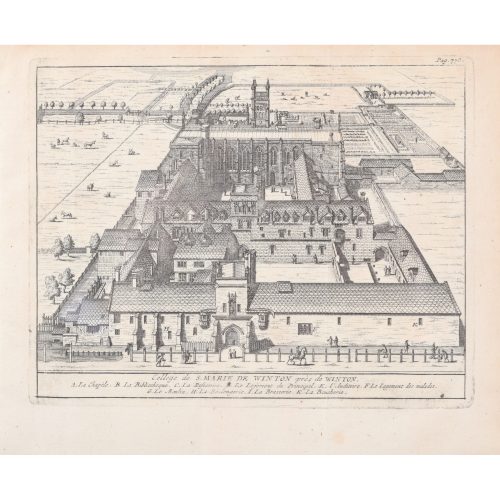
Pieter van der Aa (1659-1733), after David Loggan (1634–1692)
Winchester College, or "Le College de St Marie de Winton" (1727)
Engraving 12 x 16 cm An eighteenth-century view of Winchester College, engraved by Pieter van der Aa after David Loggan, the noted engraver, draughtsman, and painter. Pieter van der Aa of Leiden was a Dutch publisher best known for preparing maps and atlases, though he also printed editions of foreign bestsellers and illustrated volumes. He is noted for the many engravings he produced after David Loggan's series of Oxford and Cambridge colleges and costumes. In 1727 Van Der Aa illustrated "Les Delices de la Grande Bretagne & de L'Irelande" by James Beeverell, the book in which this engraving appears. Condition: a good impression. If you’d like to know more, please email info@manningfineart.co.uk or call us on 07929 749056. -
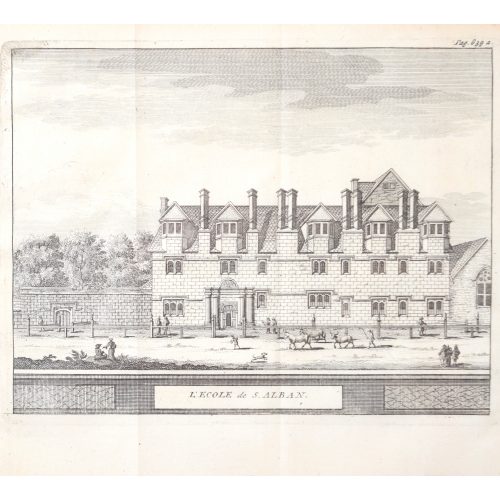
Pieter van der Aa (1659-1733), after David Loggan (1634–1692)
St Alban Hall, Oxford - now Merton College (1727)
Engraving 12 x 16 cm St Alban Hall, sometimes known as St Alban's Hall or Stubbins, was one of the medieval halls of the University of Oxford, and one of the longest-surviving. It was established in the 13th century and was acquired by neighbouring Merton College in the 16th century. The institutions formally merged in the late 19th century. The site in Merton Street, Oxford, is now occupied by Merton's Edwardian St Alban's Quad. Engraved by Pieter van der Aa after David Loggan, the noted engraver, draughtsman, and painter. Pieter van der Aa of Leiden was a Dutch publisher best known for preparing maps and atlases, though he also printed editions of foreign bestsellers and illustrated volumes. He is noted for the many engravings he produced after David Loggan's series of Oxford and Cambridge colleges and costumes. In 1727 Van Der Aa illustrated "Les Delices de la Grande Bretagne & de L'Irelande" by James Beeverell, the book in which this engraving appears. Condition: a good impression. If you’d like to know more, please email info@manningfineart.co.uk or call us on 07929 749056. -
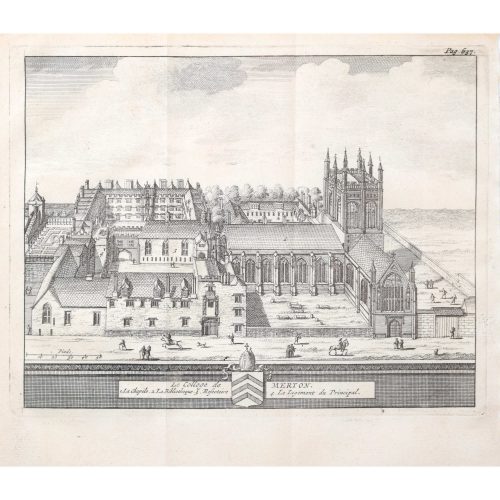
Pieter van der Aa (1659-1733), after David Loggan (1634–1692)
Merton College, Oxford (1727)
Engraving 12 x 16 cm An eighteenth-century view of Merton College, engraved by Pieter van der Aa after David Loggan, the noted engraver, draughtsman, and painter. Pieter van der Aa of Leiden was a Dutch publisher best known for preparing maps and atlases, though he also printed editions of foreign bestsellers and illustrated volumes. He is noted for the many engravings he produced after David Loggan's series of Oxford and Cambridge colleges and costumes. In 1727 Van Der Aa illustrated "Les Delices de la Grande Bretagne & de L'Irelande" by James Beeverell, the book in which this engraving appears. Condition: a good impression. If you’d like to know more, please email info@manningfineart.co.uk or call us on 07929 749056. -
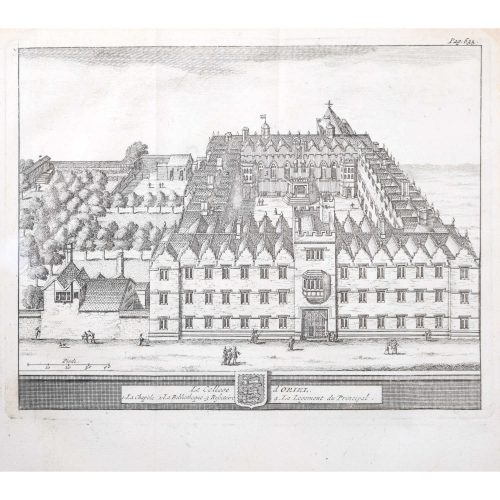
Pieter van der Aa (1659-1733), after David Loggan (1634–1692)
Oriel College, Oxford (1727)
Engraving 12 x 16 cm An eighteenth-century view of Oriel College, engraved by Pieter van der Aa after David Loggan, the noted engraver, draughtsman, and painter. Pieter van der Aa of Leiden was a Dutch publisher best known for preparing maps and atlases, though he also printed editions of foreign bestsellers and illustrated volumes. He is noted for the many engravings he produced after David Loggan's series of Oxford and Cambridge colleges and costumes. In 1727 Van Der Aa illustrated "Les Delices de la Grande Bretagne & de L'Irelande" by James Beeverell, the book in which this engraving appears. Condition: a good impression. If you’d like to know more, please email info@manningfineart.co.uk or call us on 07929 749056. -
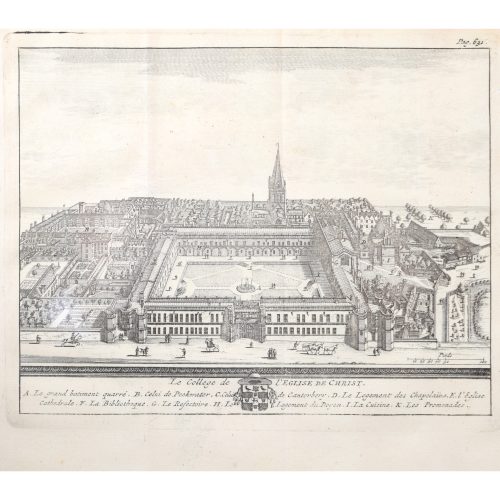
Pieter van der Aa (1659-1733), after David Loggan (1634–1692)
Christ Church, Oxford (1727)
Engraving 12 x 16 cm An eighteenth-century view of Christ Church, engraved by Pieter van der Aa after David Loggan, the noted engraver, draughtsman, and painter. Pieter van der Aa of Leiden was a Dutch publisher best known for preparing maps and atlases, though he also printed editions of foreign bestsellers and illustrated volumes. He is noted for the many engravings he produced after David Loggan's series of Oxford and Cambridge colleges and costumes. In 1727 Van Der Aa illustrated "Les Delices de la Grande Bretagne & de L'Irelande" by James Beeverell, the book in which this engraving appears. Condition: a good impression. If you’d like to know more, please email info@manningfineart.co.uk or call us on 07929 749056. -
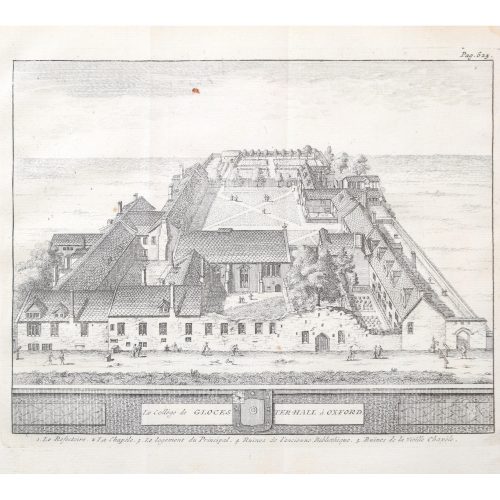
Pieter van der Aa (1659-1733), after David Loggan (1634–1692)
Gloucester College, Oxford (now Worcester College) (1727)
Engraving 12 x 16 cm An eighteenth-century view of Worcester College's predecessor, Gloucester College. Gloucester College was founded in 1283 by the Benedictine Abbey of St Peter at Gloucester as a place of study for 13 monks. The dissolution of the monasteries in the 1530s resulted in the closure of the College, which was eventually re-founded as Worcester College in 1714. Pieter van der Aa's engraving comes after an earlier one by David Loggan, the noted engraver, draughtsman, and painter, when the site was still known as Gloucester. Pieter van der Aa of Leiden was a Dutch publisher best known for preparing maps and atlases, though he also printed editions of foreign bestsellers and illustrated volumes. He is noted for the many engravings he produced after David Loggan's series of Oxford and Cambridge colleges and costumes. In 1727 Van Der Aa illustrated "Les Delices de la Grande Bretagne & de L'Irelande" by James Beeverell, the book in which this engraving appears. Condition: a good impression. If you’d like to know more, please email info@manningfineart.co.uk or call us on 07929 749056. -
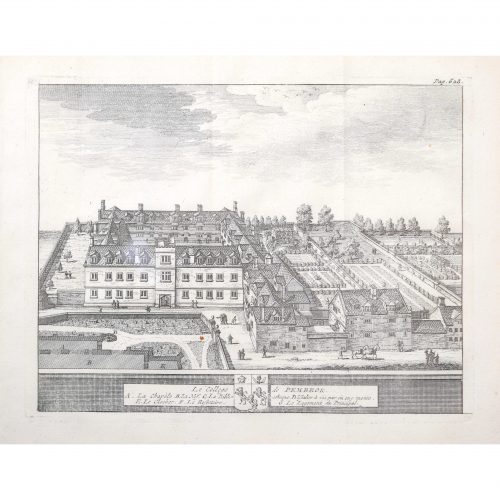
Pieter van der Aa (1659-1733), after David Loggan (1634–1692)
Pembroke College, Oxford (1727)
Engraving 12 x 16 cm An eighteenth-century view of Pembroke College, Oxford, engraved by Pieter van der Aa after an earlier one by David Loggan, the noted engraver, draughtsman, and painter. Pieter van der Aa of Leiden was a Dutch publisher best known for preparing maps and atlases, though he also printed editions of foreign bestsellers and illustrated volumes. He is noted for the many engravings he produced after David Loggan's series of Oxford and Cambridge colleges and costumes. In 1727 Van Der Aa illustrated "Les Delices de la Grande Bretagne & de L'Irelande" by James Beeverell, the book in which this engraving appears. Condition: a good impression. If you’d like to know more, please email info@manningfineart.co.uk or call us on 07929 749056. -
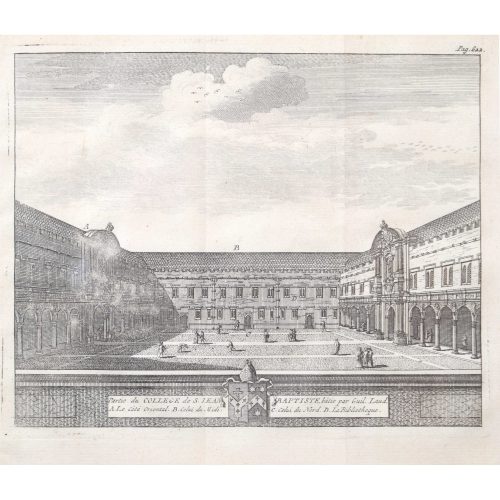
Pieter van der Aa (1659-1733), after David Loggan (1634–1692)
St John's College, Oxford (1727)
Engraving 12 x 16 cm An eighteenth-century view of Canterbury Quad, St John's, engraved by Pieter van der Aa after David Loggan, the noted engraver, draughtsman, and painter. Pieter van der Aa of Leiden was a Dutch publisher best known for preparing maps and atlases, though he also printed editions of foreign bestsellers and illustrated volumes. He is noted for the many engravings he produced after David Loggan's series of Oxford and Cambridge colleges and costumes. In 1727 Van Der Aa illustrated "Les Delices de la Grande Bretagne & de L'Irelande" by James Beeverell, the book in which this engraving appears. Condition: a good impression. If you’d like to know more, please email info@manningfineart.co.uk or call us on 07929 749056. -
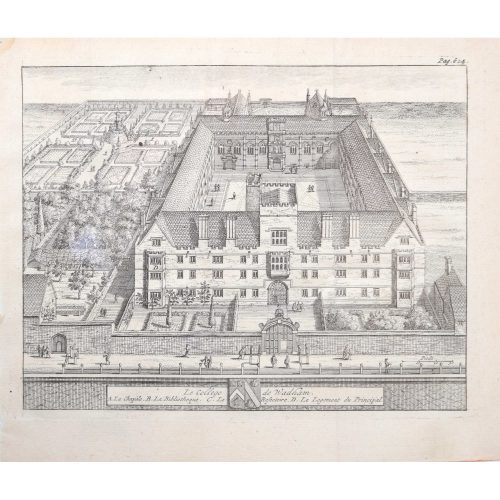
Pieter van der Aa (1659-1733), after David Loggan (1634–1692)
Wadham College, Oxford (1727)
Engraving 12 x 16 cm An eighteenth-century view of Wadham, engraved by Pieter van der Aa after David Loggan, the noted engraver, draughtsman, and painter. Pieter van der Aa of Leiden was a Dutch publisher best known for preparing maps and atlases, though he also printed editions of foreign bestsellers and illustrated volumes. He is noted for the many engravings he produced after David Loggan's series of Oxford and Cambridge colleges and costumes. In 1727 Van Der Aa illustrated "Les Delices de la Grande Bretagne & de L'Irelande" by James Beeverell, the book in which this engraving appears. Condition: a good impression. If you’d like to know more, please email info@manningfineart.co.uk or call us on 07929 749056. -
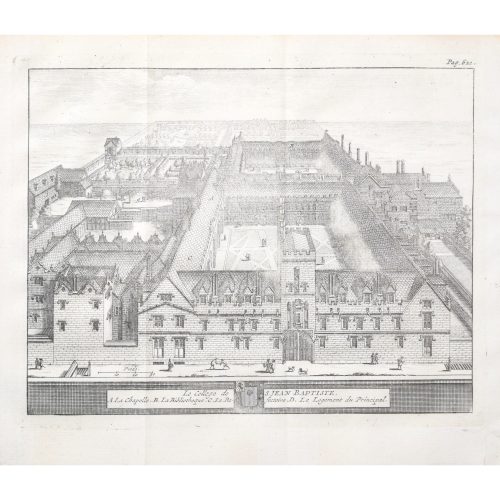
Pieter van der Aa (1659-1733), after David Loggan (1634–1692)
St John's College, Oxford (1727)
Engraving 12 x 16 cm An eighteenth-century view of St John's, engraved by Pieter van der Aa after David Loggan, the noted engraver, draughtsman, and painter. Pieter van der Aa of Leiden was a Dutch publisher best known for preparing maps and atlases, though he also printed editions of foreign bestsellers and illustrated volumes. He is noted for the many engravings he produced after David Loggan's series of Oxford and Cambridge colleges and costumes. In 1727 Van Der Aa illustrated "Les Delices de la Grande Bretagne & de L'Irelande" by James Beeverell, the book in which this engraving appears. Condition: a good impression. If you’d like to know more, please email info@manningfineart.co.uk or call us on 07929 749056. -

Pieter van der Aa (1659-1733), after David Loggan (1634–1692)
Brasenose College, Oxford (1727)
Engraving 12 x 16 cm An eighteenth-century view of 'Le Nez de Bronze', or Brasenose, engraved by Pieter van der Aa after David Loggan, the noted engraver, draughtsman, and painter. Pieter van der Aa of Leiden was a Dutch publisher best known for preparing maps and atlases, though he also printed editions of foreign bestsellers and illustrated volumes. He is noted for the many engravings he produced after David Loggan's series of Oxford and Cambridge colleges and costumes. In 1727 Van Der Aa illustrated "Les Delices de la Grande Bretagne & de L'Irelande" by James Beeverell, the book in which this engraving appears. Condition: a good impression. If you’d like to know more, please email info@manningfineart.co.uk or call us on 07929 749056. -
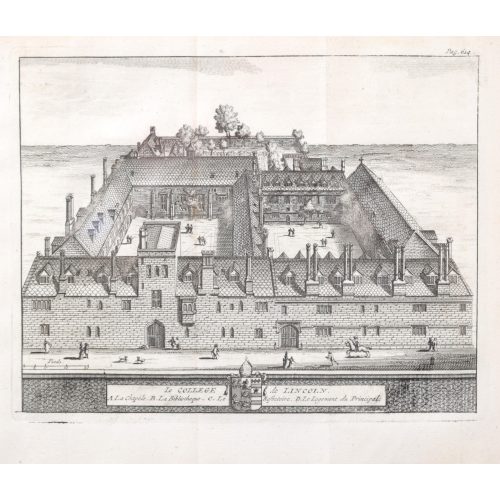
Pieter van der Aa (1659-1733), after David Loggan (1634–1692)
Lincoln College, Oxford (1727)
Engraving 12 x 16 cm An eighteenth-century view of Lincoln, engraved by Pieter van der Aa after David Loggan, the noted engraver, draughtsman, and painter. Pieter van der Aa of Leiden was a Dutch publisher best known for preparing maps and atlases, though he also printed editions of foreign bestsellers and illustrated volumes. He is noted for the many engravings he produced after David Loggan's series of Oxford and Cambridge colleges and costumes. In 1727 Van Der Aa illustrated "Les Delices de la Grande Bretagne & de L'Irelande" by James Beeverell, the book in which this engraving appears. Condition: a good impression. If you’d like to know more, please email info@manningfineart.co.uk or call us on 07929 749056. -
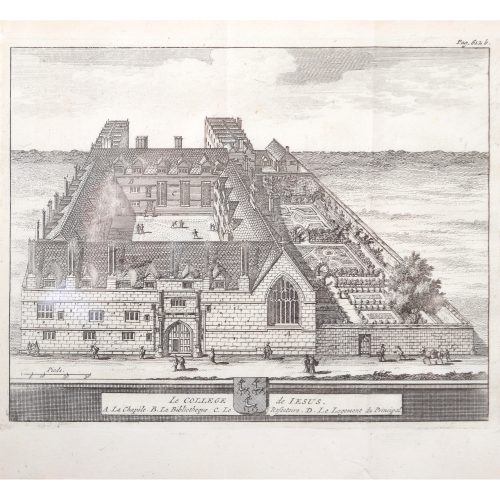
Pieter van der Aa (1659-1733), after David Loggan (1634–1692)
Jesus College, Oxford (1727)
Engraving 12 x 16 cm An eighteenth-century view of Jesus College, engraved by Pieter van der Aa after David Loggan, the noted engraver, draughtsman, and painter. Pieter van der Aa of Leiden was a Dutch publisher best known for preparing maps and atlases, though he also printed editions of foreign bestsellers and illustrated volumes. He is noted for the many engravings he produced after David Loggan's series of Oxford and Cambridge colleges and costumes. In 1727 Van Der Aa illustrated "Les Delices de la Grande Bretagne & de L'Irelande" by James Beeverell, the book in which this engraving appears. Condition: a good impression. If you’d like to know more, please email info@manningfineart.co.uk or call us on 07929 749056. -
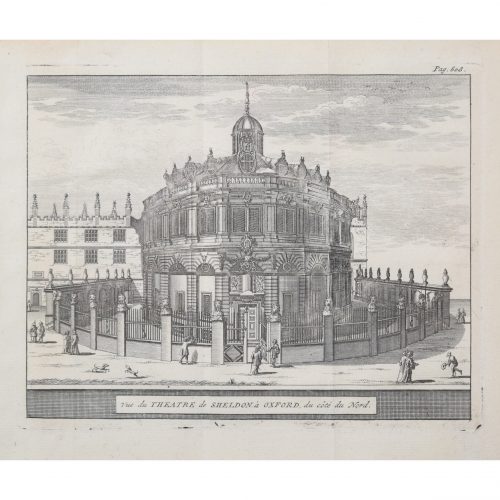
Pieter van der Aa (1659-1733), after David Loggan (1634–1692)
The Sheldonian Theatre, University of Oxford (1727)
Engraving 12 x 16 cm An eighteenth-century view of Oxford's marvellous Sheldonian Theatre, engraved by Pieter van der Aa after David Loggan, the noted engraver, draughtsman, and painter. Christopher Wren designed the building and it was constructed between 1664 and 1669; it takes its name from Gilbert Sheldon, chancellor of the University at the time and the Theatre's main financial backer. Pieter van der Aa of Leiden was a Dutch publisher best known for preparing maps and atlases, though he also printed editions of foreign bestsellers and illustrated volumes. He is noted for the many engravings he produced after David Loggan's series of Oxford and Cambridge colleges and costumes. In 1727 Van Der Aa illustrated "Les Delices de la Grande Bretagne & de L'Irelande" by James Beeverell, the book in which this engraving appears. Condition: a good impression. If you’d like to know more, please email info@manningfineart.co.uk or call us on 07929 749056. -
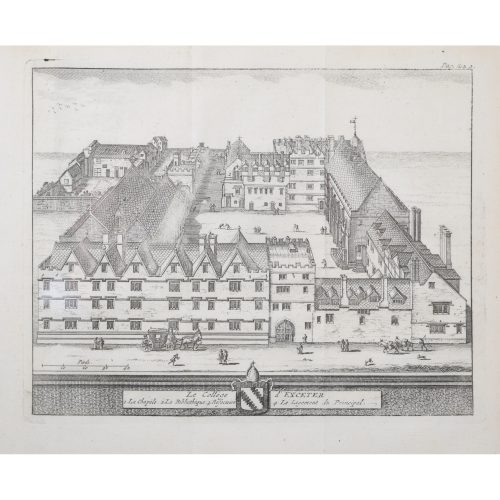
Pieter van der Aa (1659-1733), after David Loggan (1634–1692)
Exeter College, Oxford (1727)
Engraving 12 x 16 cm An eighteenth-century view of Exeter, engraved by Pieter van der Aa after David Loggan, the noted engraver, draughtsman, and painter. Pieter van der Aa of Leiden was a Dutch publisher best known for preparing maps and atlases, though he also printed editions of foreign bestsellers and illustrated volumes. He is noted for the many engravings he produced after David Loggan's series of Oxford and Cambridge colleges and costumes. In 1727 Van Der Aa illustrated "Les Delices de la Grande Bretagne & de L'Irelande" by James Beeverell, the book in which this engraving appears. Condition: a good impression. If you’d like to know more, please email info@manningfineart.co.uk or call us on 07929 749056. -
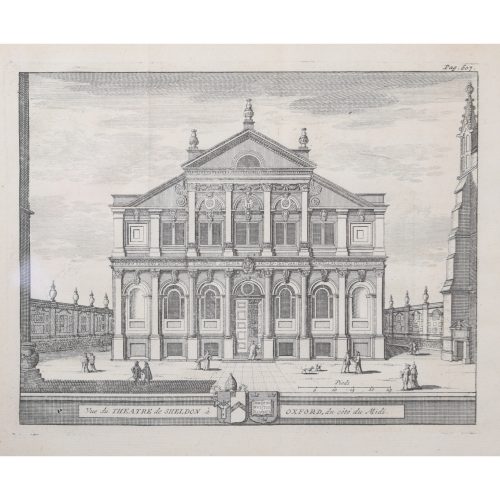
Pieter van der Aa (1659-1733), after David Loggan (1634–1692)
The Sheldonian Theatre, University of Oxford (1727)
Engraving 12 x 16 cm An eighteenth-century view of Oxford's marvellous Sheldonian Theatre, engraved by Pieter van der Aa after David Loggan, the noted engraver, draughtsman, and painter. Christopher Wren designed the building and it was constructed between 1664 and 1669; it takes its name from Gilbert Sheldon, chancellor of the University at the time and the Theatre's main financial backer. Pieter van der Aa of Leiden was a Dutch publisher best known for preparing maps and atlases, though he also printed editions of foreign bestsellers and illustrated volumes. He is noted for the many engravings he produced after David Loggan's series of Oxford and Cambridge colleges and costumes. In 1727 Van Der Aa illustrated "Les Delices de la Grande Bretagne & de L'Irelande" by James Beeverell, the book in which this engraving appears. Condition: a good impression. If you’d like to know more, please email info@manningfineart.co.uk or call us on 07929 749056. -
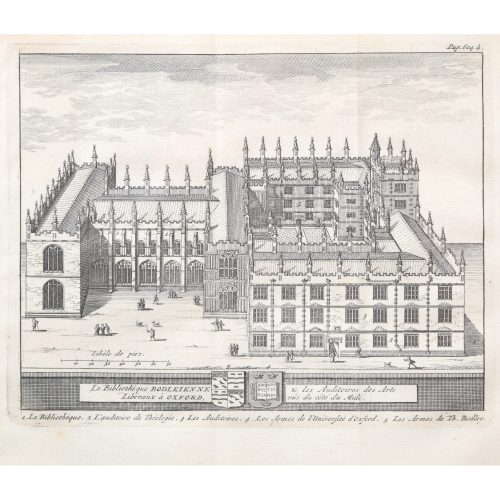
Pieter van der Aa (1659-1733), after David Loggan (1634–1692)
The Bodleian Library, Oxford (1727)
Engraving 12 x 16 cm An eighteenth-century view of the beautiful Bodleian Library, engraved by Pieter van der Aa after David Loggan, the noted engraver, draughtsman, and painter. Pieter van der Aa of Leiden was a Dutch publisher best known for preparing maps and atlases, though he also printed editions of foreign bestsellers and illustrated volumes. He is noted for the many engravings he produced after David Loggan's series of Oxford and Cambridge colleges and costumes. In 1727 Van Der Aa illustrated "Les Delices de la Grande Bretagne & de L'Irelande" by James Beeverell, the book in which this engraving appears. Condition: a good impression. If you’d like to know more, please email info@manningfineart.co.uk or call us on 07929 749056. -
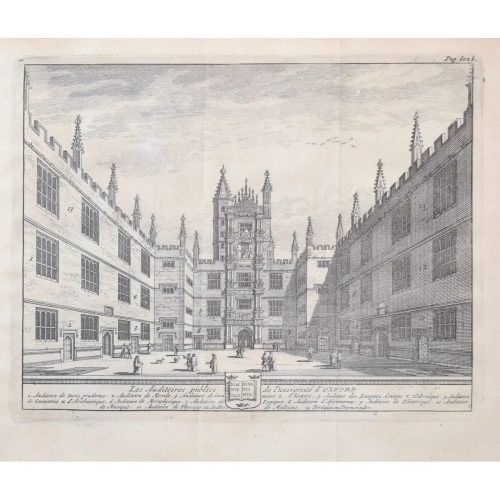
Pieter van der Aa (1659-1733), after David Loggan (1634–1692)
The Public Schools, University of Oxford (1727)
Engraving 12 x 16 cm An eighteenth-century view of the interior of the Public Schools, engraved by Pieter van der Aa after David Loggan, the noted engraver, draughtsman, and painter. Pieter van der Aa of Leiden was a Dutch publisher best known for preparing maps and atlases, though he also printed editions of foreign bestsellers and illustrated volumes. He is noted for the many engravings he produced after David Loggan's series of Oxford and Cambridge colleges and costumes. In 1727 Van Der Aa illustrated "Les Delices de la Grande Bretagne & de L'Irelande" by James Beeverell, the book in which this engraving appears. Condition: a good impression. If you’d like to know more, please email info@manningfineart.co.uk or call us on 07929 749056. -
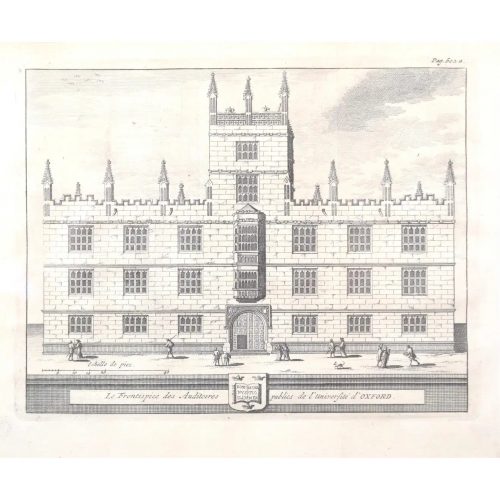
Pieter van der Aa (1659-1733), after David Loggan (1634–1692)
The Public Schools, University of Oxford (1727)
Engraving 12 x 16 cm An eighteenth-century view of the facade of Oxford's Public Schools, engraved by Pieter van der Aa after David Loggan, the noted engraver, draughtsman, and painter. Pieter van der Aa of Leiden was a Dutch publisher best known for preparing maps and atlases, though he also printed editions of foreign bestsellers and illustrated volumes. He is noted for the many engravings he produced after David Loggan's series of Oxford and Cambridge colleges and costumes. In 1727 Van Der Aa illustrated "Les Delices de la Grande Bretagne & de L'Irelande" by James Beeverell, the book in which this engraving appears. Condition: a good impression. If you’d like to know more, please email info@manningfineart.co.uk or call us on 07929 749056. -
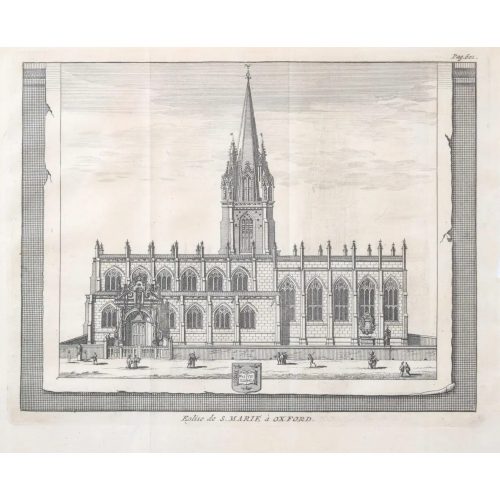
Pieter van der Aa (1659-1733), after David Loggan (1634–1692)
The University Church of St Mary the Virgin, University of Oxford (1727)
Engraving 12 x 16 cm An eighteenth-century view of the University Church, engraved by Pieter van der Aa after David Loggan, the noted engraver, draughtsman, and painter. St Mary's was the first building of the University of Oxford and its parish consists almost exclusively of university and college buildings. Its eccentric Baroque porch, designed by Nicholas Stone, faces the High Street, and it boasts a spire which is claimed by some church historians to be one of the most beautiful in England. Radcliffe Square lies to the north and to the east is Catte Street. The 13th-century tower is open to the public and provides magnificent views across the heart of the historic university city, especially Radcliffe Square, the Radcliffe Camera, Brasenose College, and All Souls College. Of particular interest here is the trompe l'oeil piece of gently torn paper which frames the view of the church. Pieter van der Aa of Leiden was a Dutch publisher best known for preparing maps and atlases, though he also printed editions of foreign bestsellers and illustrated volumes. He is noted for the many engravings he produced after David Loggan's series of Oxford and Cambridge colleges and costumes. In 1727 Van Der Aa illustrated "Les Delices de la Grande Bretagne & de L'Irelande" by James Beeverell, the book in which this engraving appears. Condition: a good impression. If you’d like to know more, please email info@manningfineart.co.uk or call us on 07929 749056. -

Pieter van der Aa (1659-1733), after David Loggan (1634–1692)
All Souls College, Oxford (1727)
Engraving 12 x 16 cm An eighteenth-century view of Le College de Toutre les Ames (All Souls), engraved by Pieter van der Aa after David Loggan, the noted engraver, draughtsman, and painter. The college was founded by Henry VI of England and Henry Chichele (fellow of New College and Archbishop of Canterbury), in 1438, to commemorate the victims of the Hundred Years' War. Pieter van der Aa of Leiden was a Dutch publisher best known for preparing maps and atlases, though he also printed editions of foreign bestsellers and illustrated volumes. He is noted for the many engravings he produced after David Loggan's series of Oxford and Cambridge colleges and costumes. In 1727 Van Der Aa illustrated "Les Delices de la Grande Bretagne & de L'Irelande" by James Beeverell, the book in which this engraving appears. Condition: a good impression. If you’d like to know more, please email info@manningfineart.co.uk or call us on 07929 749056. -
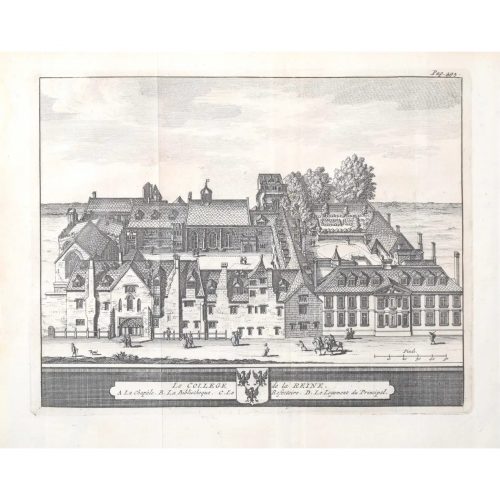
Pieter van der Aa (1659-1733), after David Loggan (1634–1692)
Queen's College, Oxford (1727)
Engraving 12 x 16 cm An eighteenth-century view of Le College de la Reine (Queen's College), engraved by Pieter van der Aa after David Loggan, the noted engraver, draughtsman, and painter. The college was founded in 1341 by Robert de Eglesfield in honour of Philippa of Hainault (the wife of King Edward III). Queen's is known for its predominantly neoclassical architecture, which includes buildings designed by Sir Christopher Wren and Nicholas Hawksmoor. Pieter van der Aa of Leiden was a Dutch publisher best known for preparing maps and atlases, though he also printed editions of foreign bestsellers and illustrated volumes. He is noted for the many engravings he produced after David Loggan's series of Oxford and Cambridge colleges and costumes. In 1727 Van Der Aa illustrated "Les Delices de la Grande Bretagne & de L'Irelande" by James Beeverell, the book in which this engraving appears. Condition: a good impression. If you’d like to know more, please email info@manningfineart.co.uk or call us on 07929 749056. -
Out of stock
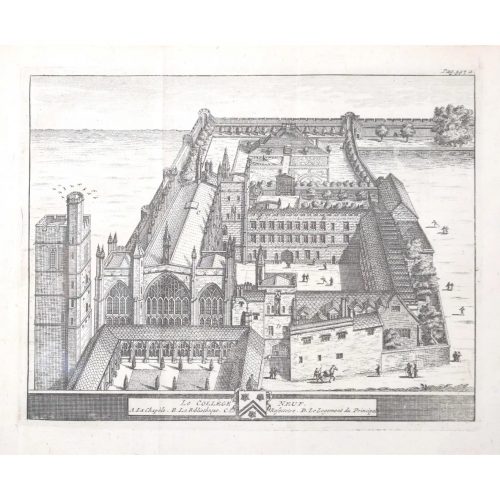
Pieter van der Aa (1659-1733), after David Loggan (1634–1692)
New College, Oxford (1727)
Engraving 12 x 16 cm An eighteenth-century view of Le College Neuf (New College), engraved by Pieter van der Aa after David Loggan, the noted engraver, draughtsman, and painter. Founded in 1379 by William of Wykeham, New College is one of the oldest colleges at the university and was the first to admit undergraduate students. Architecturally, New College was innovative in its design, in that it was all planned around an enclosed quadrangle (finished 1386). This was the first quadrangle of its type, though it has since become one of the defining features of colleges across Oxford and Cambridge. Pieter van der Aa of Leiden was a Dutch publisher best known for preparing maps and atlases, though he also printed editions of foreign bestsellers and illustrated volumes. He is noted for the many engravings he produced after David Loggan's series of Oxford and Cambridge colleges and costumes. In 1727 Van Der Aa illustrated "Les Delices de la Grande Bretagne & de L'Irelande" by James Beeverell, the book in which this engraving appears. Condition: a good impression. If you’d like to know more, please email info@manningfineart.co.uk or call us on 07929 749056. -
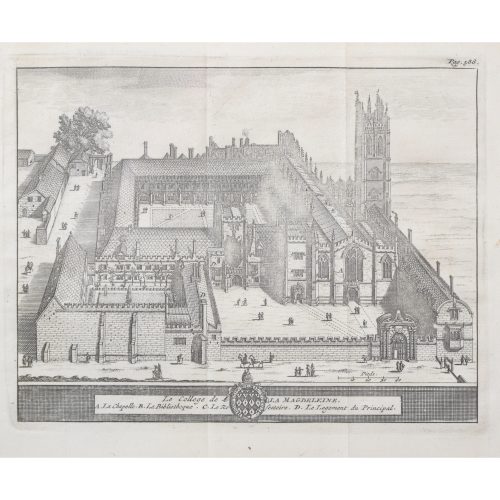
Pieter van der Aa (1659-1733), after David Loggan (1634–1692)
Magdalen College, Oxford (1727)
Engraving 12 x 16 cm A magnificent eighteenth-century view of Magdalen, engraved by Pieter van der Aa after David Loggan, the noted engraver, draughtsman, and painter. Magdalen was founded in 1458 by William of Waynflete, and is considered by many to be Oxford's most beautiful college. The college is organised around five quads; the irregularly shaped St John's Quad is the first on entering the college, and connects to the Great Quad (the Cloister) via the Perpendicular Gothic Founders Tower, which is richly decorated with carvings and pinnacles and has carved bosses in its vault. Chaplain's Quad runs along the side of the Chapel and Hall, to the foot of the Great Tower. St Swithun's Quad and Longwall Quad (which contains the Library) date from the late 19th and early 20th centuries, and make up the southwest corner of the college. Pieter van der Aa of Leiden was a Dutch publisher best known for preparing maps and atlases, though he also printed editions of foreign bestsellers and illustrated volumes. He is noted for the many engravings he produced after David Loggan's series of Oxford and Cambridge colleges and costumes. In 1727 Van Der Aa illustrated "Les Delices de la Grande Bretagne & de L'Irelande" by James Beeverell, the book in which this engraving appears. Condition: a small area slightly lacking in ink. If you’d like to know more, please email info@manningfineart.co.uk or call us on 07929 749056. -
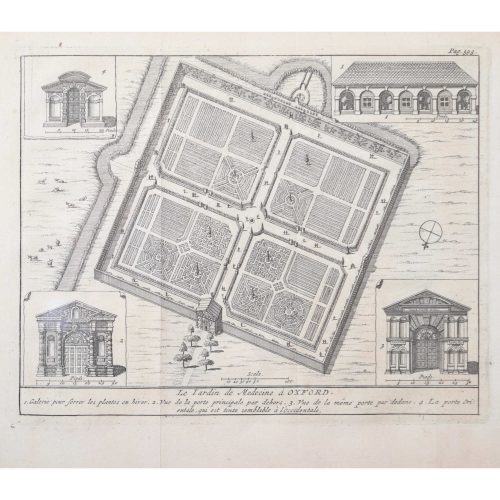
Pieter van der Aa (1659-1733), after David Loggan (1634–1692)
The University of Oxford Botanic Garden (1727)
Engraving 12 x 16 cm An eighteenth-century view of one of Oxford's dreamiest spaces: the Botanic Garden, engraved by Pieter van der Aa after David Loggan, the noted engraver, draughtsman, and painter. The University of Oxford Botanic Garden was founded in 1621 and is the oldest botanical garden in Great Britain. van der Aa's engraving focuses on its architectural qualities, with four features of the garden highlighted for their beauty, symmetry, and prowess of design. Of particular interest in this etching are the four trompe l'oeil pieces of gently curling paper which frame the gates of the garden. The Danby Gate (bottom left) at the front entrance to the garden is one of the three entrances designed by Nicholas Stone between 1632 and 1633. The gateway consists of three bays, each with a pediment; the niches contain statues of Charles I and Charles II in classical pose, and the niche in the the central pediment contains a bust of the Earl of Danby (hence the gate's name). Pieter van der Aa of Leiden was a Dutch publisher best known for preparing maps and atlases, though he also printed editions of foreign bestsellers and illustrated volumes. He is noted for the many engravings he produced after David Loggan's series of Oxford and Cambridge colleges and costumes. In 1727 Van Der Aa illustrated "Les Delices de la Grande Bretagne & de L'Irelande" by James Beeverell, the book in which this engraving appears. Condition: a good impression. If you’d like to know more, please email info@manningfineart.co.uk or call us on 07929 749056. -

Pieter van der Aa (1659-1733), after David Loggan (1634–1692)
Oxford from the East (1727)
Engraving 12 x 16 cm An eighteenth-century view of Oxford from the east, engraved by Pieter van der Aa after David Loggan, the noted engraver, draughtsman, and painter. The skies are wide and full of the University's dreaming spires. Pieter van der Aa of Leiden was a Dutch publisher best known for preparing maps and atlases, though he also printed editions of foreign bestsellers and illustrated volumes. He is noted for the many engravings he produced after David Loggan's series of Oxford and Cambridge colleges and costumes. In 1727 Van Der Aa illustrated "Les Delices de la Grande Bretagne & de L'Irelande" by James Beeverell, the book in which this engraving appears. Condition: a good impression. If you’d like to know more, please email info@manningfineart.co.uk or call us on 07929 749056. -
Out of stock
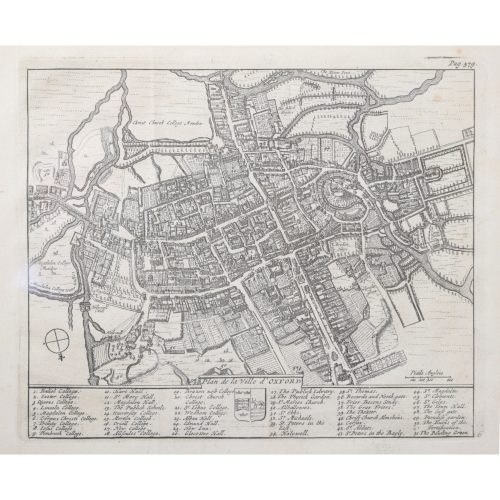
Pieter van der Aa (1659-1733), after David Loggan (1634–1692)
Map of Oxford (1727)
Engraving 12 x 16 cm An eighteenth-century map of Oxford, engraved by Pieter van der Aa after David Loggan, the noted engraver, draughtsman, and painter. The aerial view shows the city and its university buildings in all their glory. Pieter van der Aa of Leiden was a Dutch publisher best known for preparing maps and atlases, though he also printed editions of foreign bestsellers and illustrated volumes. He is noted for the many engravings he produced after David Loggan's series of Oxford and Cambridge colleges and costumes. In 1727 Van Der Aa illustrated "Les Delices de la Grande Bretagne & de L'Irelande" by James Beeverell, the book in which this engraving appears. Condition: a good impression. If you’d like to know more, please email info@manningfineart.co.uk or call us on 07929 749056. -
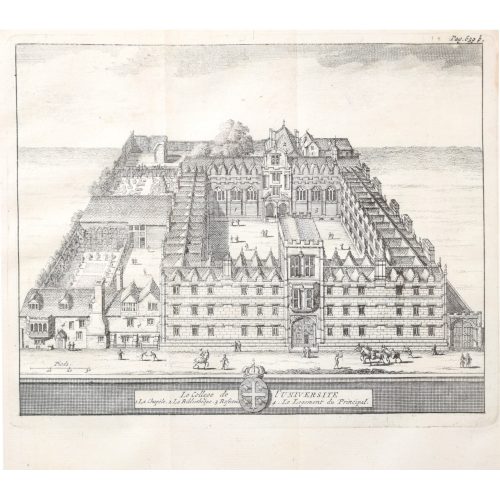
Pieter van der Aa (1659-1733), after David Loggan (1634–1692)
University College, Oxford (1727)
Engraving 12 x 16 cm An eighteenth-century view of University College, Oxford, engraved by Pieter van der Aa after David Loggan, the noted engraver, draughtsman, and painter. Pieter van der Aa of Leiden was a Dutch publisher best known for preparing maps and atlases, though he also printed editions of foreign bestsellers and illustrated volumes. He is noted for the many engravings he produced after David Loggan's series of Oxford and Cambridge colleges and costumes. In 1727 Van Der Aa illustrated "Les Delices de la Grande Bretagne & de L'Irelande" by James Beeverell, the book in which this engraving appears. Condition: a good impression. If you’d like to know more, please email info@manningfineart.co.uk or call us on 07929 749056. -
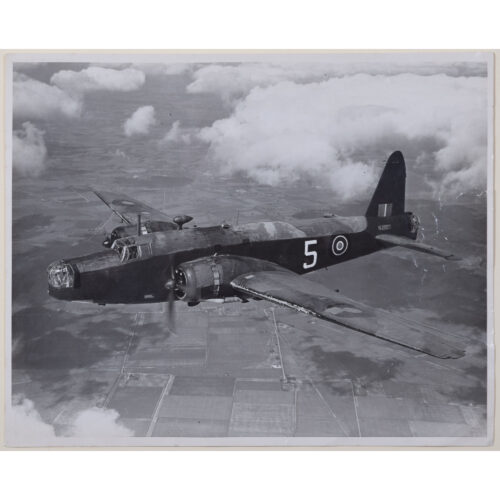
Charles E Brown (1896 - 1982)
Wellington Bomber
Silver gelatin photograph 20 x 25 cm The Vickers Wellington was a British twin-engined, long-range medium bomber. It was designed during the mid-1930s at Brooklands in Weybridge, Surrey. Led by Vickers-Armstrongs’ chief designer Rex Pierson; a key feature of the aircraft is its geodetic airframe fuselage structure, which was principally designed by Barnes Wallis. Development had been started in response to Air Ministry Specification B.9/32, issued in the middle of 1932, for a bomber for the Royal Air Force. This specification called for a twin-engined day bomber capable of delivering higher performance than any previous design. Other aircraft developed to the same specification include the Armstrong Whitworth Whitley and the Handley Page Hampden. During the development process, performance requirements such as for the tare weight changed substantially, and the engine used was not the one originally intended. The Wellington was used as a night bomber in the early years of the Second World War, performing as one of the principal bombers used by Bomber Command. During 1943, it started to be superseded as a bomber by the larger four-engined “heavies” such as the Avro Lancaster. The Wellington continued to serve throughout the war in other duties, particularly as an anti-submarine aircraft. It holds the distinction of having been the only British bomber that was produced for the duration of the war, and of having been produced in a greater quantity than any other British-built bomber. The Wellington remained as first-line equipment when the war ended, although it had been increasingly relegated to secondary roles. The Wellington was one of two bombers named after Arthur Wellesley, 1st Duke of Wellington, the other being the Vickers Wellesley. A larger heavy bomber aircraft designed to Specification B.1/35, the Vickers Warwick, was developed in parallel with the Wellington; the two aircraft shared around 85% of their structural components. Many elements of the Wellington were also re-used in a civil derivative, the Vickers VC.1 Viking. Leslie Carr was a painter and poster designer from London. He served in the Tank Corps in the First World War and then became a professional artist, mainly producing maritime and architectural scenes. He designed posters for Southern Railway, the London and North Eastern Railway, and British Railways (among others). Carr served as a fireman in the Second World War and was a part of several firemen artists’ exhibitions. Carr was a member of the Society of Marine Artists. Charles E Brown was an aviation photographer. His archive of 30,000 images has been held by the RAF Museum in Hendon since 1978. Condition: generally good; a few old creases and a short (repaired) tear top right approx 1 cm long. If you are interested, please email info@manningfineart.co.uk or call us on 07929 749056. Click here for other Second World War pictures. -
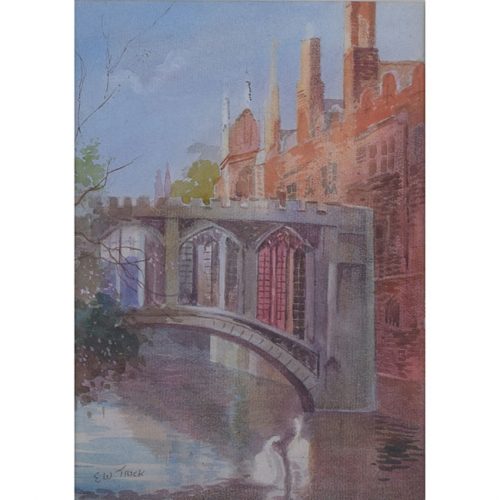
E W Trick
Bridge of Sighs, St. John's College, Cambridge
Watercolour 24x18cm If you are interested email info@manningfineart.co.uk or call us on 07929 749056. -

Robert Thomson (British, 20th Century) Trinity College Cambridge - Trinity Bridge over the River Cam with Punts
22 x 32 cm Watercolour Signed in pencil 'Thomson' to bottom right An old favourite view, painted in a bold and confident fashion by Robert Thomson, capturing the carefree spirit of an afternoon's punting, and the bold and clear architecture of Cambridge's biggest and wealthiest College. If you are interested email info@manningfineart.co.uk or call us on 07929 749056. Condition: Excellent. -
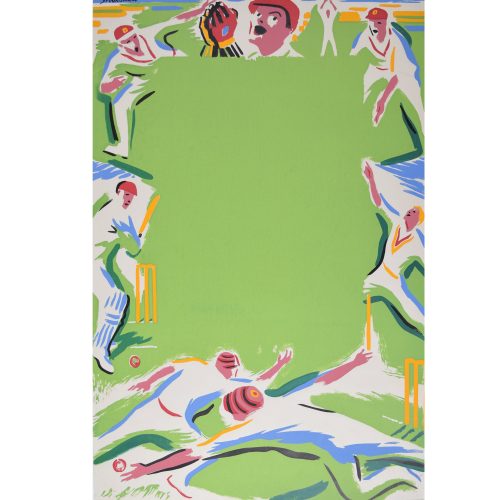
Percy Drake Brookshaw (1907-1993) Cricket
Original coach poster Lithograph c. 1950s 76x50cm A poster for advertising details of coaches to cricket matches such as The Ashes or other Test Matches. Brookshaw was born in Southwark, in London, and educated at the Central School of Arts and Crafts. He was a particularly accomplished lithographer, skilled also as a painter in both oil and watercolour. Identifying the former talent, F Gregory Brown - the poster and textile designer - encouraged him to become an illustrator and poster designer. Producing posters for London Transport and Shell, inter alia, between 1928 and 1958, many of his posters depict sporting events. His two posters for the annual University Boat Race are well known and highly sought after, and his wonderful posters often evoke a feeling of movement, whether rowers straining on their oars, or horses or greyhounds racing. If you are interested email info@manningfineart.co.uk or call us on 07929 749056. Conditon: Generally very good, a few short edge tears and soft creases, see photograph. -
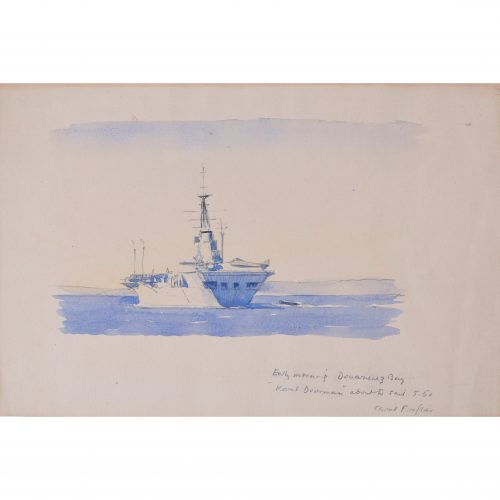
Laurence Dunn (1910-2006)
Karel Doorman About to Sail
Watercolour 15 x 23 cm (sheet size 99 x 73 cm) Signed to backing board, with extensive inscription by Dunn. HNLMS Karel Doorman (R81) was a Colossus-class aircraft carrier of the Royal Netherlands Navy. Formerly the British ship HMS Venerable, she was sold to the Netherlands in 1948 as a light attack carrier. In 1960, she was involved in the decolonization conflict in Western New Guinea with Indonesia. In the mid 1960s, her role was changed to anti-submarine warfare carrier and only ASW aircraft and helicopters were carried. An engine room fire took her out of service in 1968. She was sold to Argentina in 1969 and renamed ARA Veinticinco de Mayo. Laurence Dunn was an artist known for his depictions of ships. He grew up in Devon, where he practised drawing passing ships, and went on to study at the Central School of Art. He then worked for shipbuilding firm John I. Thornycroft & Company Limited, where he assisted with the design of the royal yacht.During the Second World War, Dunn worked for naval intelligence. In the early 1960s he created many line drawings of Atlantic ocean liners. The World Ship Society published the following obituary for Laurence Dunn in 2006: DUNN, Laurence. [December 15 2006 — Lloyds List] Many readers will be saddened by the death of well-known marine artist and writer Laurence Dunn in his 97th year. A man of encyclopaedic knowledge, he began his lifelong love of ships in Brixham, where he meticulously recorded passing traffic with the exquisitely accurate line drawings which later became something of a trademark. While studying at London’s Central School of Art his work was noticed by the Southern Railway, which commissioned profiles of its fleet, and this in turn led to work for Orient Line, where he also designed the well-known corn-coloured hull, and later Thorneycroft, where he helped with shaping draft plans for a new royal yacht. During the second world was he worked for naval intelligence at the Admiralty, where his technique did much to improve recognition standards, and greatly expanded his shipping clientele, becoming personally known to many chairmen. As well as the shipping press he worked for mainstream publications such as Everybody’s, Sphere and the upmarket comic Eagle. Through his many contacts he enjoyed going to sea in a great variety of ships from aircraft carriers to colliers. Laurence wrote several books, starting with ship recognition titles which introduced new standards of layout, but his best known work was probably Passenger Liners, which was widely taken up by the travel trade. His love of Greece, where he was an early publicist of island cruising, let to involvement in reshaping various passenger liners beginning with Greek Line’s OLYMPIA. In later life he designed several sets of shipping stamps for the Crown Agents, produced photographic volumes on Thames and Mediterranean shipping and still found time to enjoy the passing Thames traffic. Our sympathies go to his wife Jennifer, who provided succour to the many ship lovers who beat a path to the welcoming door of their Gravesend home. Condition: very good. If you'd like to know more, please email info@manningfineart.co.uk or call us on 07929 749056. -
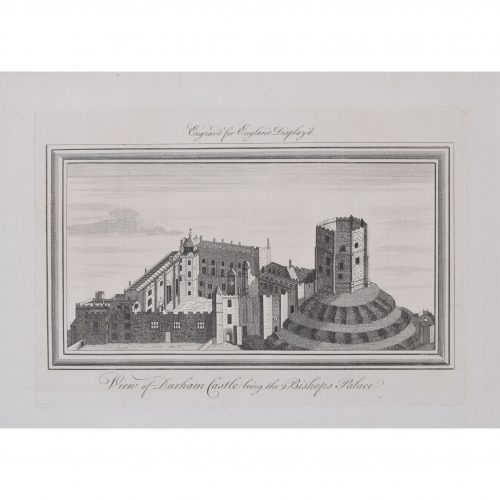
after Samuel Buck (1696 - 1779) and Nathaniel Buck (active 1724 - 1759)
View of Durham Castle being the Bishops Palace (1769)
Engraving 18 x 26 cm An engraved view of Durham Castle, complete with engraved frame in the plate. Empty of any inhabitants, the magnificence of the castle's architecture, is made all the more evident. This engraving was produced for 'England Displayed, published in London in 1769 or 1770 by Adlard and Brown; it was made after the original by Samuel and Nathaniel Buck, originally published in their 'Views of Ruins of Castles & Abbeys in England', created between 1726 and 1742. Durham Castle is a Norman castle in Durham, England, which has been occupied since 1837 by Castle - that is, University College, Durham. Previously, it was the residence of the Bishops of Durham; it stands on top of a hill above the River Wear on Durham's peninsula, opposite Durham Cathedral. Samuel and Nathaniel Buck were brothers and notable 18th century architectural artists, best known for their depictions of ancient castles and monasteries entitled 'Buck's Antiquities' and those of townscapes of England and Wales, ''Sea-Ports and Capital Towns''. LIttle is known about the brothers' lives. Samuel was born in Yorkshire and died in penury in London in 1779, and was buried in the churchyard of St Clement Danes. Nathaniel pre-deceased him, dying between 1759 and 1774. Condition: very good. If you’d like to know more, please email info@manningfineart.co.uk or call us on 07929 749056. -
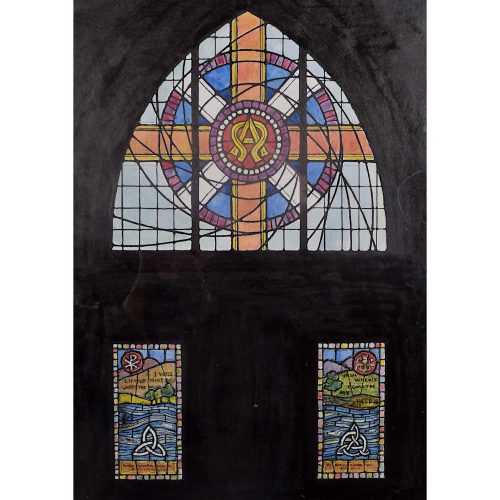
Jane Gray (b.1931)
St Andrew’s Church, Walton-on-Thames, Design for Stained Glass Window (1993)
Watercolour 28.5 x 20.5 cmSigned, dated and studio stamp verso.
St Andrew’s Church was built in 1931 but its story began some years earlier in 1928 when a group of Scots and those with Scottish roots, started meeting in the Walton Playhouse to worship under a retired Presbyterian Minister. Over time, funds were raised to build a proper church, the foundation stone laid in 1931, bearing the Presbyterian Church’s Latin motto, ‘Nec Tamen Consumebatur’ (and yet it was not consumed) from the Old Testament story of Moses and the Burning Bush. In 1972, alongside most Presbyterian Churches of England, St Andrew’s united with The Congregational Church of England and Wales to form, ‘The United Reformed Church’. This window features a red cross with St Andrew’s cross, along with the Alpha and Omega, and was installed in 1994.
Provenance: the artist’s studio sale. Literature: Jane Gray, Playing with Rainbows. (Shropshire: Ellingham Press, 2011), p.83. Condition: very good. If you are interested, please email info@manningfineart.co.uk or call us on 07929 749056. For other works by Jane Gray and more information about her, please click here. -
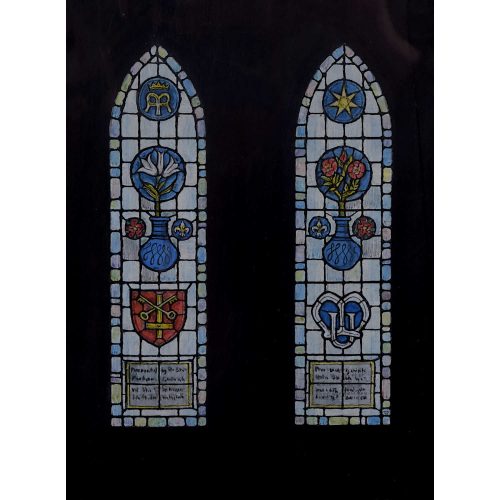
Jane Gray (b.1931)
St Peter’s Church, Chorley, Lancashire, Design for Stained Glass Window (1987)
Watercolour 18 x 13 cmSigned, dated and studio stamp verso.
St Peter’s Church was designed by the Liverpudlian architect, Charles Reed in the Early English style and built in 1850 with stone donated from Lady Hoghton’s nearby quarry. Reed wrote, ‘The general effect is expected to be very quaint and beautiful, while its elevated situation will make it a charming landmark from every side’. The church was consecrated on St Mark’s Day, 1851 by the first Bishop of Manchester, the Rt. Revd. James Prince Lee. This window was installed in 1988.
Provenance: the artist’s studio sale. Literature: Jane Gray, Playing with Rainbows. (Shropshire: Ellingham Press, 2011), p.79. Condition: very good. If you are interested, please email info@manningfineart.co.uk or call us on 07929 749056. For other works by Jane Gray and more information about her, please click here. -
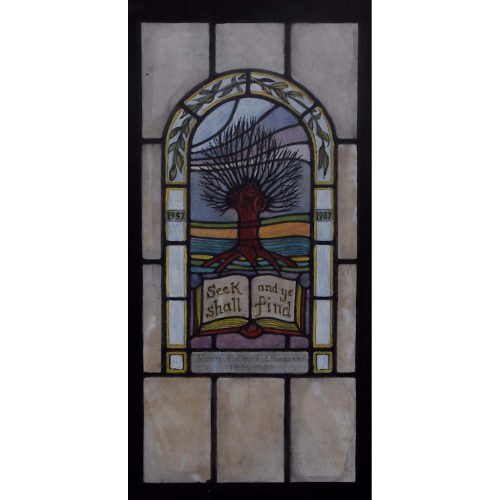
Jane Gray (b.1931)
Ruislip Library, Design for Stained Glass Window (1987)
Watercolour 18 x 8.5 cmSigned, dated and studio stamp verso.
In 1987, money was put aside for something to commemorate the Ruislip Library’s 50th anniversary; instead of another bench in a reading room, Gray received a commission for a stained glass window. This was the first window Gray made from her home in Shropshire and she used the nearby willow trees to inspire the wreath of willow leaves and central ‘Tree of Knowledge'—a pollarded willow. The choice of tree was highly intentional as, coincidentally, a librarian by the name Miss Pollard had also died that year.
Provenance: the artist’s studio sale. Literature: Jane Gray, Playing with Rainbows. (Shropshire: Ellingham Press, 2011), p.36. Condition: very good. If you are interested, please email info@manningfineart.co.uk or call us on 07929 749056. For other works by Jane Gray and more information about her, please click here. -
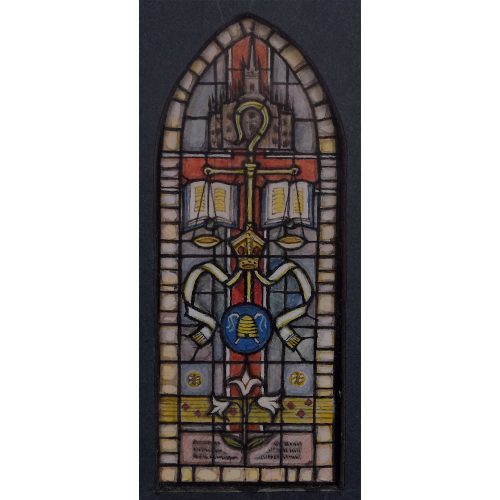
Jane Gray (b.1931)
St Ambrose Church, Leyland, Design for Stained Glass Window (1980)
Watercolour 11.5 x 4.5 cmStudio label verso.
The site of St Ambrose Church, Leyland, originally lay in the parish of St. Andrew’s Leyland; however, after a 37% population increase in the town caused by the coming of the railways and industrialisation in the 1870’s, the Vicar of St. Andrews decided to build a chapel of ease to St. Andrews. The church was rebuilt on the northern edge of the town in 1880. This window features symbols of St Ambrose and was installed in the church in 1982.
Provenance: the artist’s studio sale. Literature: Jane Gray, Playing with Rainbows. (Shropshire: Ellingham Press, 2011), p.76. Condition: very good. If you are interested, please email info@manningfineart.co.uk or call us on 07929 749056. For other works by Jane Gray and more information about her, please click here. -
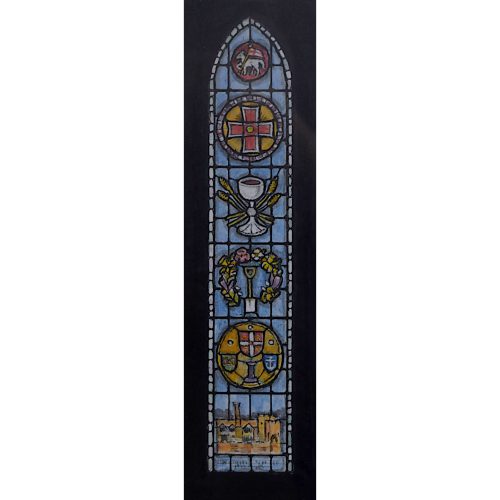
Jane Gray (b.1931)
St John the Baptist Church, Preen Manor, Design for Stained Glass Window (2003)
Watercolour 17.5 x 5 cmSigned, dated and studio stamp verso.
St John the Baptist Church sits at the heart of the Shropshire hamlet, Preen. Church Preen Manor sits adjacent to the church and lies on an old Clunjac Monastery, thought to have been built in 1159. The present church was built in the 13th century although it was originally a monastic church, founded as a cell of Wenlock Priory in 1163 and features in the Domesday Book. A prior and two or three monks would have served the church, however the priory has little remains, excepting a few visible in the gardens of Church Preen Manor.
Provenance: the artist’s studio sale. Literature: Jane Gray, Playing with Rainbows. (Shropshire: Ellingham Press, 2011), p.88. Condition: very good. If you are interested, please email info@manningfineart.co.uk or call us on 07929 749056. For other works by Jane Gray and more information about her, please click here. -
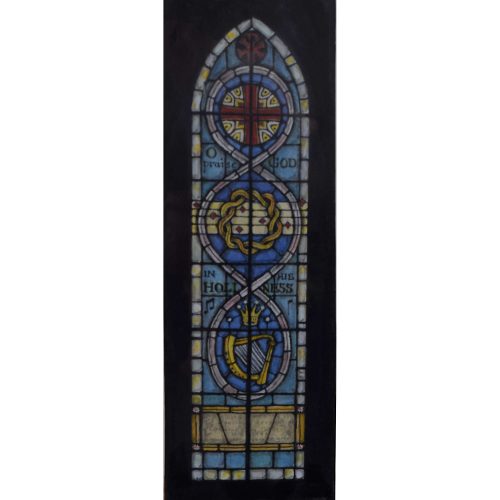
Jane Gray (b.1931)
All Saints Church, Lightwater, Surrey, Design for Stained Glass Window (1990)
Watercolour 18 x 6 cmSigned, dated and studio stamp verso.
All Saints Church in Lightwater, Surrey was built and dedicated in 1903. Prior to this, services were held in Florence Laundry in Guildford Road as, at that time, Lightwater was a small hamlet. With the development of nurseries and cottages to house the influx of workers that followed soon after, the Conventional District of All Saints’ was formed in 1931. Before this, All Saints Church had been a daughter church of Windlesham. A Priest-in-Charge was appointed shortly after the split in 1931 and a vestry extension was added to the building. This window commemorates the church’s organist, Catherine Challen, and features symbols associated with St Cecilia in acknowledgement of her musical contribution. The window was installed in 1991.
Provenance: the artist’s studio sale. Literature: Jane Gray, Playing with Rainbows. (Shropshire: Ellingham Press, 2011), p.79. Condition: very good. If you are interested, please email info@manningfineart.co.uk or call us on 07929 749056. For other works by Jane Gray and more information about her, please click here. -
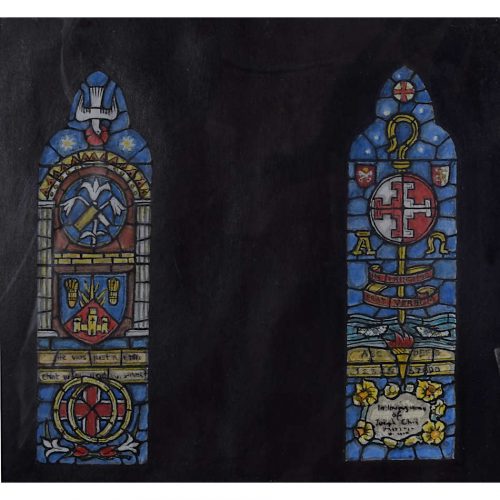
Jane Gray (b.1931)
St Catherine’s Church, Penrith, Cumbria, Design for Stained Glass Memorial Windows (1992)
Watercolour 16.5 x 15 cmSigned, dated and studio stamp verso.
St Catherine’s Church, Penrith is a Puginian Gothic town church, built by Fr George Haydock of Cottam and other Catholic notables in the early 19th century in the 14th century Gothic style. The church and its substantial presbytery, built in 1853, adjoin the churchyard of the Anglican parish church. This window was installed in 1992.
Provenance: the artist’s studio sale. Literature: Jane Gray, Playing with Rainbows. (Shropshire: Ellingham Press, 2011), p.82. Condition: very good. If you are interested, please email info@manningfineart.co.uk or call us on 07929 749056. For other works by Jane Gray and more information about her, please click here. -
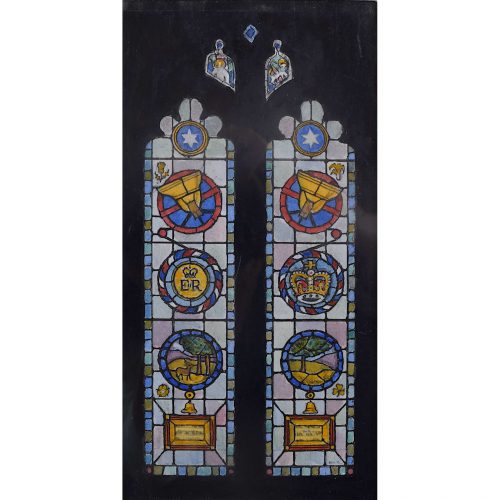
Jane Gray (b.1931)
St Giles Church, Bradford on Tone, Taunton, Somerset, Design for Stained Glass Window (2011)
Watercolour 21.5 x 11.5 cm Signed, dated and studio stamp verso.St Giles Church in Bradford on Tone lies nestled between the Blackdown and Quantock Hills and dates back from the 13th century. One of the lords of the manor, Sir John de Merit (d.1391), founded a chantry chapel here in 1387 but the church has undergone a series of renovations since. The present south aisle and most of the windows date to the 15th century, and the west tower to the early 16th century, before the church underwent full restoration works in 1867.
Provenance: the artist’s studio sale. Condition: very good. If you are interested, please email info@manningfineart.co.uk or call us on 07929 749056. For other works by Jane Gray and more information about her, please click here. -
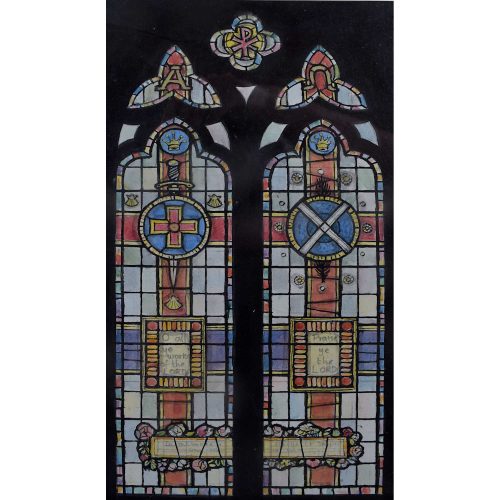
Jane Gray (b.1931)
St James’ Church, Weddington, Nuneaton, Warwickshire, Design for Stained Glass Memorial Window (1989)
Watercolour 19 x 10.5 cm Signed, dated and studio stamp verso.St James’ Church in Weddington dates back to the early-14th-century. The chancel, nave, and west tower were rebuilt in red brick in 1733, and the building was restored in 1881, when Gothic windows were inserted in place of the 1733 details. This design fantastically demonstrates Gray’s modernist style, with her colourful palette and simple yet detailed, geometrical structure. This window was installed in 1990.
Provenance: the artist’s studio sale. Literature: Jane Gray, Playing with Rainbows. (Shropshire: Ellingham Press, 2011), p.80. Condition: very good. If you are interested, please email info@manningfineart.co.uk or call us on 07929 749056. For other works by Jane Gray and more information about her, please click here. -
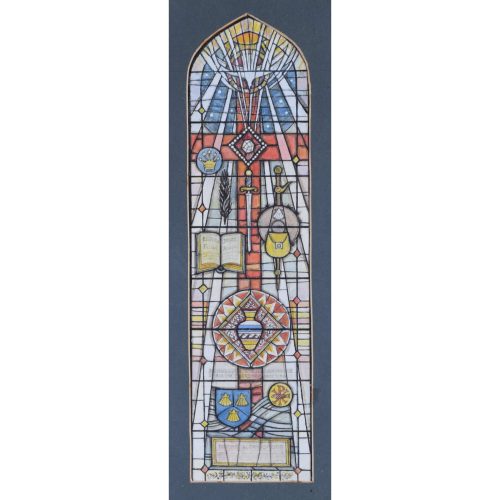
Jane Gray (b.1931)
St James, Temple Sowerby, Cumbria, Design for Stained Glass Window (1978)
Watercolour 30 x 12 cm Signed and dated verso.St James’ Church in Temple Sowerby, Cumbria was built in 1754, and enlarged in 1770, the west tower being added in 1807. In his 1831 work, A Topographical Dictionary of England, Samuel Lewis described the church as ‘a handsome structure of red freestone, with a square tower and portico’.
Provenance: the artist’s studio sale. Condition: very good. If you are interested, please email info@manningfineart.co.uk or call us on 07929 749056. For other works by Jane Gray and more information about her, please click here. -
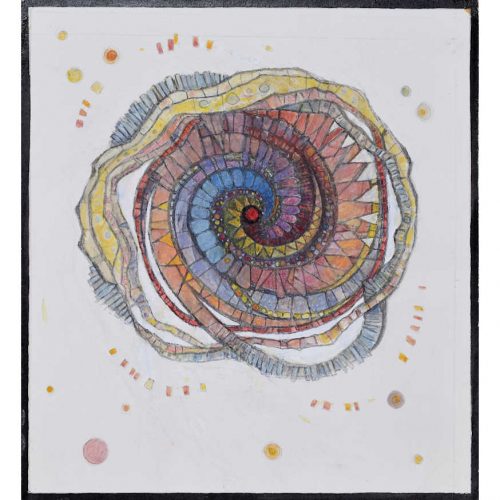
Jane Gray (b.1931)
Applique Stained Glass Window Design
Watercolour18 x 16 cm
Studio label versoIn this stained glass design, Gray uses the appliqué method to construct a highly colourful, abstract, swirling image, typical of many of her more modern works. Gray uses the same technique as in other works of hers where a sense of the transcendental is married with modern abstraction, the viewer’s gaze hypnotically pulled in to the central red dot.
Provenance: the artist’s studio sale. Condition: very good. If you are interested, please email info@manningfineart.co.uk or call us on 07929 749056. For other works by Jane Gray and more information about her, please click here. -
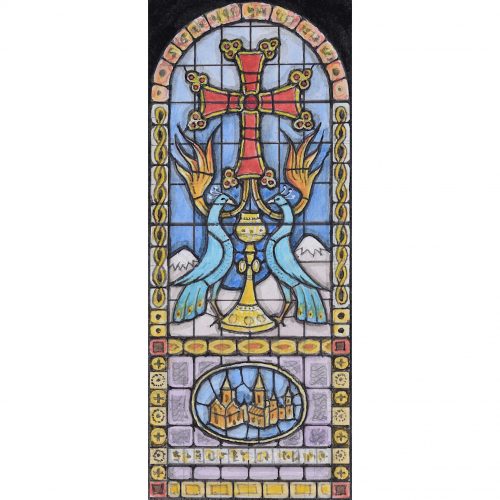
Jane Gray (b.1931)
Stained Glass Window Design for a Church
Watercolour15.5 x 6 cm
This design for a stained glass window draws together Gray’s modern yet traditional approach to designing church windows. The design features an oval external view of the church buildings beneath a pair of bright blue peacocks, two colourfully burning flames and a large red cross.
Provenance: the artist’s studio sale. Condition: very good. If you are interested, please email info@manningfineart.co.uk or call us on 07929 749056. For other works by Jane Gray and more information about her, please click here. -
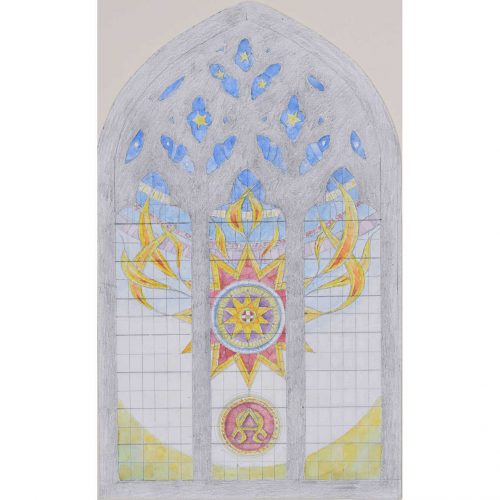
Jane Gray (b.1931)
Design for Large Stained Glass Window in a Church
Watercolour and pencil33.5 x 20.5 cm
This design for a stained glass window draws together Gray’s modern yet traditional approach to designing church windows. The design features a central, inwardly repeating star shape with bright flame-like shapes curling upwards from its corners. This central motif sits against a blue sky background with smaller stars scattered in the smaller glass panes at the top of the design.
Provenance: the artist’s studio sale. Condition: very good. If you are interested, please email info@manningfineart.co.uk or call us on 07929 749056. For other works by Jane Gray and more information about her, please click here. -
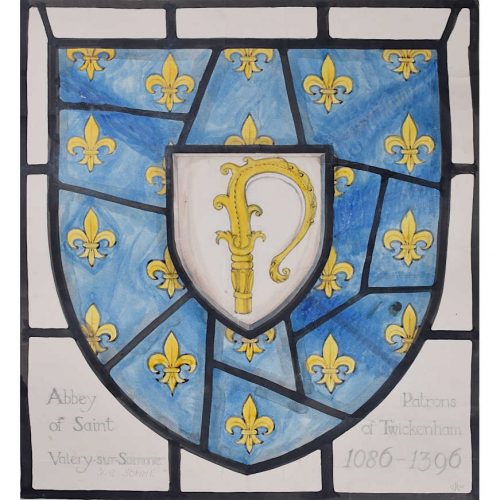
Jane Gray (b.1931)
Stained Glass Window Design, St Mary’s Church, Twickenham (1960)
Watercolour41 x 37 cm
Signed and dated l.r.This stained glass window design is one of a handful Gray designed for her local church, St Mary’s Twickenham. St Mary’s Church stands on the site of an earlier church in Twickenham, a short distance from York House and the banks of the River Thames, and incorporates a 15th-century, medieval tower. St Mary's has an impressive and illustrious history of notable parishioners including the painter Godfrey Kneller who, after the collapse of the ancient church's 14th-century nave in 1714, took active involvement in redesigning the church in the Neo-classical style alongside local architect John James, as well as Henry Fielding and Alfred Lord Tennyson whose sons were both baptised here. Gray had a personal connection to St Mary’s, her great grandfather having been the vicar some years before. This design, in particular, commemorates the benedictine monastery at the mouth of the Somme River: the Abbey of Saint Valery-sur-Somme. The imagery focusses on the repeated motif of the heraldic and highly symbolic fleur-de-lis, set against a sky blue background, the central shield containing the head of an ornate, gilt shepherd’s crook; a religious symbol of care, particularly in difficult circumstances.
Provenance: the artist’s studio sale. Condition: very good. If you are interested, please email info@manningfineart.co.uk or call us on 07929 749056. For other works by Jane Gray and more information about her, please click here. -
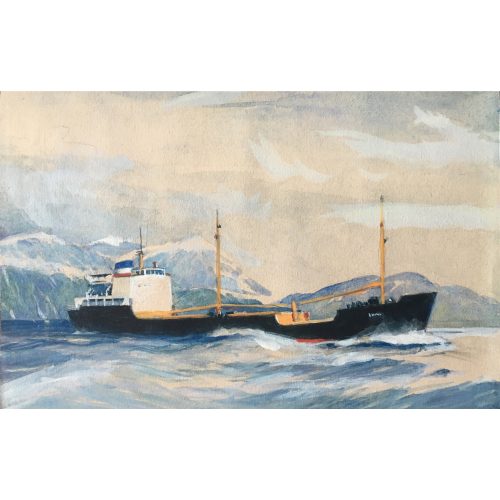
Laurence Dunn (1910-2006) Otra
Gouache 11.5x18cm Inscribed to reverse 'Rough sketch for painting of "Otra" commissioned for Capt. F.E. Eagle, whose favourite command she was' and signed 'Laurence Dunn' The World Ship Society published the following obituary for Dunn: DUNN, Laurence. [December 15 2006 — Lloyds List] Many readers will be saddened by the death of well-known marine artist and writer Laurence Dunn in his 97th year. A man of encyclopaedic knowledge, he began his lifelong love of ships in Brixham, where he meticulously recorded passing traffic with the exquisitely accurate line drawings which later became something of a trademark. While studying at London’s Central School of Art his work was noticed by the Southern Railway, which commissioned profiles of its fleet, and this in turn led to work for Orient Line, where he also designed the well-known corn-coloured hull, and later Thorneycroft, where he helped with shaping draft plans for a new royal yacht. During the second world was he worked for naval intelligence at the Admiralty, where his technique did much to improve recognition standards, and greatly expanded his shipping clientele, becoming personally known to many chairmen. As well as the shipping press he worked for mainstream publications such as Everybody’s, Sphere and the upmarket comic Eagle. Through his many contacts he enjoyed going to sea in a great variety of ships from aircraft carriers to colliers. Laurence wrote several books, starting with ship recognition titles which introduced new standards of layout, but his best known work was probably Passenger Liners, which was widely taken up by the travel trade. His love of Greece, where he was an early publicist of island cruising, let to involvement in reshaping various passenger liners beginning with Greek Line’s OLYMPIA. In later life he designed several sets of shipping stamps for the Crown Agents, produced photographic volumes on Thames and Mediterranean shipping and still found time to enjoy the passing Thames traffic. Our sympathies go to his wife Jennifer, who provided succour to the many ship lovers who beat a path to the welcoming door of their Gravesend home. If you are interested email info@manningfineart.co.uk or call us on 07929 749056. Condition: Excellent. -
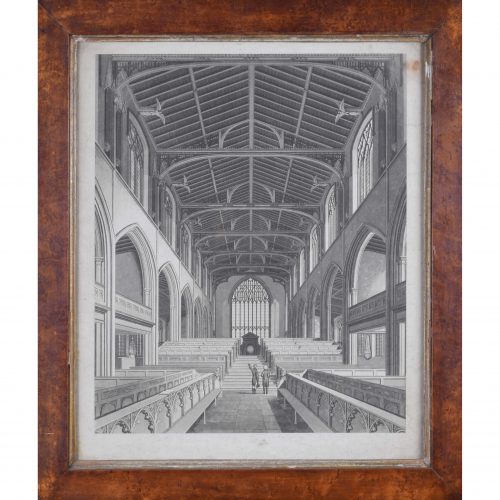
Chapel Interior (circa 1800)
Engraving 49 x 40 cm An engraving of a magnificent chapel interior. Two men tour the chapel, one gesticulating towards the spectacular design of the chancel window. Condition: good. Some gentle discolouration; in faux burr-maple frame. If you’d like to know more, please email info@manningfineart.co.uk or call us on 07929 749056. -
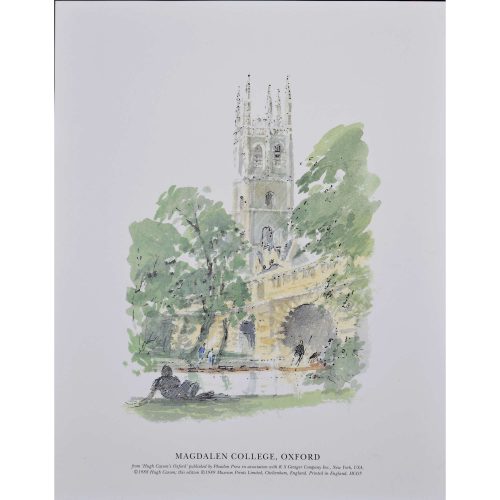
Sir Hugh Casson (1910-1999) Magdalen College Oxford
Unsigned proof print 25x20cm From Casson’s ever-popular Oxford series of prints. Sir Hugh Casson was educated at Eastbourne College, St John’s College Cambridge and the Bartlett School of Architecture. Trained in the 1930s in the early modernist style, he taught at the Cambridge School of Architecture. After employment as a camoufleur during World War 2 by the Air Ministry, in 1948 he was appointed as director of architecture for the Festival of Britain. A close friend of the Royal Family, he undertook designs for the 1953 coronation, designed the interior of the Royal Yacht Britannia (“The overall idea was to give the impression of a country house at sea”), and taught the Prince of Wales to paint in watercolours. Amongst his architectural achievements are the Elephant House at London Zoo, the 1978 redevelopment of Bristol Docks, the Raised Faculty Building for The University of Cambridge, and a building for the Royal College of Art. He published a number of illustrated books, of which Casson’s Oxford and Casson’s Cambridge are probably the best known. A limited edition series of prints was produced from the paintings. If you are interested email info@manningfineart.co.uk or call us on 07929 749056. Condition: Excellent. -

Henry Cliffe (1919-1983) Reclining Figure IV
Etching Mid 20th Century 11x24cm Click here for biographical details and other pictures by the artist. If you are interested email info@manningfineart.co.uk or call us on 07929 749056. Condition: Good. -
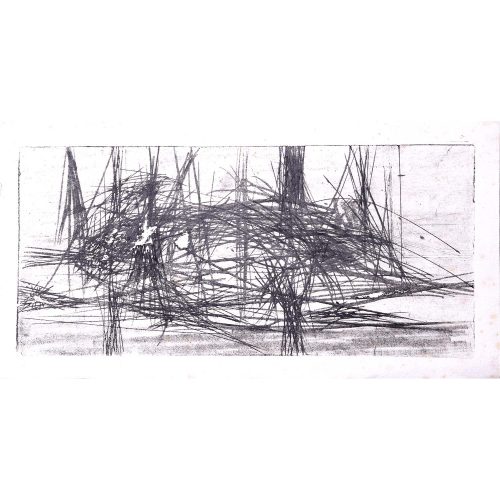
Henry Cliffe (1919-1983) Reclining Figure III
Etching Mid 20th Century 11x24cm Click here for biographical details and other pictures by the artist. If you are interested email info@manningfineart.co.uk or call us on 07929 749056. Condition: Good. -
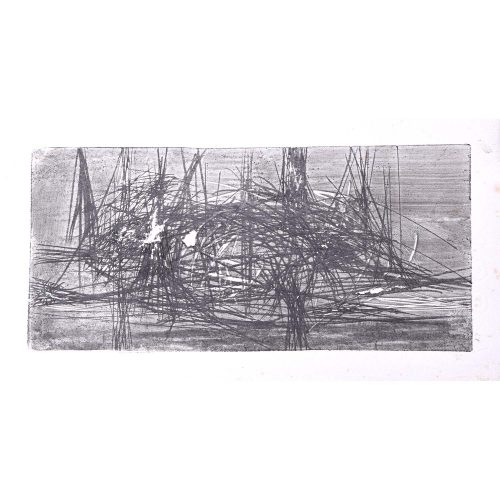
Henry Cliffe (1919-1983) Reclining Figure VI
Etching Mid 20th Century 11x24cm Click here for biographical details and other pictures by the artist. If you are interested email info@manningfineart.co.uk or call us on 07929 749056. Condition: Good. -
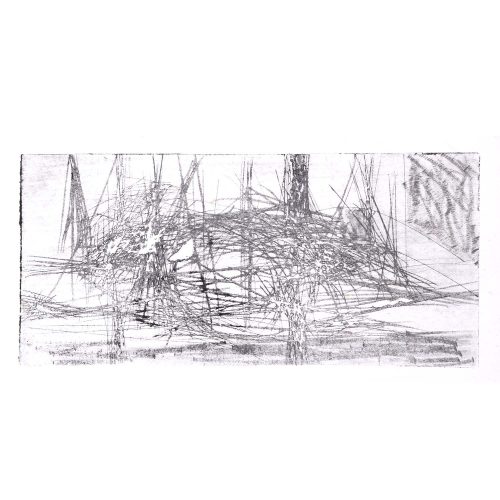
Henry Cliffe (1919-1983) Reclining Figure II
Etching Mid 20th Century 11x24cm Click here for biographical details and other pictures by the artist. If you are interested email info@manningfineart.co.uk or call us on 07929 749056. Condition: Good. -
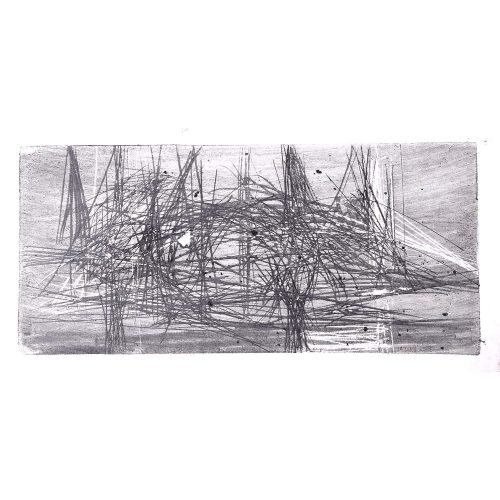
Henry Cliffe (1919-1983) Reclining Figure V
Etching Mid 20th Century 11x24cm Click here for biographical details and other pictures by the artist. If you are interested email info@manningfineart.co.uk or call us on 07929 749056. Condition: Good. -

Henry Cliffe (1919-1983) Abstract Harbour
Etching Mid 20th Century 13x19cm Click here for biographical details and other pictures by the artist. If you are interested email info@manningfineart.co.uk or call us on 07929 749056. Condition: Good. -
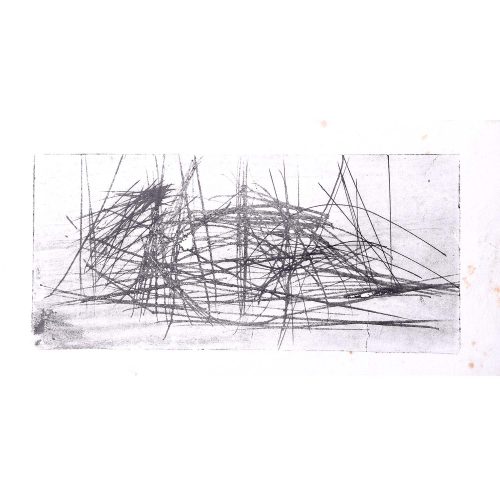
Henry Cliffe (1919-1983) Reclining Figure I
Etching Mid 20th Century 11x24cm Click here for biographical details and other pictures by the artist. If you are interested email info@manningfineart.co.uk or call us on 07929 749056. Condition: Good. -
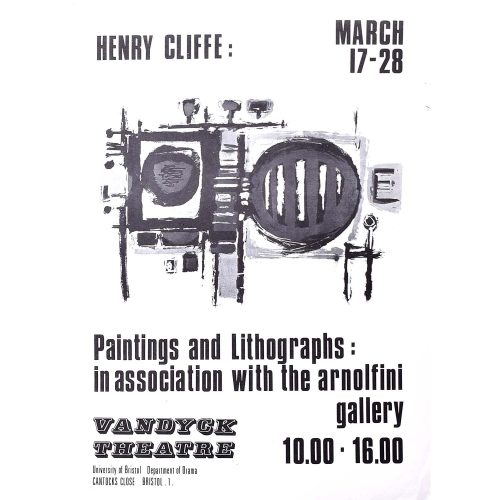
Henry Cliffe (1919-1983) Vandyck Theatre Poster
Etching Mid 20th Century 42x30cm Click here for biographical details and other pictures by the artist. If you are interested email info@manningfineart.co.uk or call us on 07929 749056. Condition: Good. -
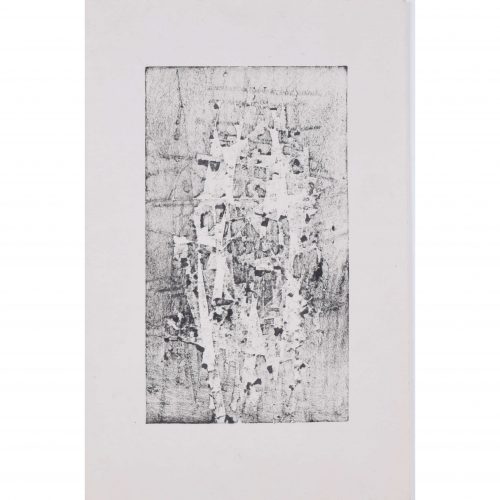
Henry Cliffe (1919-1983) Monochrome Figures
Etching 9.5 x 16.5 cm Condition: Good. If you are interested, please email info@manningfineart.co.uk or call us on 07929 749056. -
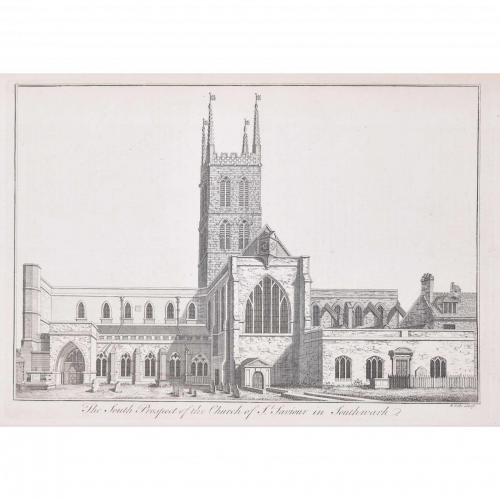
Benjamin Cole (1697-1783)
Southwark Cathedral (c. 1753)
Engraving 24 x 33 cm Stow's Survey of London, a ward-by-ward topographical and historical tour of the City of London giving an account of buildings, social conditions and customs, was first published in 1598. This view of Southwark Cathedral, labelled here as 'the South Prospect of the Church of St Saviour in Southwark', offers a charming perspective of the building's architecture and churchyard. Condition: Generally very good; slight offsetting from facing page and old library stamp to reverse. -
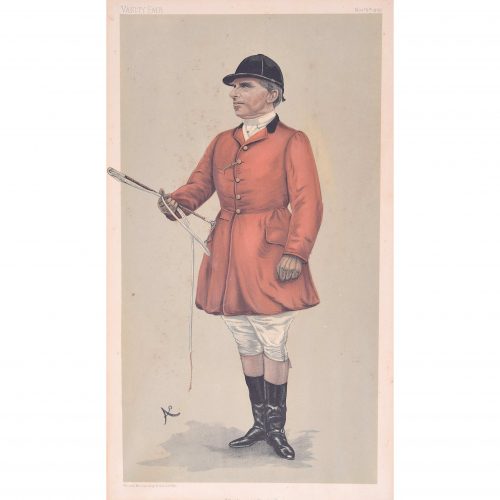
Roland "Ao" / "Armadillo" L'Estrange for Vanity Fair Magazine 'Berks and Bucks': Sir Robert Rodney Wilmot
5 November 1903 Lithograph 21 x 37 cm Depicting Sir Robert Rodney Wilmot, in red hunting clothes and whip, of the Berks & Bucks Draghounds at their opening meet. Wilmot was educated at Eton and Oxford, and his hobbies famously included croquet. The Vanity Fair magazine of 1868 to 1914 was subtitled 'A Weekly Show of Political, Social and Literary Wares'. Founded by Thomas Gibson Bowles, who aimed to expose the contemporary vanities of Victorian society, it featured regular full-page, colour lithographs of famous (or infamous) contemporary figures. It is for these caricatures that the original Vanity Fair is best known today. If you are interested, please email info@manningfineart.co.uk or call us on 07929 749056. Condition: Good. Mounted to board, some age toning. -
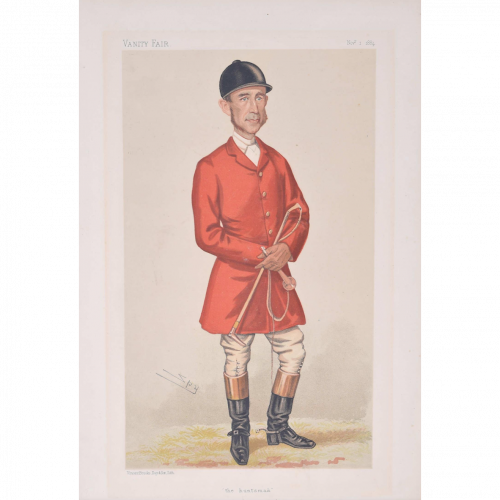
Sir Leslie "Spy" Ward for Vanity Fair Magazine 'The Huntsman': Thomas Firr
1 November 1884 Lithograph 21 x 37 cm Depicting Thomas Firr, Huntsman of the Quorn, on the day of the season's opening meet. The illustrated volume 'Tom Firr of the Quorn: Huntsman Extraordinary' details Firr's days with the hunt, and considers him 'the greatest huntsman in England'. He was huntsman to the Quorn for 27 years from 1872 to 1899. The Quorn Hunt has a claim to be the oldest hunt in the country, having been founded in 1696 by Mr Thomas Boothby of Tooley Park, Leicestershire. Tooley Park lies about eight miles southwest of Leicester, just to the north of the Hinckley road. The hunt takes its name from the village of Quorn, where the hounds were kennelled from 1753 to 1904. If you are interested, please email info@manningfineart.co.uk or call us on 07929 749056. Condition: Good. Mounted to board, some age toning. -
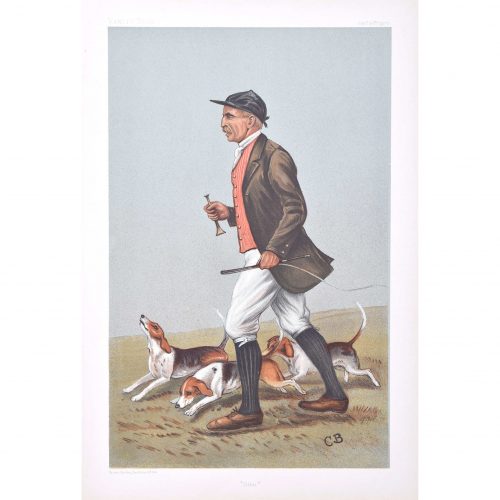
Cuthbert "CB" Bradley for Vanity Fair Magazine 'Otho': Otho Paget
30 January 1902 Lithograph 21 x 37 cm CB's cartoon depicts John Otho Paget, noted beagler and author of 'Beagles and Beagling'. Cuthbert Bradley was also a sporting man - he famously authored 'Fox-Hunting from Shire to Shire with Many Noted Packs' and worked as a sporting journalist for The Field. As well as illustrating for Vanity Fair, he painted polo and foxhunting scenes, and other pictures of equestrian interest. The majority of his Vanity Fair cartoons are of hunting men. The Vanity Fair magazine of 1868 to 1914 was subtitled 'A Weekly Show of Political, Social and Literary Wares'. Founded by Thomas Gibson Bowles, who aimed to expose the contemporary vanities of Victorian society, it featured regular full-page, colour lithographs of famous (or infamous) contemporary figures. It is for these caricatures that the original Vanity Fair is best known today. If you are interested, please email info@manningfineart.co.uk or call us on 07929 749056. Condition: Generally very good. -
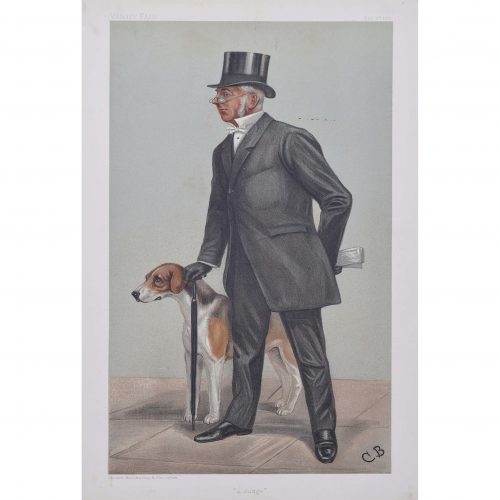
Cuthbert "CB" Bradley for Vanity Fair Magazine 'A Judge': The Rev Cecil Legard
11 July 1901 Lithograph 21 x 37 cm CB's cartoon depicts The Rev Cecil Legard (1843-1918), the Rector of Cottesbrooke and heir to the baronetcy. As well as a clergyman, Legard was a noted sportsman and hound expert; he was a steeplechase rider, and also edited the Foxhound Kennel Stud Book. CB depicts him judging hounds, excellently outfitted; as the biography on the reverse of the mounted lithograph notes, he might be 'the best judge of a foxhound in England'. A copy of the cartoon is held by the Kingston Lacy Estate in Dorset. Cuthbert Bradley was also a sporting man - he famously authored 'Fox-Hunting from Shire to Shire with Many Noted Packs' and worked as a sporting journalist for The Field. As well as illustrating for Vanity Fair, he painted polo and foxhunting scenes, and other pictures of equestrian interest. The majority of his Vanity Fair cartoons are of hunting men. The Vanity Fair magazine of 1868 to 1914 was subtitled 'A Weekly Show of Political, Social and Literary Wares'. Founded by Thomas Gibson Bowles, who aimed to expose the contemporary vanities of Victorian society, it featured regular full-page, colour lithographs of famous (or infamous) contemporary figures. It is for these caricatures that the original Vanity Fair is best known today. If you are interested, please email info@manningfineart.co.uk or call us on 07929 749056. Condition: Generally very good. -
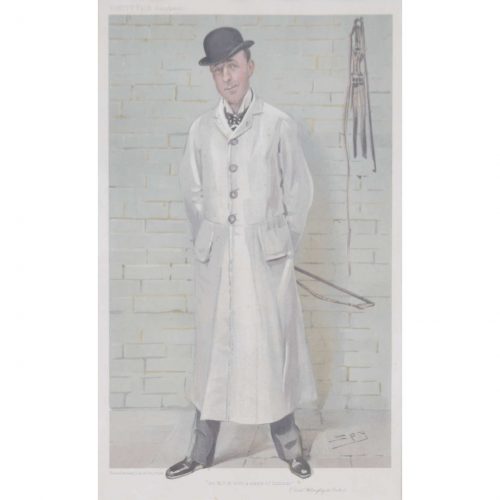
Sir Leslie 'Spy' Ward for Vanity Fair Magazine
An MFH with a sense of humour (1905)
Lithograph 36 x 21 cm Published in Vanity Fair on 23rd November 1905. The 'MFH with a sense of humour' depicted here is Richard Greville Verney, 19th Baron Willoughby de Broke (1869 - 1923), British peer, Conservative politician, and Master of Foxhounds. Verney was the son of Colonel Henry Verney, 18th Baron Willoughby de Broke and Geraldine Smith-Barry, and was educated at Eton College and New College, Oxford. The historian George Dangerfield described Verney as "a genial and sporting young peer, whose face bore a pleasing resemblance to the horse. ... He had quite a gift for writing, thought clearly, and was not more than two hundred years behind his time." He wrote a book on foxhunting called "Hunting the Fox", which was published in 1921 and remains an acclaimed text on the sport today. Verney represented Rugby, Warwickshire, as an MP from 1895–1900. In 1902 he succeeded his father as 19th Baron Willoughby de Broke. Condition: very good. If you’d like to know more, please email info@manningfineart.co.uk or call us on 07929 749056. -
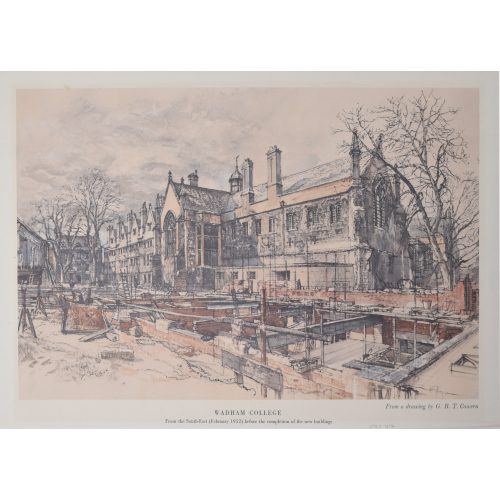
G R T (Raymond Teane) Cowern (1913 - 1986)
Wadham College, Oxford from the South East before the completion of the new buildings (1952)
Lithograph 33 x 46 cm A 1953 lithograph of Wadham during the construction of the college's mid-century buildings. Cowern made his drawing of the quad in 1952 and it was reproduced a year later as a lithograph to be published in the "Oxford Almanack". The Oxford Almanack was an annual almanac published by the Oxford University Press for the University of Oxford from 1674 through 2019 (when printing sadly ceased due to "dwindling interest"). The almanac traditionally included engravings or lithographs of the University and information about the upcoming year. Other almanac artists have included James Basire, Michael Burghers, J. M. W. Turner, and John Piper. G R T Cowern was a British painter, illustrator, and accomplished draughtsman. He was elected a full member of the Royal Academy in 1968. Cowern joined the British Army during the Second World War and served as an intelligence officer and then as a Field Security Officer. Throughout his Army service, Cowern made numerous drawings of his experiences during training and in the Netherlands and Belgium. Several of these works were purchased by the War Artists' Advisory Committee and are now held by the Imperial War Museum in London. Cowern also worked for the Recording Britain project, painting and etching images of historic buildings at risk of destruction in Suffolk, Worcestershire, and Herefordshire. A number of these drawings are now in the collection of the Victoria and Albert Museum. Condition: generally very good, a little discolouration to the paper, and a tear to the margin (which will be hidden under the mount). If you’d like to know more, please email info@manningfineart.co.uk or call us on 07929 749056. -
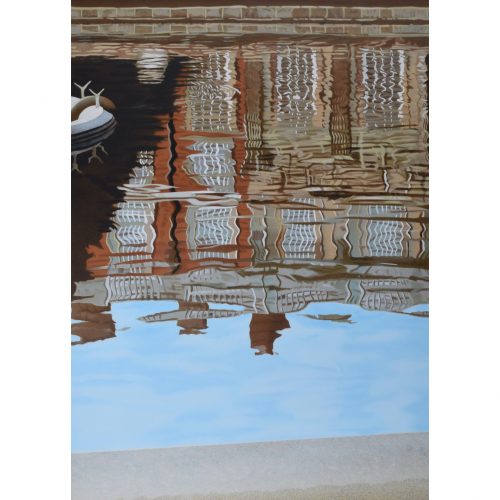
Brendan Neiland (b.1941) R.A. (Expelled)
Hampton Court (1984)
Screenprint 74 x 51 cm Signed, dated, titled, and numbered 152/250 in pencil. A print of one of Hampton Court's magnificent facades, reflected in its fountain. Reflected architecture is one of Neiland's most recurring themes. The Fountain Court was designed by Sir Christopher Wren; he began remodelled the palace in the baroque style for William III and Mary II in 1689. It held private and state apartments for both the King and Queen. Wren’s other works at Hampton Court Palace include the Lower Orangery and the grand colonnade in Clock Court, providing a grand entrance to the King's Apartments. The architectural historian Sir John Summerson described Fountain Court as 'Startling, as of simultaneous exposure to a great many eyes with raised eyebrows'. Brendan Neiland (born 23 October 1941 in Lichfield, Staffordshire) is an English artist best known for his paintings of reflections in modern city buildings. In 1992 he was elected to the Royal Academy (RA). Neiland is known for his interpretations of city life. His work is widely exhibited in major museums and galleries worldwide including, in Britain, the Victoria and Albert Museum, The Tate Gallery London, The Collections of the British Council and the Arts Council of Great Britain. He is represented by the Redfern Gallery and has had numerous shows internationally, including at the Galerie Belvedere in Singapore, who represent him in Singapore and the Far East. Condition: very good. If you’d like to know more, please email info@manningfineart.co.uk or call us on 07929 749056. -

Ebenezer Challis (1806 - 1881)
Sidney Sussex College, Cambridge (1834)
Engraving 27 x 43 cm A 19th century view of Sidney Sussex, complete with Victorian undergraduates in academic dress, horse and cart, and behatted rider. Condition: good. Trimmed. Otherwise generally good with the occasional tiny spot. If you’d like to know more, please email info@manningfineart.co.uk or call us on 07929 749056. Click here for more views of Sidney Sussex. -
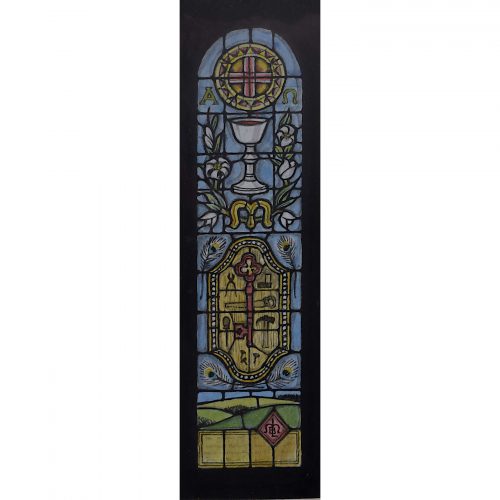
Jane Gray (b.1931)
St Mary’s Church, Sullington, Design for Stained Glass Window (1992)
Watercolour 18 x 5 cmSigned, dated and studio stamp verso.
The little church of St Mary’s, Sullington, has laid nestled beneath the Sussex Downs for almost a thousand years, within the bounds of an even older yew grove. The tower and the nave date back to c.1050 but were altered in the Norman period and again in thee 12th and 13th centuries.This small window pays remembrance to the local carpenter and verger. The design incorporates carpenters’ tools, peacock feathers from the peacocks in the neighbouring Manor House who often joined the church services, the Church’s communion chalice, and a view of the Sussex Downs. This window was installed in 1992.
Provenance: the artist’s studio sale. Literature: Jane Gray, Playing with Rainbows. (Shropshire: Ellingham Press, 2011), pp.51, 82. Condition: very good. If you are interested, please email info@manningfineart.co.uk or call us on 07929 749056. For other works by Jane Gray and more information about her, please click here. -
Out of stock
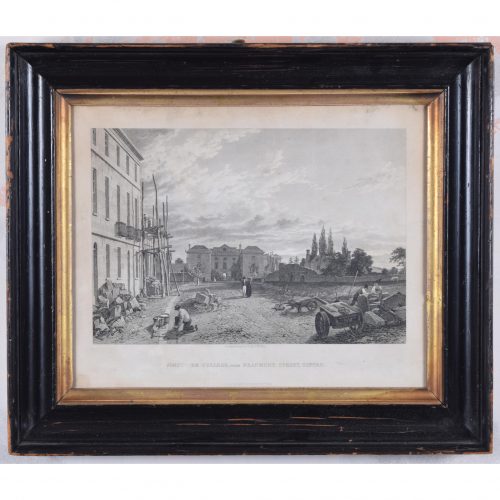
George Hollis (1793 - 1842)
Worcester College Beaumont Street, Oxford (1823)
Engraving 25 x 32 cm A handsome engraving of Worcester College from a Beaumont Street still under construction. The street was laid out in the 1820s and 1830s in the Regency style and acts as a charming approach to Worcester's facade. George Hollis was a well-known Oxford-born artist and engraver. He studied art and worked primarily in Oxford. Many of his engravings, which often depicted the colleges, were published by James Ryman, a print-seller on the High Street. Hollis' views were published separately in a single volume in 1839. Condition: good. Mounted to board; vertical crease; in antique frame. If you are interested, please email info@manningfineart.co.uk or call us on 07929 749056. Click here for other views of Worcester College, Oxford. -
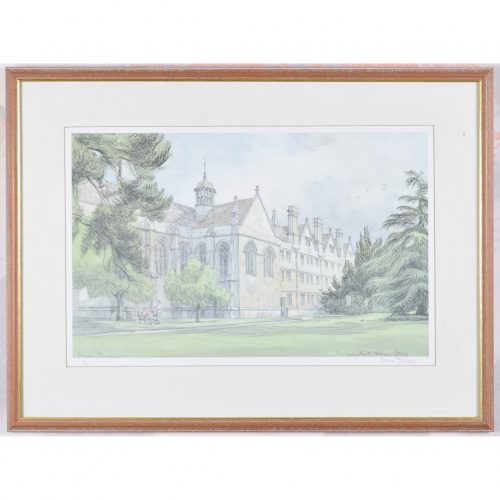
Dennis Flanders (1915 - 1994)
Wadham College, Oxford, Garden Front
Lithograph 30 x 48 cm Numbered 117/500 lower left and signed lower right, both in pencil. Signed lower left and titled lower right in the plate. A tranquil view of Wadham, verdant of grass and leafy of tree. Two undergraduates in jeans and t-shirts chat, laden down with books. Dennis Flanders RBA RWS was a British artist and draughtsman who specialised in pen and ink drawings, often of English landscapes and buildings. He is notable for his meticulous depictions of the impact of aerial bombing upon historic buildings during World War Two. After attending the Merchant Taylors' School, Flanders studied at the Regent Street Polytechnic, St. Martin's School of Art, and at the Central School of Arts and Crafts. Flanders worked at the School of Military Engineering during World War Two and made models of buildings and landscapes based on aerial reconnaissance photographs. He applied for a commission with the War Artists' Advisory Committee and, although he was unsuccessful, the Committee did agree to purchase several drawings from him. These were mostly detailed depictions of bomb-damaged buildings and churches which included views of St Paul's Cathedral and Canterbury Cathedral. After the war, Flanders became a regular exhibitor at the Royal Academy and held his first solo exhibition at Colnaghi in 1947. He illustrated several books and published two volumes of prints from his own drawings of British architecture and landscapes, which had been the dominant theme of his artistic career. Condition: very good. If you are interested, please email info@manningfineart.co.uk or call us on 07929 749056. Click here for other views of Wadham College, Oxford. -
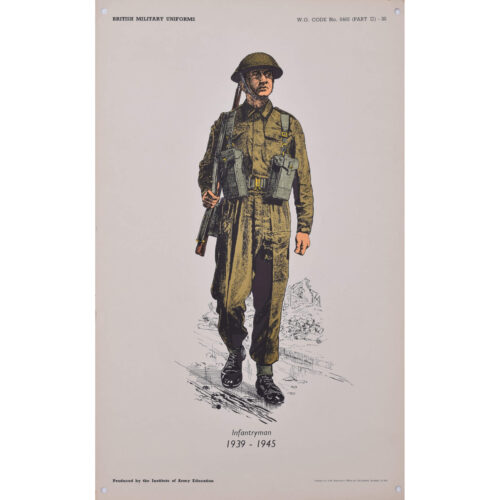
Infantryman 1939 - 1945 uniform
Lithograph 50 x 31 cm Produced for the Institute of Army Education. Printed for HM Stationery Office by I A Limited, Southall 51. These posters were produced by the Institute of Army Education, likely for display in barracks. Created in the 1950s, they illustrate the 'vintage' uniforms worn by the Corps during the First World War. Condition: punched holes to corners as issued; otherwise generally very good. If you are interested, please email info@manningfineart.co.uk or call us on 07929 749056. Click here for other original vintage Institute of Army Education uniform posters. -
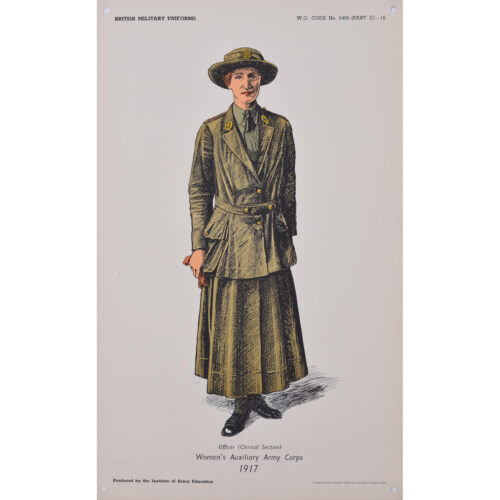
Auxiliary Territorial Service (now the Women's Royal Army Corps) 1939 - 1945 uniform
Lithograph 50 x 31 cm Produced for the Institute of Army Education. Printed for HM Stationery Office by I A Limited, Southall 51. These posters were produced by the Institute of Army Education, likely for display in barracks. Created in the 1950s, they illustrate the 'vintage' uniforms worn by the Corps during the First World War. Condition: punched holes to corners as issued; otherwise generally very good. If you are interested, please email info@manningfineart.co.uk or call us on 07929 749056. Click here for other original vintage Institute of Army Education uniform posters. -
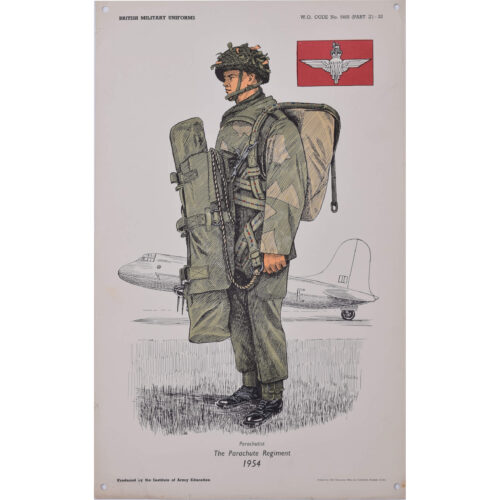
The Parachute Regiment Parachutist 1954 uniform
Lithograph 50 x 31 cm Produced for the Institute of Army Education. Printed for HM Stationery Office by I A Limited, Southall 51. These posters were produced by the Institute of Army Education, likely for display in barracks. Created in the 1950s, they illustrate the 'vintage' uniforms worn by the Corps during the First World War. Condition: punched holes to corners as issued; otherwise generally very good. If you are interested, please email info@manningfineart.co.uk or call us on 07929 749056. Click here for other original vintage Institute of Army Education uniform posters. -

Air France Vacances - Allemagne
Original vintage poster 100 x 66 cm This Air France poster encourages French tourists to travel to Germany. Pictured is the Römer in Frankfurt, a medieval building which has served as the town's city hall for over six hundred years. Condition: generally very good; a few little edge creases top right. If you are interested, please email info@manningfineart.co.uk or call us on 07929 749056. Click here for other original vintage travel posters. -
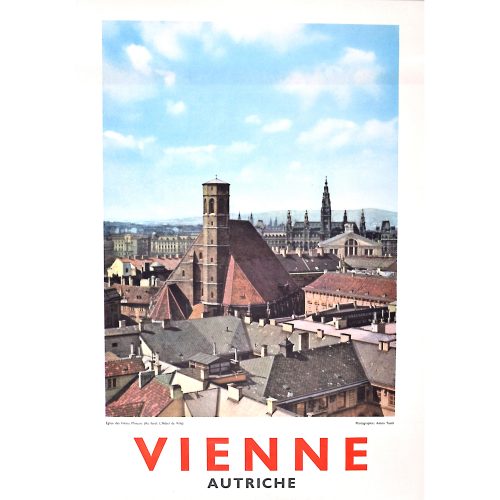
Anton Tusch (photographer) Eglise des Freres Mineurs, Vienna, Austria / Osterreich
Original poster c. 1950s 61x43cm If you are interested email info@manningfineart.co.uk or call us on 07929 749056. Condition: Generally very good. -
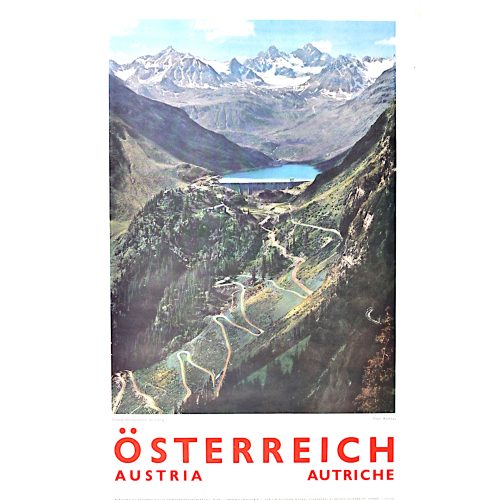
Risch Lau (publisher) Silvretta-Hochalpenstrasse, Vorarlberg, Austria / Osterreich
Original poster c. 1950s 61x43cm If you are interested email info@manningfineart.co.uk or call us on 07929 749056. Condition: Generally very good. -
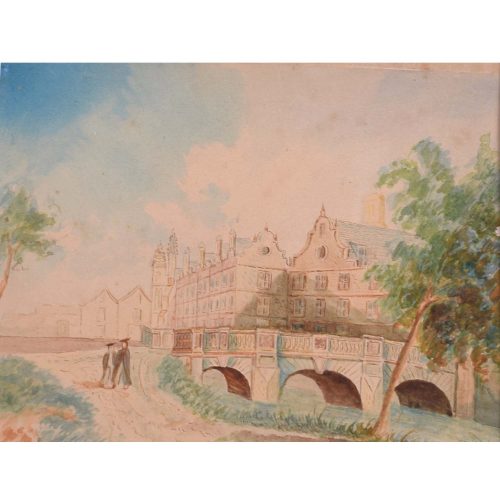
Anonymous
St John’s College, Cambridge
Watercolour and pencil 13x18cm Probably early 19th century. This watercolour depicts St John’s prior to construction of Hutchinson’s 1831 New Court buildings; two figures wearing gowns and square caps are engaged in conversation by the Wren Bridge. If you are interested email info@manningfineart.co.uk or call us on 07929 749056. Condition: Good. -
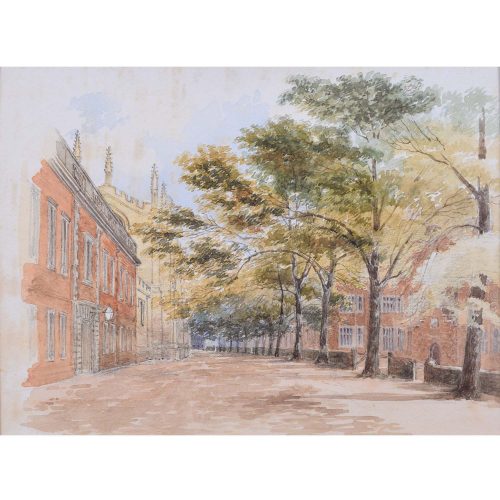
Anonymous Eton College
Watercolour 21.2×28.5cm If you are interested email info@manningfineart.co.ukor call us on 07929 749056. Condition: Good. -

Sutton Nichols (1668 - 1729)
Map of Cambridgeshire
Engraving 43 x 36 cm Signed in plate lower left. A beautifully coloured 18th century map engraving of Cambridgeshire. The map was produced by Robert Morden for publication in Edward Gibson's 1695 translation of William Camden's Britannia, a topographical and historical survey of Great Britain and Ireland produced to "restore antiquity to Britaine, and Britain to his antiquity" - a most noble aim. William Camden (1551 - 1623) was an English antiquarian, historian, topographer, and herald, best known as the author of Britannia, the first chorographical survey of the islands of Great Britain and Ireland, and the Annales, the first detailed historical account of the Queen Elizabeth I's reign. Sutton Nicholls was a draughtsman and engraver best known for his panoramic views of the cities of London and Westminster. Almost all of his engravings were commissioned by publishers. Nicholls specialised in topographical and architectural designs; he also produced many maps, notably illustrating John Strype’s edition of John Stowe’s ‘Survey of London’ in 1720. Condition: good. Mounted to board. If you’d like to know more, please email info@manningfineart.co.uk or call us on 07929 749056. -
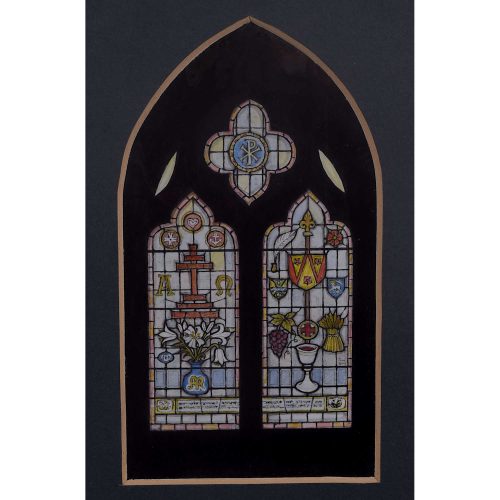
Jane Gray (b.1931)
St Mary’s Church, Penwortham, Lancashire, Design for Stained Glass Window Dedicated to the Royal British Legion (1984)
Watercolour 19.5 x 11 cmDated and artist label verso.
St Mary’s Church, set in the midst of ancient woodland, is the parish church of the Ancient Parish of Penwortham and dates from the 14th century. The church Nave and Chancel contain several memorial windows and tablets sacred to the memory of parishioners who have died; most are Victorian, such as memorial to John Horrocks, a prominent industrialist in the golden age of the Lancashire cotton industry who founded the textile company Horrockses, Miller, & Co., but the North wall features Gray’s traditional design for a window dedicated to the Royal British Legion.
Provenance: the artist’s studio sale. Condition: very good. If you are interested, please email info@manningfineart.co.uk or call us on 07929 749056. For other works by Jane Gray and more information about her, please click here. -
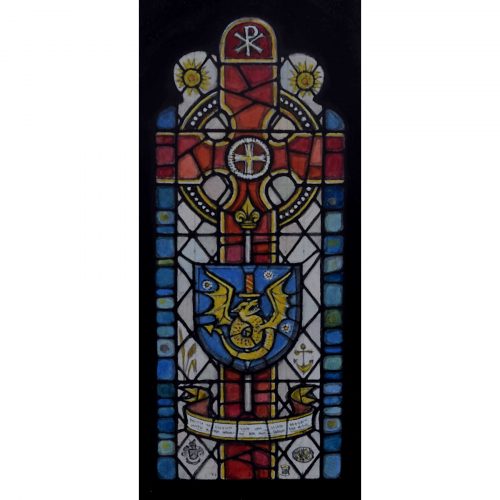
Jane Gray (b.1931)
St Margaret’s Church, Downham, Billericay, Essex, Design for Stained Glass Window
Watercolour 15.5 x 7.5 cmSigned and studio stamp verso.
It is likely that Christians have worshiped at this site for over a thousand years, but it wasn’t until the mid13th century that the first recorded church appeared. The church is dedicated to St Margaret of Antioch, a dragon slayer and patron saint of child bearing. Devotion Saint Margaret of Antioch became popular in the 13th century and there are around 80 churches today that share this dedication from the 13th century. The oldest part of the present church is the tower which dates from c.1470. The nave was rebuilt in the nineteenth century using much of the material from the thirteenth century church. An arson attack in March 1977 resulted in the gutting of the church, resulting in a highly modern interior. This window features the symbol of St Margaret and a red Cross on quarry background. The window was installed in 1988.
Provenance: the artist’s studio sale. Literature: Jane Gray, Playing with Rainbows. (Shropshire: Ellingham Press, 2011), p.79. Condition: very good. If you are interested, please email info@manningfineart.co.uk or call us on 07929 749056. For other works by Jane Gray and more information about her, please click here. -
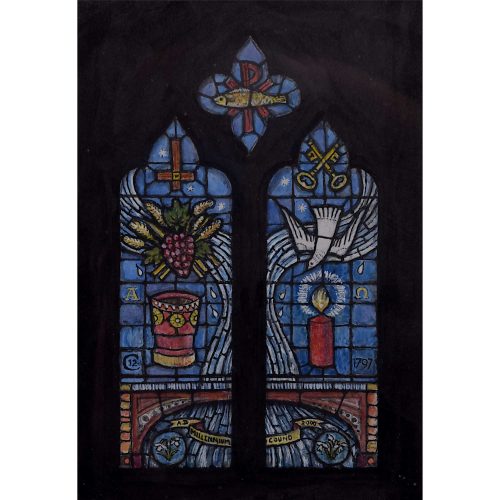
Jane Gray (b.1931)
St Peter’s Church, Cound, Shropshire, Design for Stained Glass Window (1999)
Watercolour 16.5 x 11.5 cmSigned, dated and studio stamp verso.
Proposed design for a window on the south wall, over the font. St Peter’s Church, Cound lies in the grounds of the Cound Hall estate and is dedicated to St Peter because of its medieval association with Shrewsbury Abbey (dedicated to Saints Peter and Paul). The oldest part of the present church dates back to the 13th century but it has been renovated several times since then, with additions from the 14th, 15th and 19th centuries.
Provenance: the artist’s studio sale. Condition: very good. If you are interested, please email info@manningfineart.co.uk or call us on 07929 749056. For other works by Jane Gray and more information about her, please click here. -
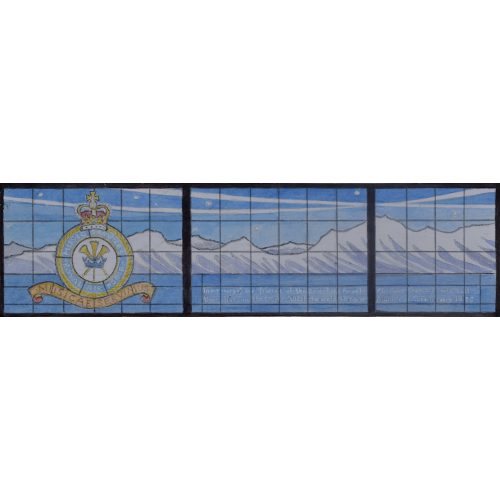
Jane Gray (b.1931)
Royal Airforce Music Services Headquarters, Design for Memorial Stained Glass Window (1985)
Watercolour 6 x 22.5 cmSigned and dated verso.
Gray’s design for this memorial window commemorates the lives of those lost in the Langenbruck bus crash, 11 February 1985, when a double-decker bus carrying 40 musicians from the band of Royal Air Force Germany, crashed on an autobahn between Nuremberg and Munich. Twenty-one of the occupants were killed in the crash. As the text in the design remembers: this window is ‘In memory of our friends of the Band of the Royal Air Force Germany who lost their lives in the tragic Autobahn accident near Munich on 11 February 1985’.
Provenance: the artist’s studio sale. Condition: very good. If you are interested, please email info@manningfineart.co.uk or call us on 07929 749056. For other works by Jane Gray and more information about her, please click here. -
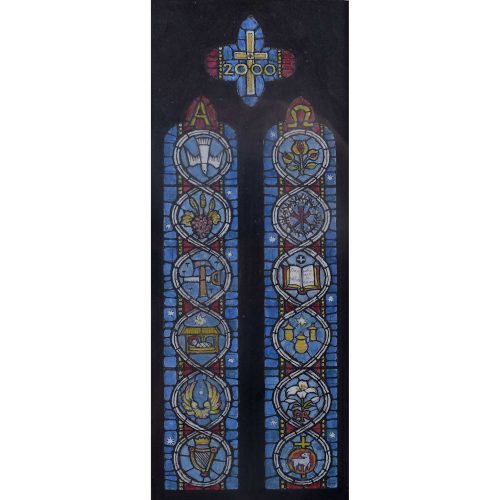
Jane Gray (b.1931)
St Lawrence Church, Weston under Penyard, Design for Stained Glass Window (1999)
Watercolour 21.5 x 8.5 cmSigned, dated and studio stamp verso.
St Catherine’s Church, Penrith is a Puginian Gothic town church, built by Fr George Haydock of Cottam and other Catholic notables in the early 19th century in the 14th century Gothic style. The church and its substantial presbytery, built in 1853, adjoin the churchyard of the Anglican parish church. This window was installed in 1992.
Provenance: the artist’s studio sale. Literature: Jane Gray, Playing with Rainbows. (Shropshire: Ellingham Press, 2011), p.87. Condition: very good. If you are interested, please email info@manningfineart.co.uk or call us on 07929 749056. For other works by Jane Gray and more information about her, please click here. -
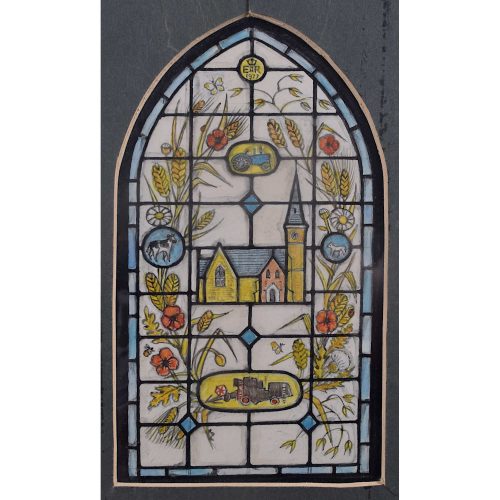
Jane Gray (b.1931)
Gatton Church, nr Redhill, Surrey, Design for Stained Glass Window (1979)
Watercolour 15.5 x 8.5 cmDated, detailed in artist’s hand and studio label verso.
A church has existed in this Surrey parish since the Doomsday Survey in 1086 but the present Church dates back to the 13th century, undergoing extensive alterations in the 18th and early 19th centuries. Notably, in 1834, the pulpit and altar, bought from Nuremberg, were hopefully attributed to Albrecht Dürer; the carved doors had travelled from Rouen; the presbytery stalls from a disestablished monastery in Ghent, the altar rails from Tongeren; and the stained glass for the windows, and the wainscoting of the nave and carved canopies had come from Aarschot, near Leuven. This tiny church window was one of Gray’s smallest commissions. Her brief was to include the church at the heart of the Gatton agricultural community, and she did, supplementing this with illustrations of corn, oats, barley, poppies, bees, butterflies, ladybirds, a caterpillar and a grasshopper, alongside small roundels set amongst these containing a calf, a tractor, and a combine harvester respectively. The window was installed in 1980.
Provenance: the artist’s studio sale. Literature: Jane Gray, Playing with Rainbows. (Shropshire: Ellingham Press, 2011), pp.41, 76. Condition: very good. If you are interested, please email info@manningfineart.co.uk or call us on 07929 749056. For other works by Jane Gray and more information about her, please click here. -
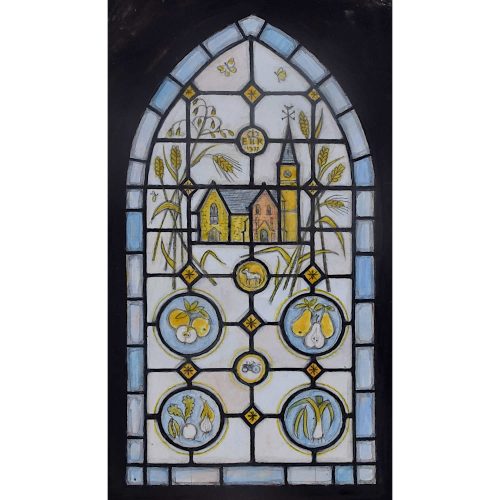
Jane Gray (b.1931)
Gatton Church, nr Redhill, Surrey, Design for Stained Glass Window (1979)
Watercolour 16 x 9 cmA church has existed in this Surrey parish since the Doomsday Survey in 1086 but the present Church dates back to the 13th century, undergoing extensive alterations in the 18th and early 19th centuries. Notably, in 1834, the pulpit and altar, bought from Nuremberg, were hopefully attributed to Albrecht Dürer; the carved doors had travelled from Rouen; the presbytery stalls from a disestablished monastery in Ghent, the altar rails from Tongeren; and the stained glass for the windows, and the wainscoting of the nave and carved canopies had come from Aarschot, near Leuven. This tiny church window was one of Gray’s smallest commissions. Her brief was to include the church at the heart of the Gatton agricultural community, and she did, supplementing this with illustrations of corn, oats, barley, poppies, bees, butterflies, ladybirds, a caterpillar and a grasshopper, alongside small roundels set amongst these containing a calf, a tractor, and a combine harvester respectively. The window was installed in 1980.
Provenance: the artist’s studio sale. Literature: Jane Gray, Playing with Rainbows. (Shropshire: Ellingham Press, 2011), pp.41, 76. Condition: very good. If you are interested, please email info@manningfineart.co.uk or call us on 07929 749056. For other works by Jane Gray and more information about her, please click here. -
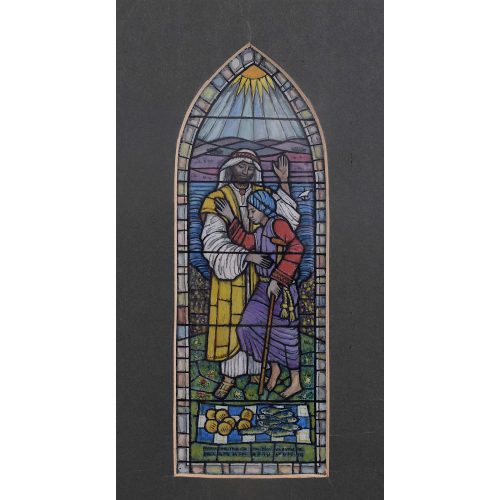
Jane Gray (b.1931)
St Anne’s Church, Copp, Great Eccleston, Design for Stained Glass Window (1979)
Watercolour 19 x 6.5 cm Studio label verso.A chapel was first built at Copp in 1723 for the members of St. Michaels on Wyre Church and Kirkham Church who were too far from their parish churches. Elswick Chapel would have been ideal for the purpose, but as it was in the hands of dissenters the bishop of the time, Bishop Gastrall, decided a new building would be preferable. On May 13th, 1723, a deed was drawn up arranging for three men to rent a piece of land (known as Higher Cop) for one peppercorn a year to build a new chapel. St. Anne's Chapel was built that same year. It wasn’t until 1849, however, that Copp Parish was formed by an Order in Council at Queen Victoria's court at Windsor. The church was completely restored in 1884, the outside transformed by building over it in Yorkshire stone, and the tower raised to 45ft. This window design centres on the scene of Christ healing a lame man and features symbolic images of loaves and fishes. The window was installed in 1979.
Provenance: the artist’s studio sale. Literature: Jane Gray, Playing with Rainbows. (Shropshire: Ellingham Press, 2011), p.75. Condition: very good. If you are interested, please email info@manningfineart.co.uk or call us on 07929 749056. For other works by Jane Gray and more information about her, please click here. -
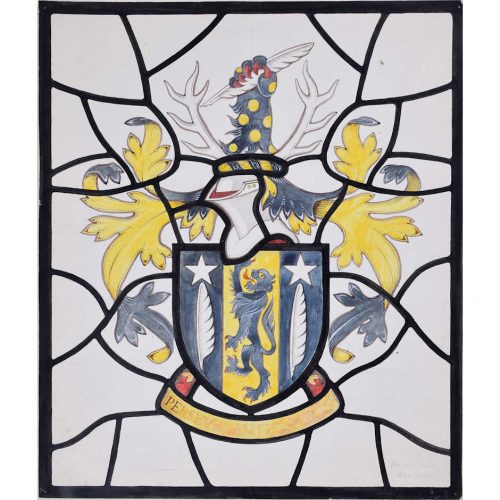
Jane Gray (b.1931)
Gilmour Coat of Arms, Stained Glass Window Design
Watercolour38.5 x 32.5 cm
Signed versoThe Gilmours are part of clan Morrison of the Isle of Lewis, and the first documented bearer of this surname was Richard Gilemore, who was recorded in the Feet of Fines of Huntindonshire in 1228 AD. The family mottoes include, as Gray uses here, Perseveranti dabitur, meaning ‘It will be given to the persevering’.
Provenance: the artist’s studio sale. Condition: very good. If you are interested, please email info@manningfineart.co.uk or call us on 07929 749056. For other works by Jane Gray and more information about her, please click here. -
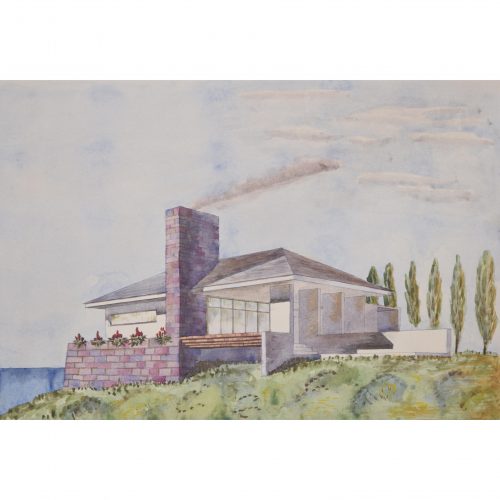
S Clapham (active 1940 - 1960)
Design for Modernist Seaside House
Watercolour 27 x 40 cm Signed lower left and inscribed to reverse. Clapham's designs for a modernist war memorial to be erected in a training area at an army base. Clapham was an architect based in Stockwell in London. Condition: very good. If you are interested, please email info@manningfineart.co.uk or call us on 07929 749056. Click here for other works by the artist. -
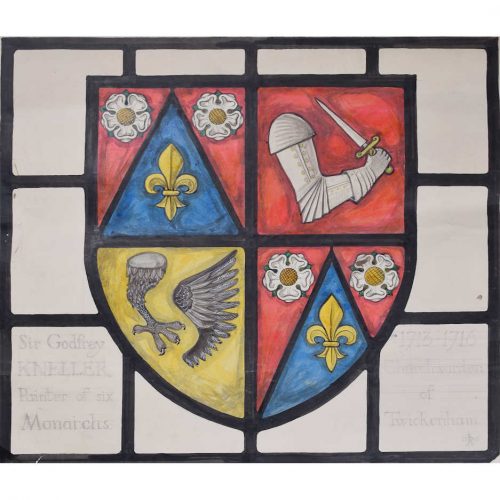
Jane Gray (b.1931)
Sir Godfrey Kneller Stained Glass Window Design, St Mary’s Church, Twickenham (1961)
Watercolour42 x 48.5 cm
Signed and dated l.r.This stained glass window design is one of a handful Gray designed for her local church, St Mary’s Twickenham. St Mary’s Church stands on the site of an earlier church in Twickenham, a short distance from York House and the banks of the River Thames, and incorporates a 15th-century, medieval tower. St Mary's has an impressive and illustrious history of notable parishioners including the painter Godfrey Kneller who, after the collapse of the ancient church's 14th-century nave in 1714, took active involvement in redesigning the church in the Neo-classical style alongside local architect John James, as well as Henry Fielding and Alfred Lord Tennyson whose sons were both baptised here. Gray had a personal connection to St Mary’s, her great grandfather having been the vicar some years before. This design, in particular, commemorates Godfrey Kneller and his active involvement in the church and its redesign in the eighteenth century.
Provenance: the artist’s studio sale. Condition: very good. If you are interested, please email info@manningfineart.co.uk or call us on 07929 749056. For other works by Jane Gray and more information about her, please click here. -
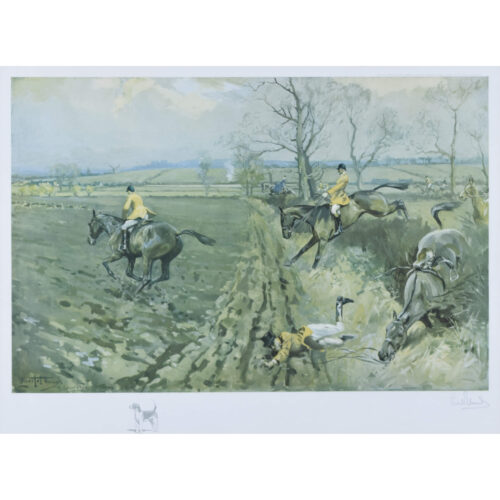
Lionel Edwards (1878 - 1966)
The Belvoir Hunt (1928)
Lithograph 31 x 51 cm Signed and dated in plate lower left, and in pencil outside plate lower left. A Lionel Edwards lithograph depicting the Belvoir - part of the artist's 'Hunting Countries' series. The Belvoir Hunt, sometimes known as the Duke of Rutland's Hounds, dates from 1750 and became a foxhound pack in 1762. Since then, the kennels have been located at Belvoir Castle. Lionel Edwards was a British artist who specialised in pictures of country life, particularly horses, and provided illustrations for Country Life. He is best known for his hunting scenes but also painted pictures of horse racing, shooting and fishing. Condition: print good; original handsome period frame; small area of loss to top of frame. If you are interested, please email info@manningfineart.co.uk or call us on 07929 749056. Click here for other hunting pictures. -
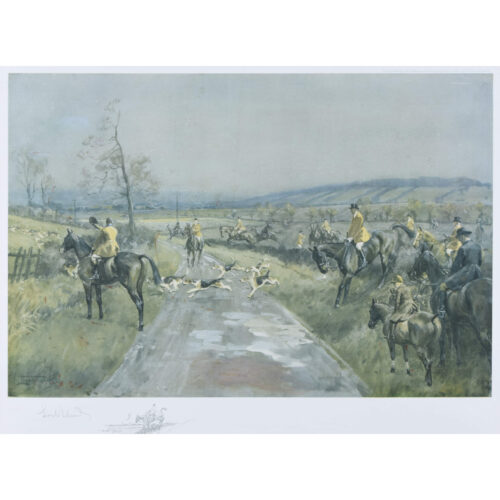
Lionel Edwards (1878 - 1966)
The South Notts Hunt (1928)
Lithograph 31 x 51 cm Signed and dated in plate lower left, and in pencil outside plate lower left. Note to reverse (1988) identifies those illustrated. A Lionel Edwards lithograph depicting the South Notts Hunt - part of the artist's 'Hunting Countries' series. The South Notts country lies in Nottinghamshire and Derbyshire and has been hunted as far back as 1677 by the Earl of Lincoln. In 1775 it was hunted by John Musters, the great-grandfather of John Chaworth-Musters, and in 1860 Mr. John Chaworth-Musters re-established the hunt. Lionel Edwards was a British artist who specialised in pictures of country life, particularly horses, and provided illustrations for Country Life. He is best known for his hunting scenes but also painted pictures of horse racing, shooting and fishing. Condition: print good; original handsome period frame. If you are interested, please email info@manningfineart.co.uk or call us on 07929 749056. Click here for other hunting pictures. -
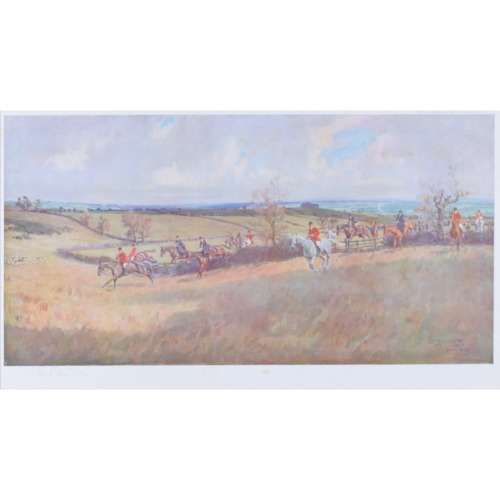
Lionel Edwards (1878 - 1966)
The Quorn Hunt (1934)
Lithograph 34 x 62 cm Signed, titled and dated in plate lower right. Signed in pencil outside plate lower left. A Lionel Edwards lithograph depicting the Quorn - part of the artist's 'Hunting Countries' series. The Quorn Hunt has a claim to be the oldest hunt in the country, being founded in 1696 by Mr Thomas Boothby of Tooley Park, Leicestershire. The hunt takes its name from the village of Quorn, where the hounds were kennelled from 1753 to 1904. Lionel Edwards was a British artist who specialised in pictures of country life, particularly horses, and provided illustrations for Country Life. He is best known for his hunting scenes but also painted pictures of horse racing, shooting and fishing. Condition: print generally good; a couple of very small brown spots. Original 3/4" black frame in generally good condition. If you are interested, please email info@manningfineart.co.uk or call us on 07929 749056. Click here for other hunting pictures. -
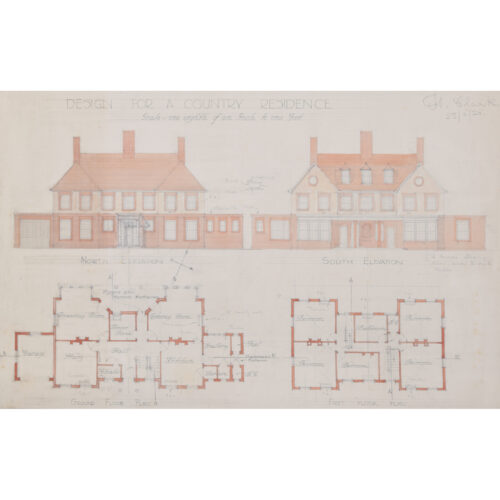
H Clark
Design for a Country Residence (1925)
Pencil and wash 36 x 54 cm An excellent 1925 design for a country house. Clark uses a wash to depict the warm red of the bricks in his design. Condition: mostly very good; old, soft crease to top left. If you are interested, please email info@manningfineart.co.uk or call us on 07929 749056. Click here for more architectural designs. -
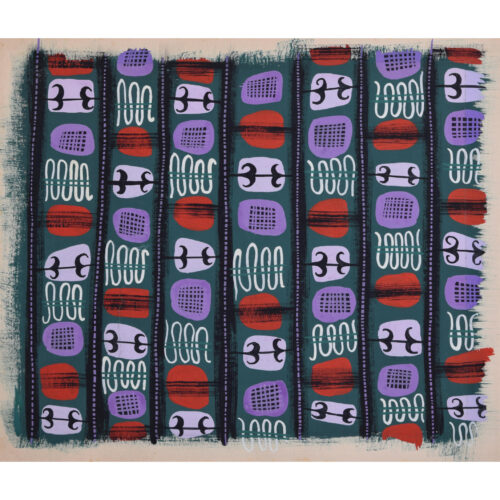
Raymond Weston
Fabric design
Gouache 32 x 37 cm Label to reverse. A fabric design for a dress, produced by a student at the Loughborough College of Art. The colours and forms suggest a mid-century design; the label to the reverse indicates that it would have been machine printed on silk, to be made into a dress. Condition: generally very good. If you are interested, please email info@manningfineart.co.uk or call us on 07929 749056. -

William Kip (active 1598 - 1610) after Christopher Saxton (1540 - 1610)
Map of Cambridgeshire (1637)
Engraving with later hand colouring 29 x 32 cm An antique map of Cambridgeshire. The map was originally published in William Camden's atlas 'Britannia', which was first published in 1586. William Kip was a goldsmith and map engraver. He was born in Utrecht in the Netherlands and moved to London to pursue his career as an engraver. Alongside William Hole, Kip re-engraved Christopher Saxton's 1574 county maps for publication in Camden's 'Britannia', and it is this venture for which he is most well-known. Christopher Saxton was an English cartographer who produced the first county maps of England and Wales. Between 1574 and 1578 he engraved maps of every county in Britain, and compiled them into an atlas in 1579. These maps bore Queen Elizabeth I's arms as well as those of Saxton's patron, Thomas Seckford. Condition: generally good; faint evidence of old staining. If you are interested, please email info@manningfineart.co.uk or call us on 07929 749056. Click here for more maps and general pictures of Cambridge. -
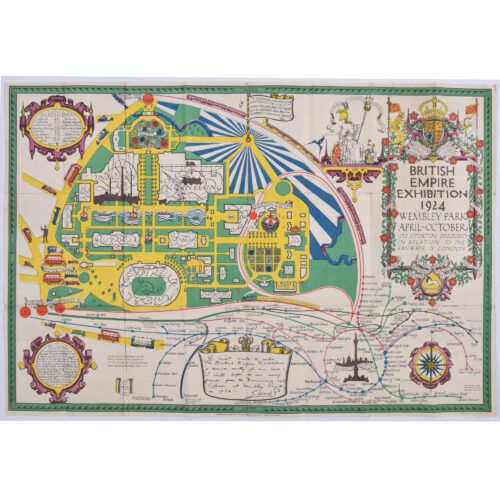
Stanley Kennedy North (1887 - 1942)
British Empire Exhibition Map (1924)
Lithograph 51 x 75 cm This fascinating and attractive map with elaborate cartouche highlights the attractions of the British Empire Exhibition, a showcase held in London to exhibit the fruits of Britain's overseas colonies. It was designed to boost support for the Empire's activities, encourage trade of imperial goods, and remind other world powers of Britain's (historic) colonial capacity. The Empire Stadium was built especially to house the exhibition; it is known today as Wembley Stadium. The exhibition was opened by King George V on St George's Day, 1924. Condition: generally good; folds as issued; a few short tears at corners. If you are interested, please email info@manningfineart.co.uk or call us on 07929 749056. Click here for other original vintage posters. -
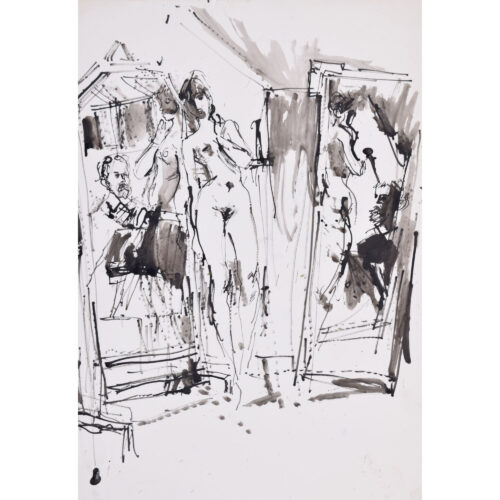
Peter Collins ARCA (1923 - 2001)
Self-Portrait in Two Mirrors with Nude
Ink and wash 45 x 30 cm Provenance: the artist's studio sale. Collins simultaneously depicts himself painting, and reflected painting - his face is repeated in the two mirrors, and the model's figure appears three times. The picture's perspective leaves us questioning which model, and perhaps which Collins, is the real one. Collins's first job was at an advertising agency, in the commercial studio. World War II interrupted his career and he joined the Royal Artillery (of the British Army), teaching painting and drawing in the Education Corps - whilst simultaneously teaching at St Martin's School of Art, part time. Following the war, Collins studied at the Royal College of Art, winning a scholarship. He then worked as a commercial artist, producing some well-known posters for clients including British Railways and British European Airways. He was the Art Director at Odhams Press and spent time designing for both ICI and Shell. With his wife Georgette, he created the 'Bacombe Galleries' in Sussex, converting a group of buildings into a gallery space. In 1975 they developed the Stanley Studios in Chelsea, which were scheduled for redevelopment, into a combined artists' studio and residence. Moving into the Stanley Studios allowed the Collinses to immerse themselves in Chelsea's art scene, and they proceeded to fill the studios with art, antiques, sculpture, and other curios. Condition: generally very good. If you are interested, please email info@manningfineart.co.uk or call us on 07929 749056. Click here for other nudes. -
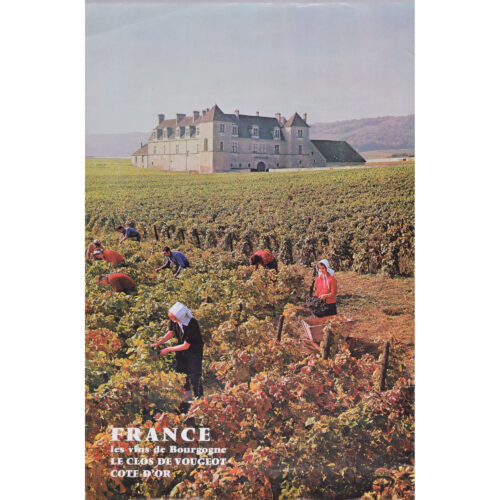
France - les vins de Bourgogne Le Clos de Vougeot Cote d'Or
Original vintage poster 61 x 40 cm An original poster depicting the Château du Clos de Vougeot vineyard in Burgundy during the grape harvest. Men and women pick the grapes outside the Château. Standing in the very heart of Burgundy's vineyards, Clos de Vougeot was originally a wine farm, built in the 12th century by monks from the nearby Abbey of Cîteaux. In the 16th century, a Renaissance style château was added to the existing buildings. Even though the Chateau du Clos de Vougeot does not produce wine anymore, it stays the symbol of a millenary of Burgundy's History. Condition: generally very good, small crease to top corner. If you are interested, please email info@manningfineart.co.uk or call us on 07929 749056. Click here for more original vintage posters. -

Austria Österreich - St Wolfgang am Wolfgangsee
Original vintage poster 61 x 43 cm St. Wolfgang im Salzkammergut is an Austrian market town east of Salzburg, named after Saint Wolfgang of Regensburg. This sunny poster encourages us to visit - and perhaps to lunch by Lake Wolfgangsee. Condition: generally very good; a few very small edge losses to right hand. If you are interested, please email info@manningfineart.co.uk or call us on 07929 749056. Click here for other original vintage travel posters. -
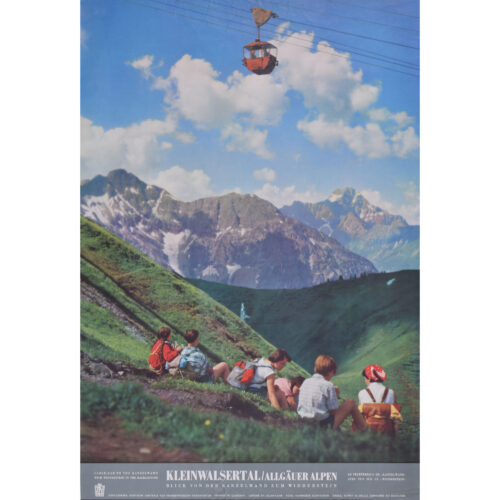
Kleinwalsertal Allgauer Alpen
Original vintage poster 74 x 50 cm This bright 1970s poster encourages us to tour to Austria and ride the cable car up to the Kanzelwand (a mountain on the border between Vorarlberg, Austria and Bavaria, Germany). Here, a charming family of hikers gaze up at the cable car as it crosses overhead. Condition: generally very good; one or two little creases to bottom. If you are interested, please email info@manningfineart.co.uk or call us on 07929 749056. Click here for other original vintage travel posters. -
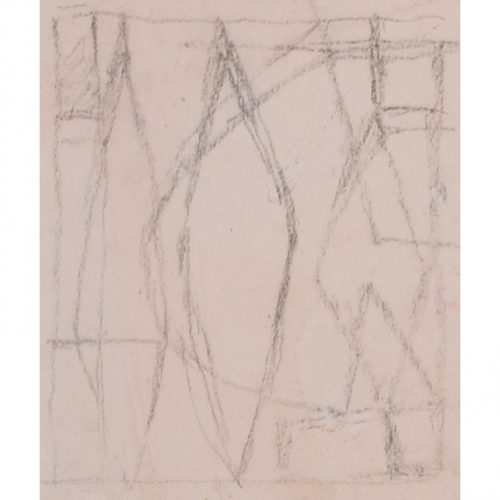
Clifford Ellis
Untitled III
Pencil drawing 13x16cm Provenance: the family of the artist, by descent. Click here for biographical details and other works by the artist. If you are interested email info@manningfineart.co.uk or call us on 07929 749056. -
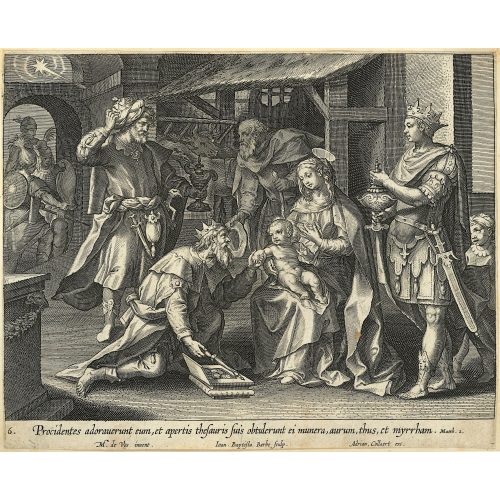
Jean Baptist Barbé (1578?-1649) Adriaen Collaert (c. 1560-1618) after Maerten de Vos (1532 - 1603) 6. "Procidentes adoravuerunt eum, et apertis thesauris suis obtulerunt ei munera, aurum, thus, et myrrham" - Matth 2
Engraving From Vita, Passio, et Resurrectio Iesu Christi first published 1598, this a later edition published by Joannes Galle (1600-1676) 16.5x21.8cm From the Gospel of Matthew, Chapter 2 Verse 11 - and fell down and worshipped him: and when they had opened their treasures, they presented unto him gifts; gold, and frankincense and myrrh. The star hangs over the stable door, as the three Magi present their treasures to Our Lord, sitting upon Mary's knee, St Joseph in attendance behind. Adriaen Collaert was born in Antwerp between 1555 and 1565, becoming wijnmeester of the Guild of St Luke in 1580 - a title reserved for the sons of guild members. The guild of St Luke was generally the city guild for artists. Working for Philip Galle, a Dutch publisher best known for his old master prints, he married Galle's daughter Justa. After learning the principles of engraving in the Netherlands, he spent some years in Italy improving his skill. Upon returning to Flanders he engraved, in accomplished fashion, a great number of plates. His brother, Jan Collaert II, his son, Jan Baptist Collaert II and a grandson were all printmakers. These particular plates are after paintings by Maerten de Vos, a Flemish painter and draughtsman. His father was Pieter de Vos, from whom he learned. From 1550 - 1558 he travelled in Italy, visiting Rome and Venice and becoming master of the Antwerp Guild of St Luke upon his return in 1558. After 1575 he was mainly engaged in producing print designs. If you are interested email info@manningfineart.co.uk or call us on 07929 749056. Condition: Trimmed to plate margins, generally good condition commensurate with age, slight age toning and handling marks as evident from image. -
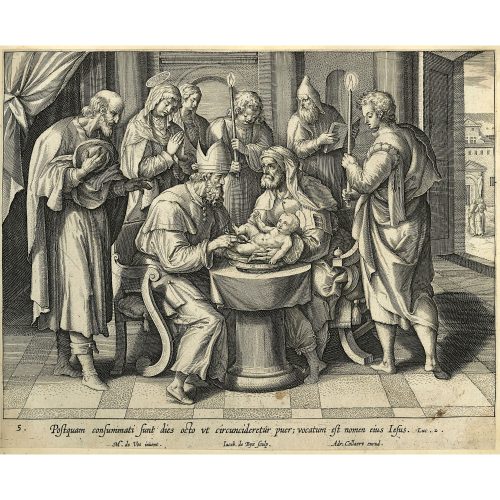
Adriaen Collaert (c. 1560-1618) after Maerten de Vos (1532 - 1603) 5. "Postquam consummati sunt dies octo ut circuncideretur puer; vocatum est nomen eius Iesus" - Luke 2
Engraving, From Vita, Passio, et Resurrectio Iesu Christi first published 1598, this a later edition published by Joannes Galle (1600-1676) 16.5x21.8cm From the Gospel of Luke, Chapter 2 Verse 21 - And when eight days were accomplished for the circumcising of the child, his name was called Jesus. Adriaen Collaert was born in Antwerp between 1555 and 1565, becoming wijnmeester of the Guild of St Luke in 1580 - a title reserved for the sons of guild members. The guild of St Luke was generally the city guild for artists. Working for Philip Galle, a Dutch publisher best known for his old master prints, he married Galle's daughter Justa. After learning the principles of engraving in the Netherlands, he spent some years in Italy improving his skill. Upon returning to Flanders he engraved, in accomplished fashion, a great number of plates. His brother, Jan Collaert II, his son, Jan Baptist Collaert II and a grandson were all printmakers. These particular plates are after paintings by Maerten de Vos, a Flemish painter and draughtsman. His father was Pieter de Vos, from whom he learned. From 1550 - 1558 he travelled in Italy, visiting Rome and Venice and becoming master of the Antwerp Guild of St Luke upon his return in 1558. After 1575 he was mainly engaged in producing print designs. If you are interested email info@manningfineart.co.uk or call us on 07929 749056. Condition: Trimmed to plate margins, generally good condition commensurate with age, slight age toning and handling marks as evident from image. -
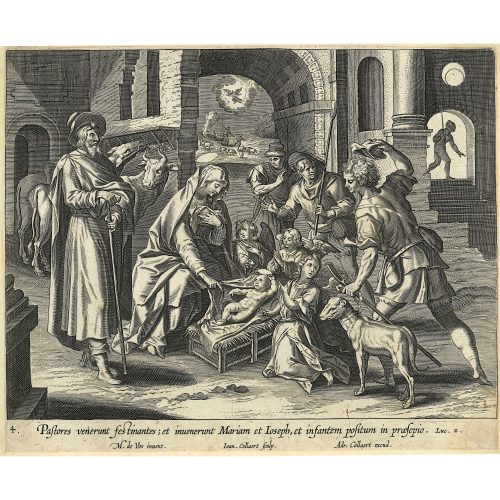
Adriaen Collaert (c. 1560-1618) after Maerten de Vos (1532 - 1603) "Pastores venerunt festinantes; et inuenerunt Mariam et Ioseph, et infantem positum in praesepio" - Luke 2
Engraving, From Vita, Passio, et Resurrectio Iesu Christi first published 1598, this a later edition published by Joannes Galle (1600-1676) 16.5x21.8cm From the Gospel of Luke, Chapter 2 Verse 16 - And the shepherds came with haste, and found Mary, and Joseph, and the babe lying in a manger. Adriaen Collaert was born in Antwerp between 1555 and 1565, becoming wijnmeester of the Guild of St Luke in 1580 - a title reserved for the sons of guild members. The guild of St Luke was generally the city guild for artists. Working for Philip Galle, a Dutch publisher best known for his old master prints, he married Galle's daughter Justa. After learning the principles of engraving in the Netherlands, he spent some years in Italy improving his skill. Upon returning to Flanders he engraved, in accomplished fashion, a great number of plates. His brother, Jan Collaert II, his son, Jan Baptist Collaert II and a grandson were all printmakers. These particular plates are after paintings by Maerten de Vos, a Flemish painter and draughtsman. His father was Pieter de Vos, from whom he learned. From 1550 - 1558 he travelled in Italy, visiting Rome and Venice and becoming master of the Antwerp Guild of St Luke upon his return in 1558. After 1575 he was mainly engaged in producing print designs. If you are interested email info@manningfineart.co.uk or call us on 07929 749056. Condition: Trimmed to plate margins, generally good condition commensurate with age, slight age toning and handling marks as evident from image. -
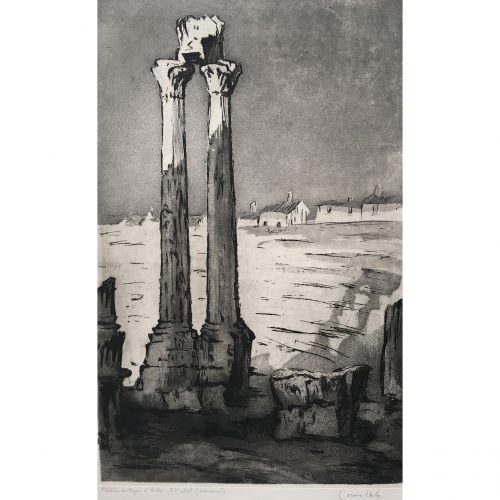
Louise Ibels (1891-1965) 'Théâtre Antique à Arles'
Etching and aquatint Signed and titled in pencil to margin 3rd state proof Approx. 39 x 25cm (plate) A French artist known for her charming etchings, here she captures the romance of the Roman Theatre in Arles. Built at the time of Augustus (27BC-14AD) it had seating for 8,000 across thirty-three tiers of steps. During the early Middle Ages it was plundered for its stone to build the town walls. These days the only part of the rear wall of the stage that survives are the two columns depicted in the print. Re-emphasised by the presence of their shadow, the rest of the view disappears softly into the distant background. If you are interested email info@manningfineart.co.uk or call us on 07929 749056. Condition: Excellent. -
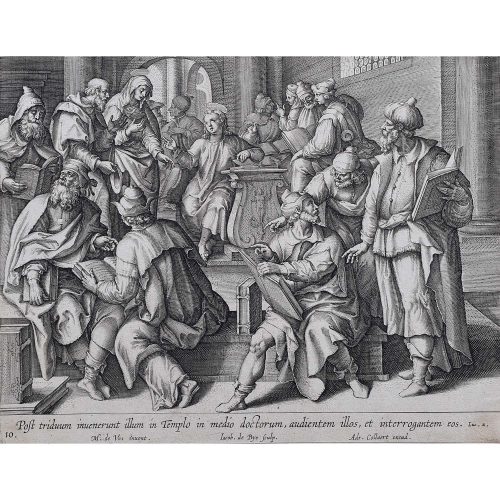
Jean Baptist Barbé (1578?-1649) Adriaen Collaert (c. 1560-1618) after Maerten de Vos (1532 - 1603) 10. Post triduum invenerunt illum in templo in medio doctorum, audientem illos, et interrogante eos. Luc. 2
Engraving From Vita, Passio, et Resurrectio Iesu Christi first published 1598, this a later edition published by Joannes Galle (1600-1676) 16.5x21.8cm From the Gospel of Luke, Chapter 2 After three days they found him in the temple among the doctors, listening to them and asking them questions. Adriaen Collaert was born in Antwerp between 1555 and 1565, becoming wijnmeester of the Guild of St Luke in 1580 - a title reserved for the sons of guild members. The guild of St Luke was generally the city guild for artists. Working for Philip Galle, a Dutch publisher best known for his old master prints, he married Galle's daughter Justa. After learning the principles of engraving in the Netherlands, he spent some years in Italy improving his skill. Upon returning to Flanders he engraved, in accomplished fashion, a great number of plates. His brother, Jan Collaert II, his son, Jan Baptist Collaert II and a grandson were all printmakers. These particular plates are after paintings by Maerten de Vos, a Flemish painter and draughtsman. His father was Pieter de Vos, from whom he learned. From 1550 - 1558 he travelled in Italy, visiting Rome and Venice and becoming master of the Antwerp Guild of St Luke upon his return in 1558. After 1575 he was mainly engaged in producing print designs. If you are interested email info@manningfineart.co.uk or call us on 07929 749056. Condition: Trimmed to plate margins, generally good condition commensurate with age, slight age toning and handling marks as evident from image. -
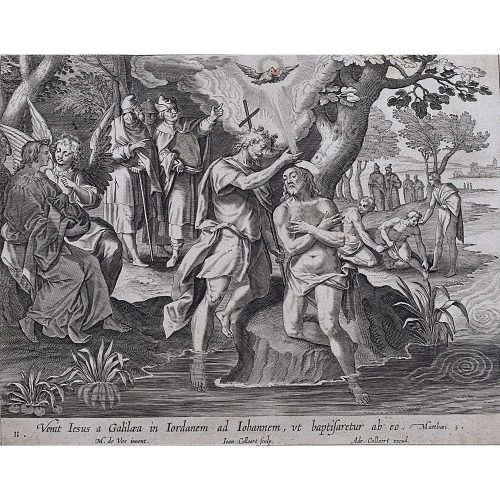
Jean Baptist Barbé (1578?-1649) Adriaen Collaert (c. 1560-1618) after Maerten de Vos (1532 - 1603) 11. Verit Iesus a Galilaea in Iordanem ad Iohannem, vt baptifartur ab eo. Matthew. 3.
Engraving From Vita, Passio, et Resurrectio Iesu Christi first published 1598, this a later edition published by Joannes Galle (1600-1676) 16.5x21.8cm From the Gospel of Matthew, chapter 3 "Then Jesus came from Galilee to the Jordan to be baptized by John." Adriaen Collaert was born in Antwerp between 1555 and 1565, becoming wijnmeester of the Guild of St Luke in 1580 - a title reserved for the sons of guild members. The guild of St Luke was generally the city guild for artists. Working for Philip Galle, a Dutch publisher best known for his old master prints, he married Galle's daughter Justa. After learning the principles of engraving in the Netherlands, he spent some years in Italy improving his skill. Upon returning to Flanders he engraved, in accomplished fashion, a great number of plates. His brother, Jan Collaert II, his son, Jan Baptist Collaert II and a grandson were all printmakers. These particular plates are after paintings by Maerten de Vos, a Flemish painter and draughtsman. His father was Pieter de Vos, from whom he learned. From 1550 - 1558 he travelled in Italy, visiting Rome and Venice and becoming master of the Antwerp Guild of St Luke upon his return in 1558. After 1575 he was mainly engaged in producing print designs. If you are interested email info@manningfineart.co.uk or call us on 07929 749056. Condition: Trimmed to plate margins, generally good condition commensurate with age, slight age toning and handling marks as evident from image. -
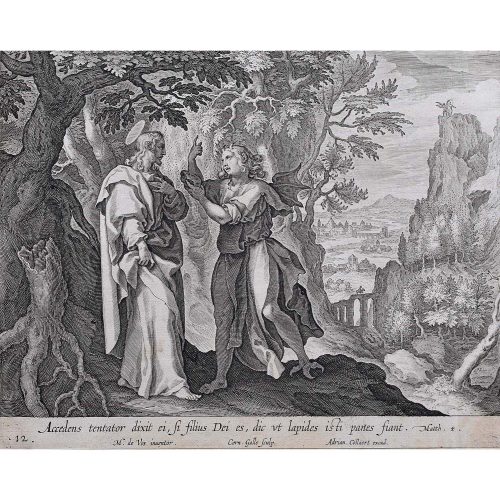
Jean Baptist Barbé (1578?-1649) Adriaen Collaert (c. 1560-1618) after Maerten de Vos (1532 - 1603) 12. Accedens tentator dixit ei fi lius, Dei es, dic vt lapides isti panes fiant. Matt. 4.
Engraving From Vita, Passio, et Resurrectio Iesu Christi first published 1598, this a later edition published by Joannes Galle (1600-1676) 16.5x21.8cm From the Gospel of Matthew, chapter 4 "If thou be the Son of God, command that these stones be made bread" Adriaen Collaert was born in Antwerp between 1555 and 1565, becoming wijnmeester of the Guild of St Luke in 1580 - a title reserved for the sons of guild members. The guild of St Luke was generally the city guild for artists. Working for Philip Galle, a Dutch publisher best known for his old master prints, he married Galle's daughter Justa. After learning the principles of engraving in the Netherlands, he spent some years in Italy improving his skill. Upon returning to Flanders he engraved, in accomplished fashion, a great number of plates. His brother, Jan Collaert II, his son, Jan Baptist Collaert II and a grandson were all printmakers. These particular plates are after paintings by Maerten de Vos, a Flemish painter and draughtsman. His father was Pieter de Vos, from whom he learned. From 1550 - 1558 he travelled in Italy, visiting Rome and Venice and becoming master of the Antwerp Guild of St Luke upon his return in 1558. After 1575 he was mainly engaged in producing print designs. If you are interested email info@manningfineart.co.uk or call us on 07929 749056. Condition: Trimmed to plate margins, generally good condition commensurate with age, slight age toning and handling marks as evident from image. -
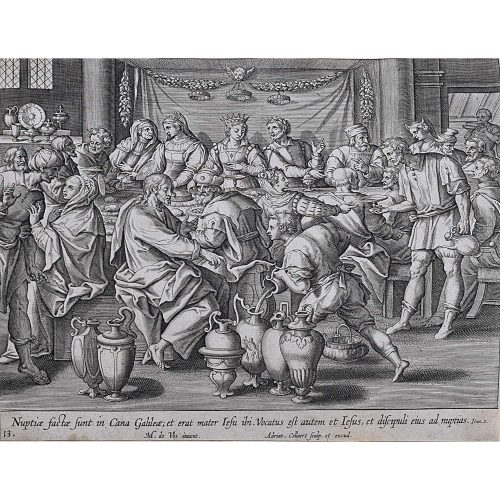
Jean Baptist Barbé (1578?-1649) Adriaen Collaert (c. 1560-1618) after Maerten de Vos (1532 - 1603) 13. nuptia facta sunt in cana galilaeae; et erat mater Iefu ibi. Vocatus eft autem et Iefus, et difcipuli eius ad nuptias. Ioan. 2.
Engraving From Vita, Passio, et Resurrectio Iesu Christi first published 1598, this a later edition published by Joannes Galle (1600-1676) 16.5x21.8cm From the Gospel of John, chapter 2 "On the third day a wedding took place at Cana in Galilee. Jesus’ mother was there, and Jesus and His disciples had also been invited to the wedding. When the wine ran out, Jesus’ mother said to Him, “They have no more wine." Adriaen Collaert was born in Antwerp between 1555 and 1565, becoming wijnmeester of the Guild of St Luke in 1580 - a title reserved for the sons of guild members. The guild of St Luke was generally the city guild for artists. Working for Philip Galle, a Dutch publisher best known for his old master prints, he married Galle's daughter Justa. After learning the principles of engraving in the Netherlands, he spent some years in Italy improving his skill. Upon returning to Flanders he engraved, in accomplished fashion, a great number of plates. His brother, Jan Collaert II, his son, Jan Baptist Collaert II and a grandson were all printmakers. These particular plates are after paintings by Maerten de Vos, a Flemish painter and draughtsman. His father was Pieter de Vos, from whom he learned. From 1550 - 1558 he travelled in Italy, visiting Rome and Venice and becoming master of the Antwerp Guild of St Luke upon his return in 1558. After 1575 he was mainly engaged in producing print designs. If you are interested email info@manningfineart.co.uk or call us on 07929 749056. Condition: Trimmed to plate margins, generally good condition commensurate with age, slight age toning and handling marks as evident from image. -
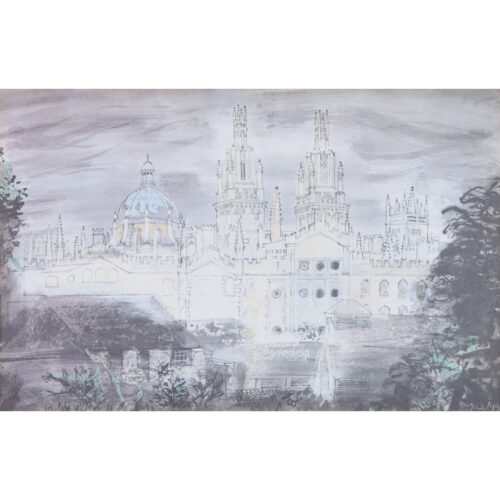
after John Piper (1903 - 1992)
View from the Upper Common Room, The Queen's College - Oxford Almanac 1972 (cropped)
Lithograph 17 x 26 cm A lithograph featuring Oxford's skyline, including the towers of All Souls and the Radcliffe Camera, set against a blustery Piper sky. Piper's painting was reproduced as a lithograph in 1972, to be published in the "Oxford Almanack". The Oxford Almanack was an annual almanac published by the Oxford University Press for the University of Oxford from 1674 through 2019 (when printing sadly ceased due to "dwindling interest"). The almanac traditionally included engravings or lithographs of the University and information about the upcoming year. Other almanac artists have included James Basire, Michael Burghers, J. M. W. Turner, and Michael Oelman. John Piper CH was an English painter, printmaker, and designer of stained-glass windows. His work often focused on the British landscape, especially churches and monuments, and included tapestry designs, book jackets, screen-prints, photography, fabrics and ceramics. Condition: very good. If you are interested, please email info@manningfineart.co.uk or call us on 07929 749056. Click here for other views of All Souls. -
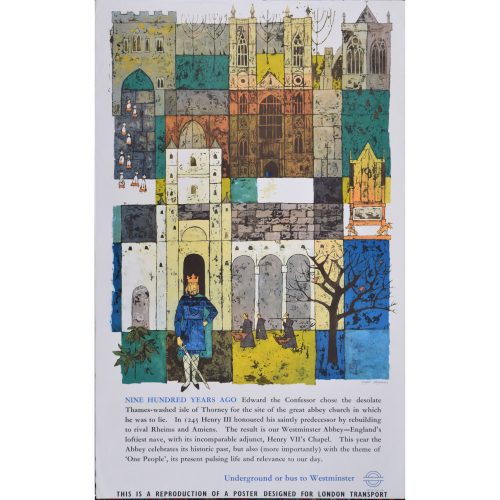
Gaynor Chapman (1935-2000)
Nine Hundred Years Ago
1966 Lithographic poster for London Transport From the original printing but sold at the time in the London Transport poster shop hence overprinted 'This is a reproduction of a poster designed for London Transport." 101×63.5cm Chapman attended the Epsom School of Art and the RCA where she studied illustration and graphics. Her posters for London Transport are amongst her best works. If you are interested email info@manningfineart.co.uk or call us on 07929 749056. -

Sir Hugh Casson (1910-1999)
Magdalen Bridge Oxford
Lithographic print unsigned. Provenance: the artist’s estate. 28 x 35 cm (11 x 14 in) From Casson’s ever-popular Oxford series of prints. If you are interested email info@manningfineart.co.uk or call us on 07929 749056. For biographical details and other works by the artist click here. -
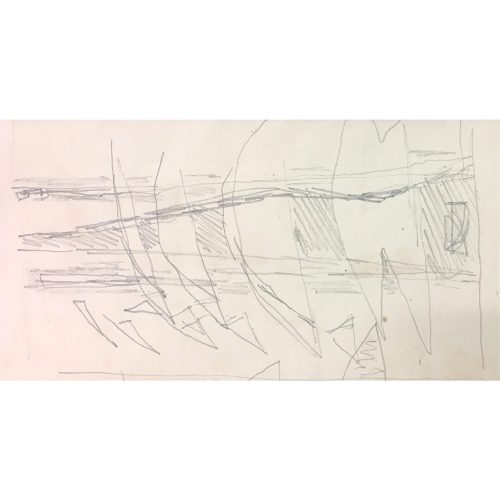
Clifford Ellis (1907-1985)
Sketch for Sailing Boats I
Pencil 9x17cm Provenance: the family of the artist, by descent. Click here for biographical details and other works by the artist. If you are interested email info@manningfineart.co.uk or call us on 07929 749056. -

Henry Cliffe (1919-1983) Constellations II
Etching Mid 20th Century 16x24cm Click here for biographical details and other pictures by the artist. If you are interested email info@manningfineart.co.uk or call us on 07929 749056. Condition: Good. -
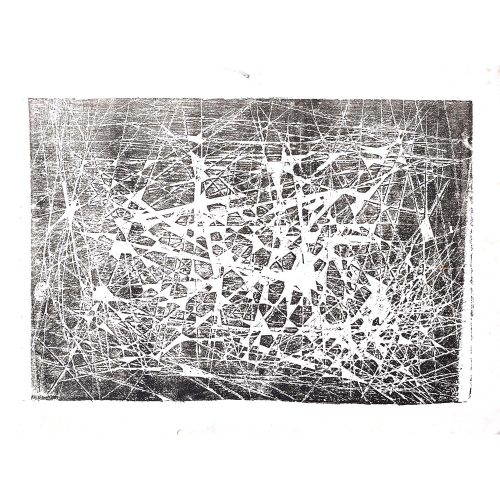
Henry Cliffe (1919-1983) Constellations I
Etching Mid 20th Century 9x16.5cm Click here for biographical details and other pictures by the artist. If you are interested email info@manningfineart.co.uk or call us on 07929 749056. Condition: Good. -
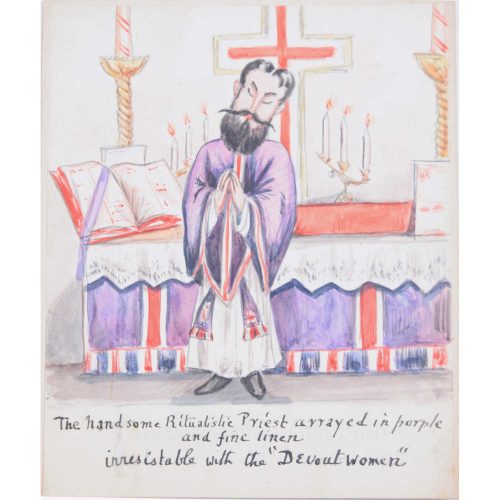
Anonymous, c.1850
'The handsome Ritualistic Priest, arrayed in purple and fine linen irresistible with the "Devout Women"' Caricature
Pen, ink and watercolour 20 x 24 cm By repute this item was found in the rooms of John Keble (1792-1866) at the Hermitage Hotel in Eastbourne after his death in 1866, together with another caricature watercolour of the 'Cotton-ia Worcester-ienisis' which we also have for sale. Condition: Generally very good, slight toning to paper. -
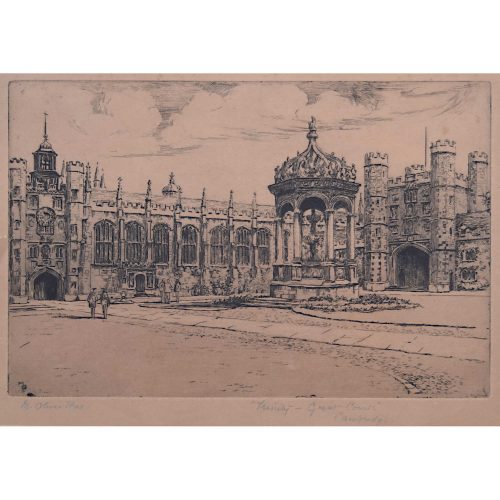
Mabel Oliver Rae
Great Court, Trinity College, Cambridge
Etching, circa 1920 20 x 27cm Signed lower left. Mabel Oliver Rae was born in Cambridge, Cambridgeshire, and trained at the Slade School of Fine Art between 1888 and 1890. Rae is known for her skilled etchings of various rural scenes and townscapes, particularly those of the colleges of Oxford and Cambridge. She signed works with the pseudonym 'M.Oliver Rae', a ruse to conceal the fact she was a female artist, so as not to reduce her chances with commercial dealers and agents. Condition: Generally very good, slight discolouration to margins - which will not be visible under mount.

